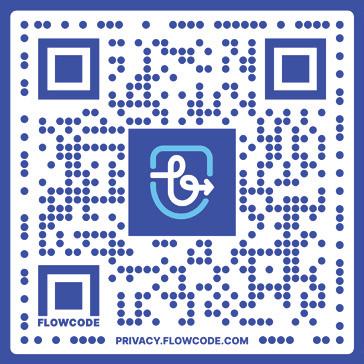New student Guide 2025












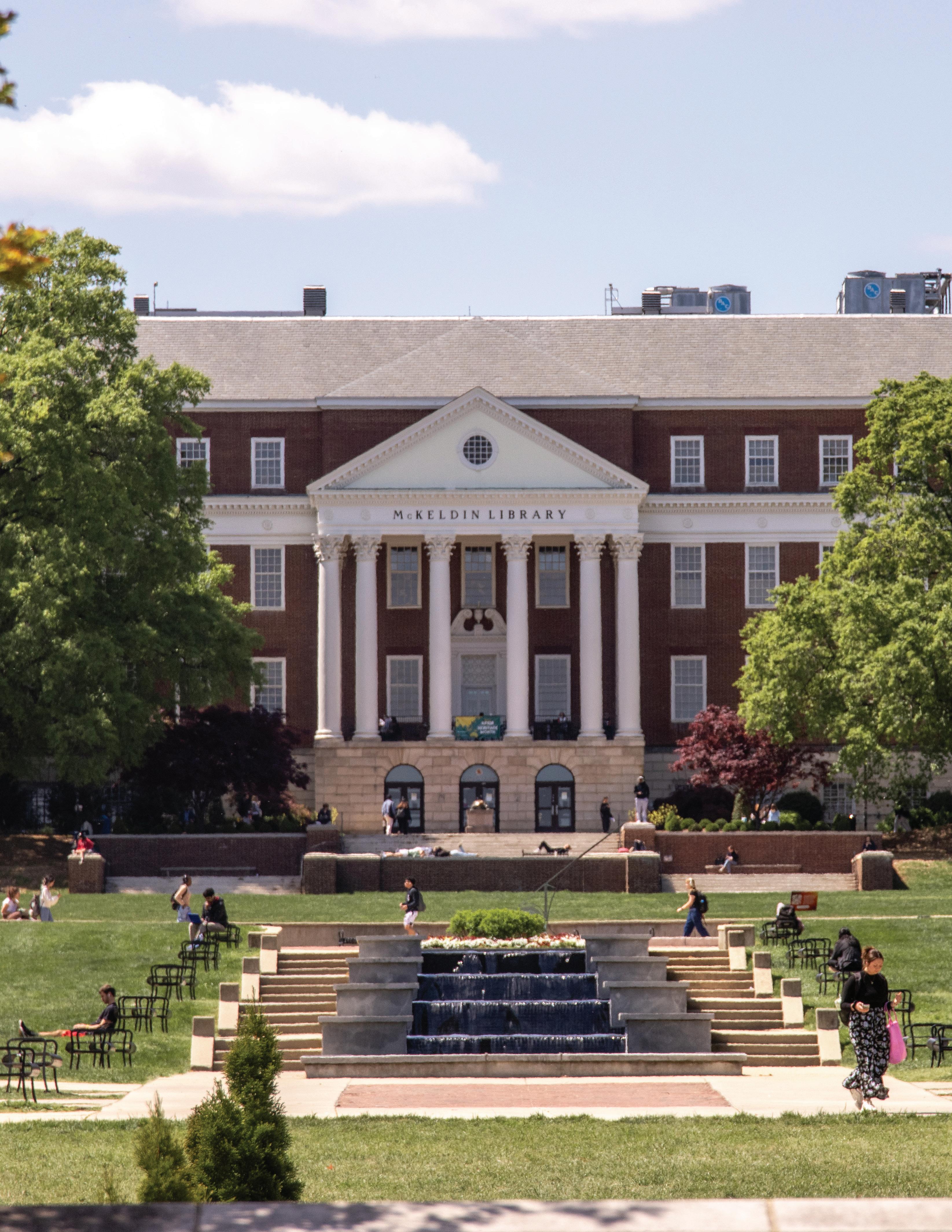
Welcome to umd
Dear reader,
Congratulations on your admission to the University of Maryland and welcome to College Park! You’re about to step foot into a whole new world of freshman dorms, dining hall dishes and late-night study sessions at McKeldin Library, and we know it can be intimidating. The Diamondback put together this handy New Student Guide to answer all your burning questions, from how to tailgate a Terps football game to the best spots to grab a bite while you’re dashing to classes on South Campus. We hope your first year here in College Park is full of new friends, exciting classes and not too many boxes of Marathon Deli fries. As you pack up your bags and order your mattress topper (really, you need one), remember that you’ve got this. There’s a plethora of opportunities that await you. Good luck!

3150 S. Campus Dining Hall, College Park, Md., 20742 (301) 314-8200 https://dbknews.com/contact-us/
Adam Hudacek
ADVERTISING: ads@dbknews.com (301) 276-5770
Job openings: https://dbknews.com/jobs/ Newsletter: https://ter.ps/DBKNL
ORIGINAL
Sofia Appolonio
Sam Cohen
Lauren Frank
Mónica Godnick
Keira Hardesty
Amanda Hernandez
Adam Hudacek
Cameron Lee
Talia Macchi
Oliver Mack
Pera Onal
Nicole Pilsbury
Harrison Rich
Katherine Schutzman
Amelia Twyman
Sanya Wason
Joe Wicke
Miguel Zarate
Lizzy Alspach
Olivia Borgula
Randy Chow
Natalie Jakubiak
Alexa Taylor





2025 - 26 academic calendar
Visit the o cial UMD Academic Calendar for more information at academiccatalog.umd.edu/about-university/academic-calendar/semester-calendar!
FALL 2025
Sept. 2 — First day of classes
Oct. 13-14 — Fall Break
Nov. 26-30 — Thanksgiving
Recess
Dec. 12 — Last day of classes
Dec. 13 — Reading day
Dec. 15-20 — Final exams
See commencement.umd.edu for any updates
winter 2025-26
Jan. 5 — Classes begin
Jan. 19 — Dr. Martin Luther King
Jr. Holiday
Jan. 23 — Classes end
spring 2026
Jan. 26 — First day of classes
March 15-22 — Spring Break
May 8 — Last day of classes
May 9 — Reading day
May 11-18 — Final exams
May 19-22 — Commencement (college/department ceremonies)
May 20— Commencement (main ceremony)
summer 2026
June 1 — Sessions I and I-A begin
June 18 — Session I-A ends
June 19 — Juneteenth Holiday
June 22 — Session I-B begins
July 3 — Independence Day holiday
July 10 — Sessions I and I-B end
July 13 — Sessions II and II-C begin
July 31 — Session II-C ends
Aug. 2 — Session II-D begins
Aug. 21 — Sessions II and II-D end
Stylish. Convenient.
tylish.
Eco-Friendly.
ambria a
Cambria College Park seamlessly blends warmth and comfort with stylish, modern accommodations. Within a short walking distance of the University of Maryland, this LEED-certified hotel is the ideal location when visiting the area It’s also the perfect place to host business meetings and special events.
also OOM
ROOM AMENITIES FOR A COMFORTABLE STAY



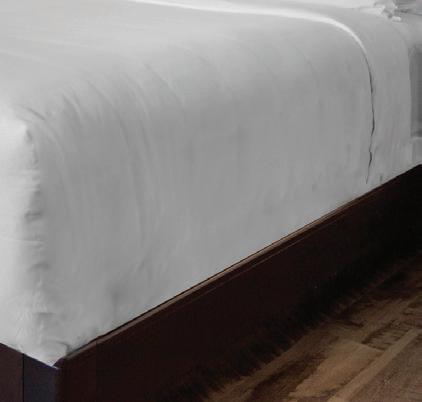


luetooth ini
Bluetooth bathroom mirror
Mini refrigerator, microwave and Keurig machine
esk
Desk with ergonomic chair, USB and power outlets
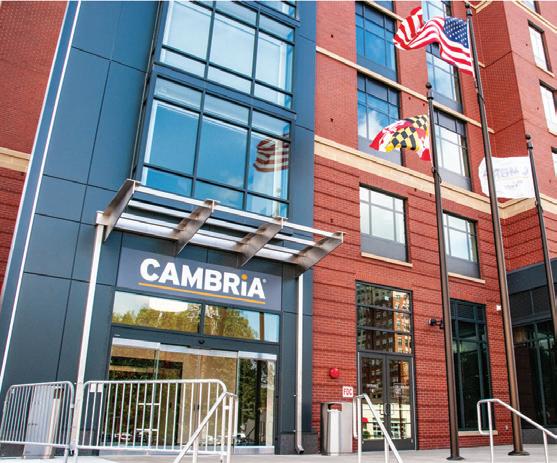

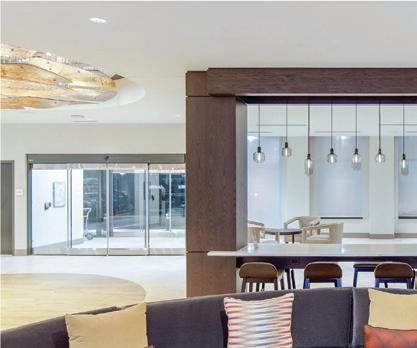

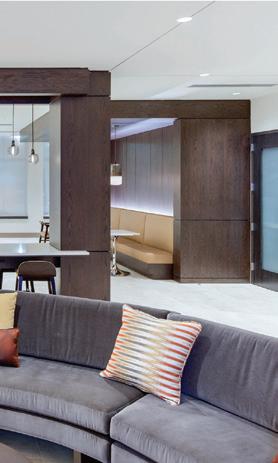
Complimentary Wi-Fi
omplimentary
EA URES
FEATURES TO MAKE YOUR STAY MORE ENJOYABLE
tate-of-the-art
State-of-the-art fitness center, equipped with the latest cardio machines, free weights and exercise equipment
PrimeTime open for breakfast, lunch and dinner
Garage parking with EV charging stations
Dog-friendly
rimeTime og-friendly


rimeTime cuisine and comfort food favorites crafted
PrimeTime is a one-of-a-kind vintage sportsthemed restaurant that blends upscale Americana with a retro, artistic homage to sports history. Indulge in innovative, American cuisine featuring steaks, seafood and comfort food favorites crafted with quality ingredients in a welcoming ambiance, rooted in nostalgia.


8321 Baltimore Avenue College Park, MD 20740
301.595.2600
CambriaCollegePark.com
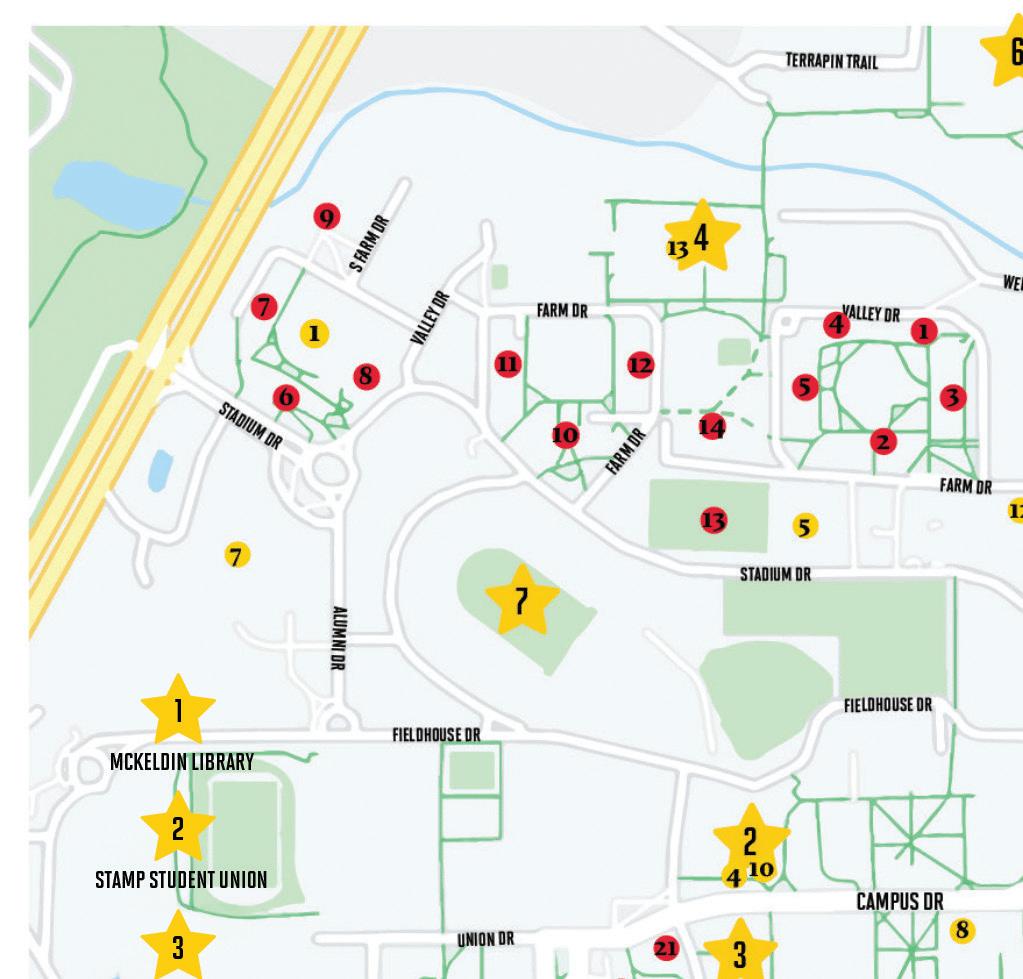
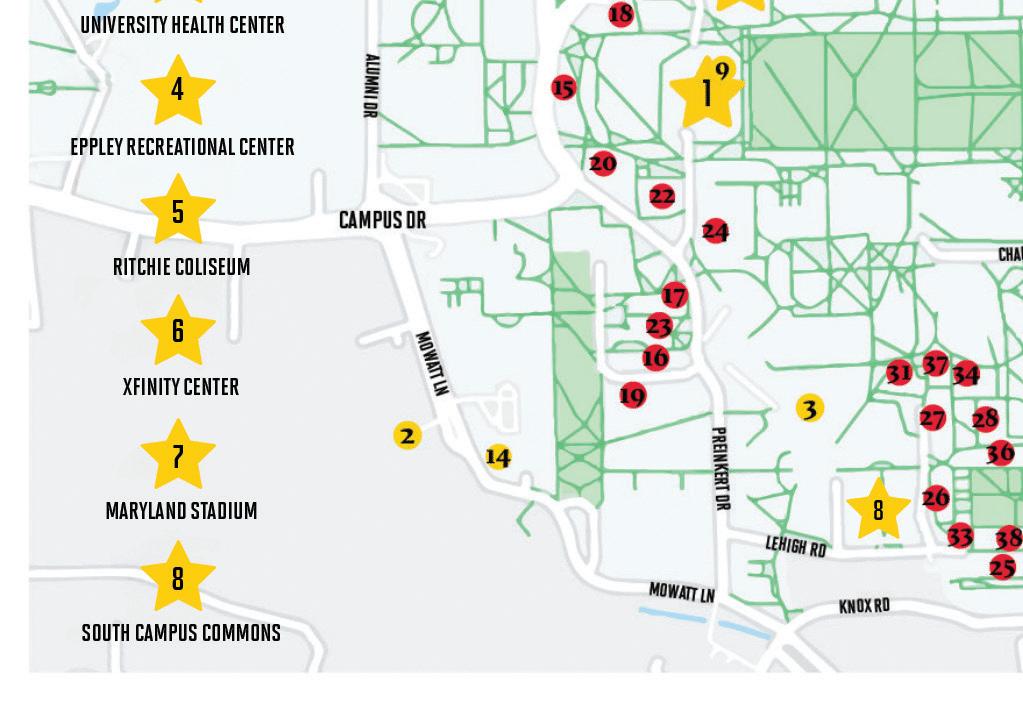

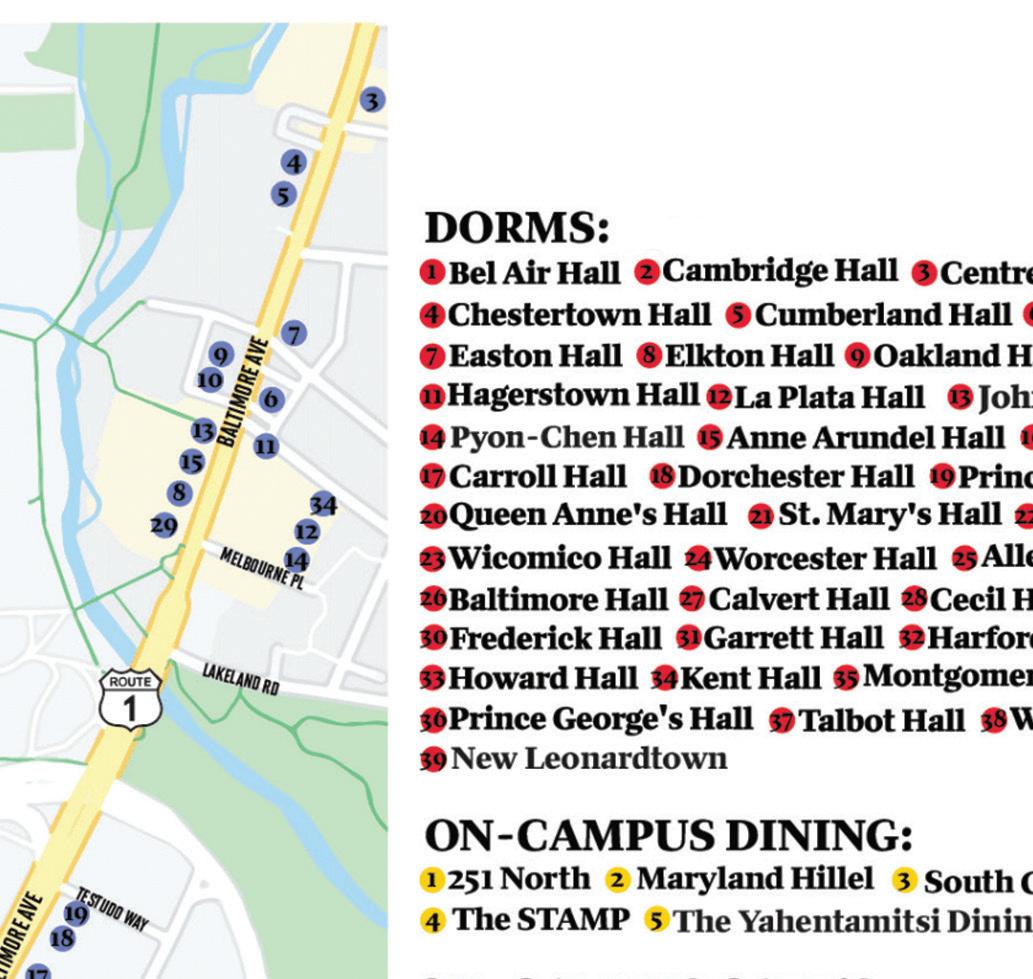
CAMPUS MAP
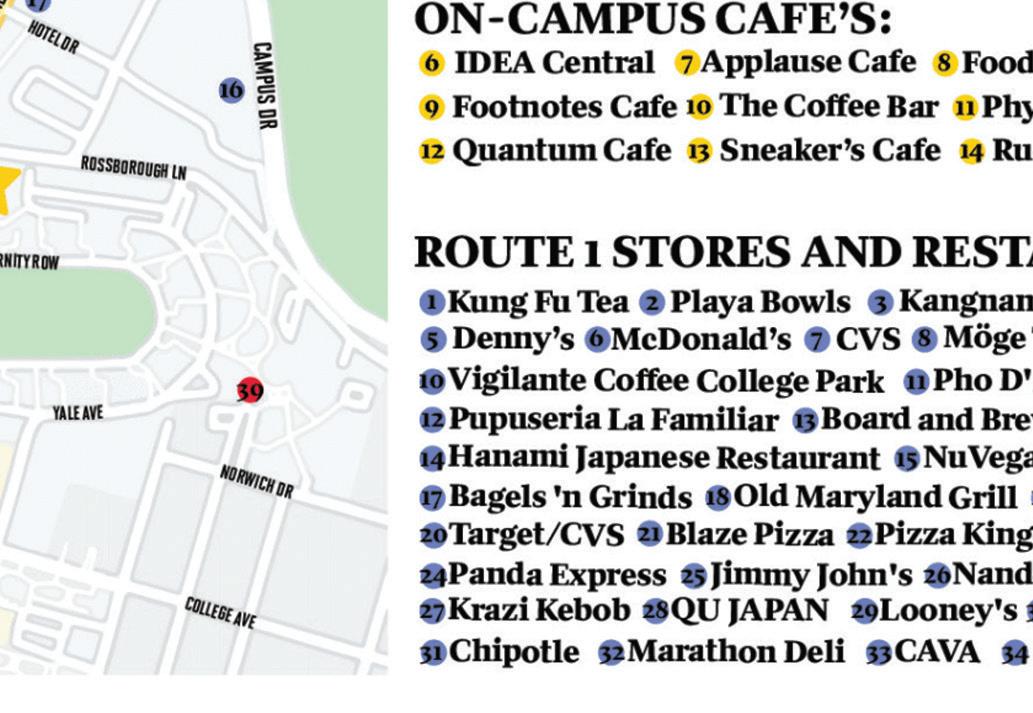

staying safe in college park
There are plenty of resources available to help you take the extra steps to stay safe in College Park.
UNIVERSITY POLICE
Emergency: 911 or 301-405-3333 University of Maryland Police o cers patrol the city alongside the campus because College Park doesn’t have a designated police department. Give this number a call to report emergencies or crime.
Non-emergency: 301-405-3555 The police escort service is available to anyone who feels unsafe at any time. Call the nonemergency police number to access police o cers and student members of the police auxiliary service who will walk with you across campus.
UMD ALERTS
UMD Alerts are sent out when there’s a report of an emergency or a crime on or near the campus. The alerts also cover weatherrelated closings and events that can impact the university community. As a student, you’re automatically signed up to get UMD Alerts through your email. If you prefer text messages, you can register your phone number at alert.umd.edu.
ON-CAMPUS RESOURCES
Blue Light emergency phones are located all over campus. They provide a direct connection to the University of Maryland Police Department and can be used during emergencies at any time. A map of the Public Emergency Response
Telephones (PERT) can be found on this map.
NITE Ride: 301-314-3687
If you don’t feel safe out at night, NITE Ride can pick you up and take you anywhere on campus free of charge. From 5:30 p.m. to 2:30 a.m., it runs only to designated locations on campus. From 2:30 a.m. to 7:30 a.m., it picks up and drops o to areas of campus that are not covered by Shuttle-UM. The service is provided by the Department of Transportation Services seven days a week. The NITE Ride service map shows designated pick-up and drop-o locations here.
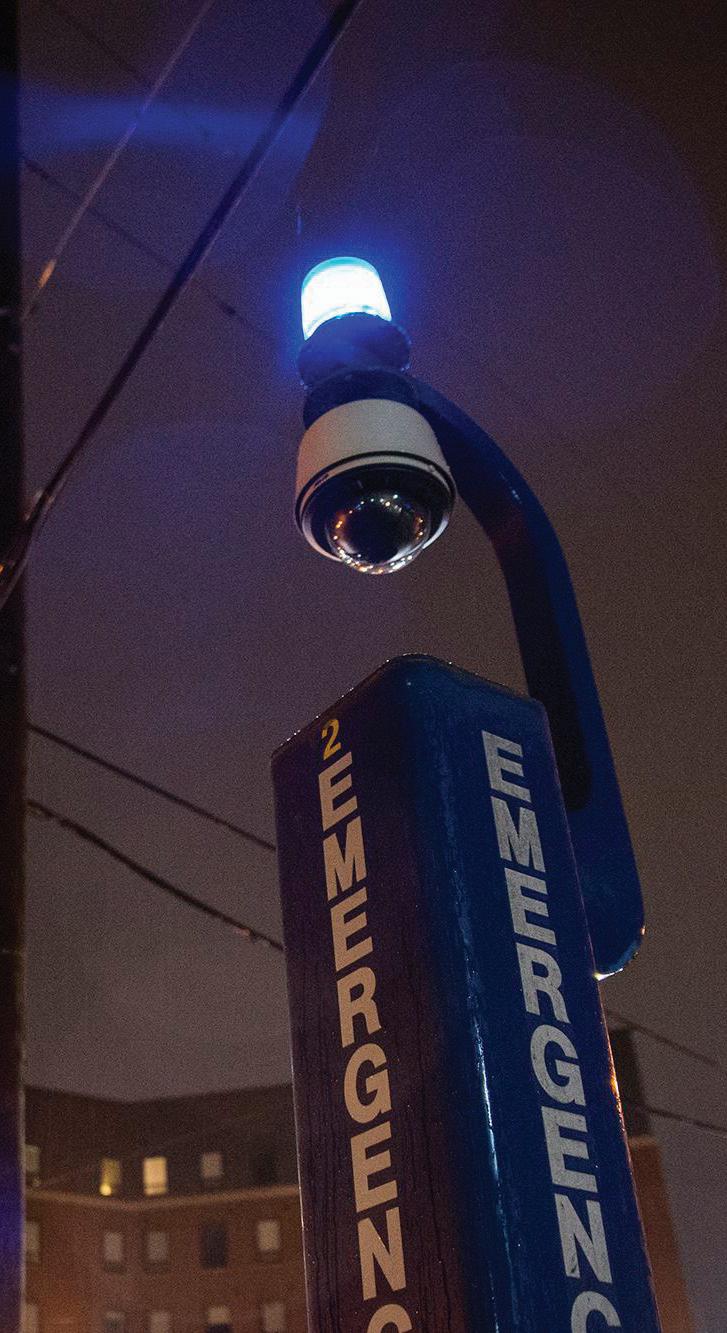
MENTAL HEALTH RESOURCES
The Counseling Center: 301-3147651
Counselors are available for therapy sessions, and the center provides psychological evaluations and consultations. Students are limited to eight individual sessions per 12-month period. The center also provides wellness workshops and group counseling as well.
The University Health Center’s Behavioral Health Services: 301314-8106
Psychiatrists, psychiatric nurse practitioners and psychotherapists can meet with students to o er them psychiatric evaluations or care. The center can also connect you to another psychiatric provider outside the university.
CARE to Stop Violence: 301-3142222
24-hour hotline: 301-741-3442
Campus Advocates Respond and Educate to Stop Violence educates students about domestic and sexual violence and works with victims.
CARE to Stop Violence can help with everything from counseling and advice to providing educational workshops for you to learn more about responding to violence.
This article is part of The Diamondback’s 2020 Orientation Guide. Some information and resources have been updated to reflect current dates and events.
terrapin transport
The University of Maryland’s campus is pretty walkable, but sometimes you need to leave College Park — or maybe you just don’t feel like traveling on foot after a long day of classes.
Here are some alternative ways to get around.
Ride campus buses
The Department of Transportation Services’ Shuttle-UM has one of the most expansive shuttle bus systems in the nation, with more than 20 routes. Not only can these buses take you all around campus, but they also go anywhere from The Varsity and the University View apartments to Hyattsville and Silver Spring.
Most on campus buses run several times an hour after 5:30 p.m., with o -campus bus schedules varying. You can see bus maps and times on dots.umd.edu and track your bus in real time with the Transit app.
Hop on the Metro
Although College Park has a lot to
o er, sometimes you just need to go to Washington, D.C. Luckily, getting there is easy. The #104 bus will take you to the College Park Metro station, which is also walkable and bikeable from campus. Once you get to the Metro, you’re just a quick ride away from the National Zoo, the Smithsonian museums, the National Mall and more.
Bring a bike
Biking is a great way to get across campus when you want to get somewhere a bit faster than walking. You can use your own bike on campus if you register it with DOTS (it’s free!) at bikeindex.org/umd.edu. Be careful not to break the rules, though — don’t bike on the sidewalk and don’t leave your bike on a rack for more than 72 hours.
Rent a bike or scooter
The city of College Park, in partnership with VeoRide, debuted a scooter and bike-share program in 2019. The program brought electric scooters, as well as both electric and regular bikes, to campus.
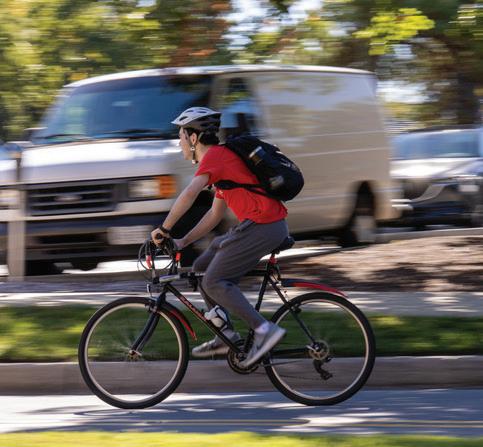
Through the VeoRide app, you can unlock a device and start riding. To rent, you’ll have to pay an unlock fee, plus a fee per minute. The price depends on what kind of device you choose to hop on.
Renting a scooter or bike is a big help if you’ve got class on the other side of campus or you don’t have the time to wait for a bus. Just make sure you ride safely and responsibly. Stick to the roads and stay o the sidewalk.
If you own a private e-bike or e-scooter, you’ll have to register it with DOTS.
Take a Zipcar
When you need a longer-term rental, Zipcars are another transportation option. Members can rent vehicles by the hour or by the day. Once you register through the app, you can access Zipcars all around the country, not just in College Park. Drive, but beware of parking.
Parking can be a bit tricky. All students are eligible to register for on-campus parking, and registration dates vary on a rolling basis according to credit level starting at the end of July.
Registration isn’t cheap, either. For the 2024-25 academic year, annual parking permits were $701 for resident students and $362 for commuter students, increasing to $901 for overnight storage parking. There are numerous lots and garages on campus, each with their own rules and restrictions. If you get a permit, you’ll want to make sure you’re parking in the right place, or else you risk getting a ticket.
Many parking lots may close or adjust the number of available spaces with all of the construction going on, so be sure to check the DOTS website and The Diamondback for updates.
This article is part of The Diamondback’s 2020 Orientation Guide. Some information and resources have been updated to reflect current dates and events. a cyclist passes by the Skinner Building on Oct. 9, 2024. (Sam Cohen/The Diamondback)
UMD FUN FACTS
You can see the Washington Monument from the top of SECU Stadium.
UMD has six — count ‘em, six — libraries on campus.
McKeldin Mall on April 30, 2025. (Christina Duncan/The Diamondback)
McKeldin Mall is considered the largest collegiate mall in the country!
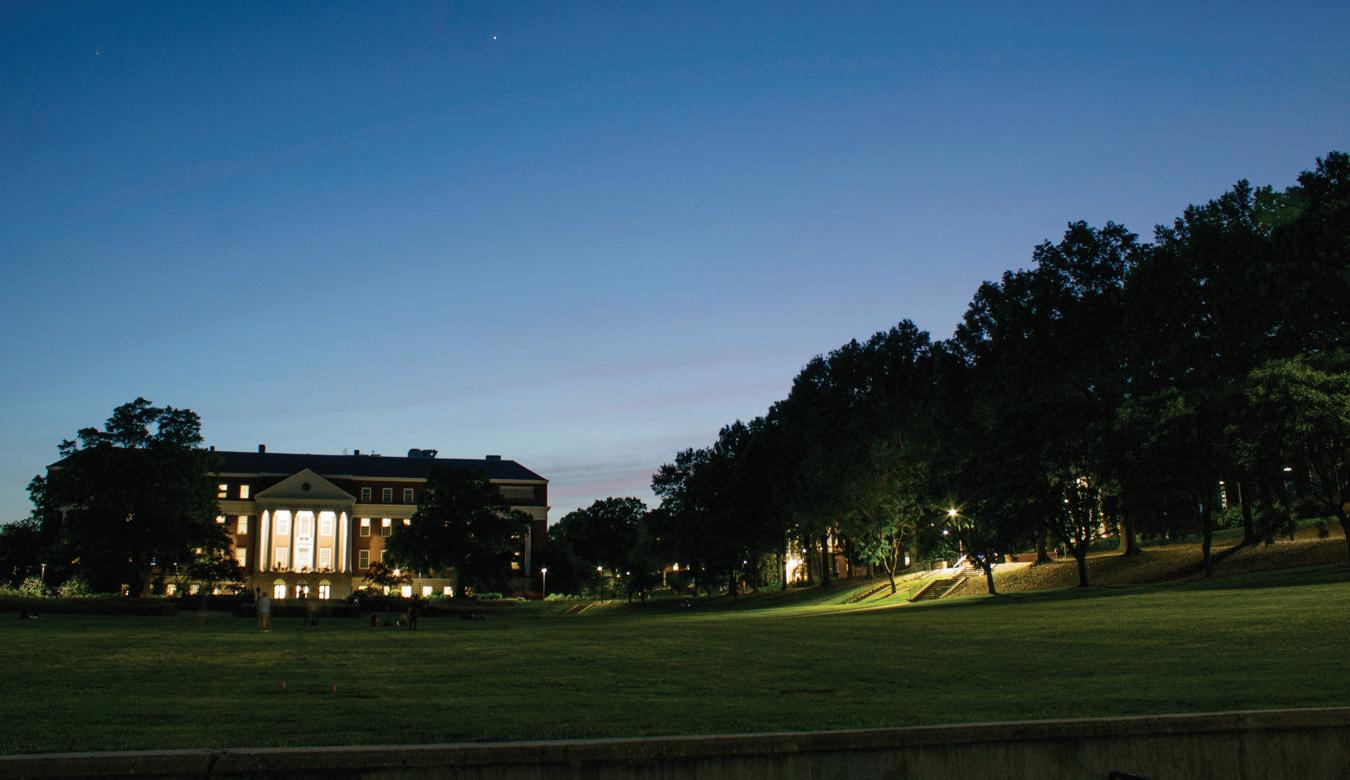
UMD has its own farm! It’s featured a lot of cool stu over the years, like a living cow with a hole in it.
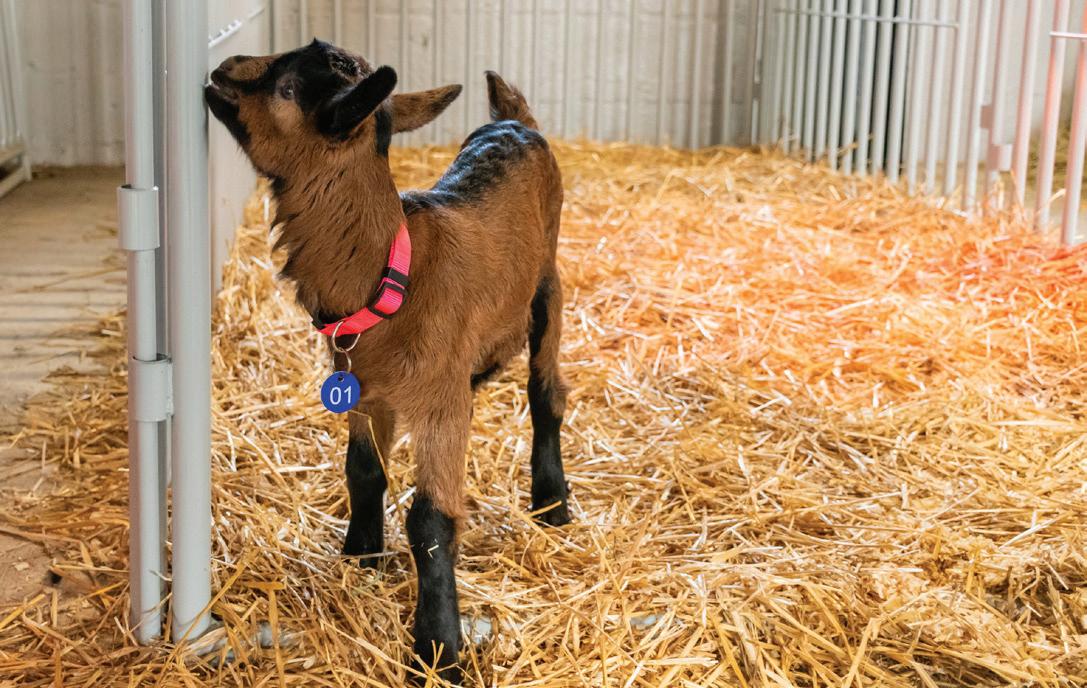
a baby goat explores around her pen at the Campus Farm on April 18, 2025. She’s was born this semester as a part of the animal sciences program. (Gurnoor Sodhi/The Diamondback)
There’s a spot on campus that is supposedly cursed — if you step on the Point of Failure, you won’t graduate in four years. 5
UMD researchers made a computer that can beat Jeopardy! winner Ken Jennings.
In 2011, Maryland fans were named one of the worst fan bases in the U.S. due to repeated riots after basketball games.
Part of the music video for Hootie and the Blowfish’s song “Only Wanna Be With You” was shot at the Reckord Armory.
Morrill Hall is the only academic building that survived the 1912 Great Fire, making it the oldest academic building on campus.
Queen Elizabeth II of England attended her first American football game at UMD.
The Maryland men’s basketball team won the 2002 National Championship, and the women’s basketball team won the national title in 2006.
More than 100 couples get married in the chapel on campus every year.
Some of NationalTreasure:BookofSecrets was shot on McKeldin Mall, and part of St. Elmo’sFire was filmed on Fraternity Row.
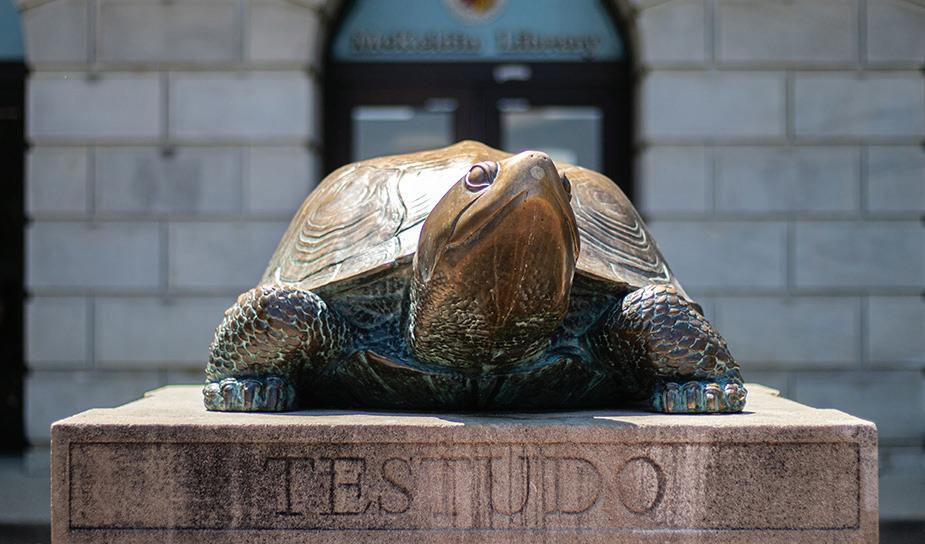
There are seven di erent Testudo statues around campus.
The testudo statue outside of McKeldin Library. (Julia Nikhinson/The Diamondback)
People leave o erings to the Testudo statue in front of McKeldin Library for good luck on their finals. One time, things got out of hand and Testudo caught on fire
The Testudo statues on campus are based on an actual Diamondback Terrapin, whose taxidermied body is in the University Archives.
terpS sports recap
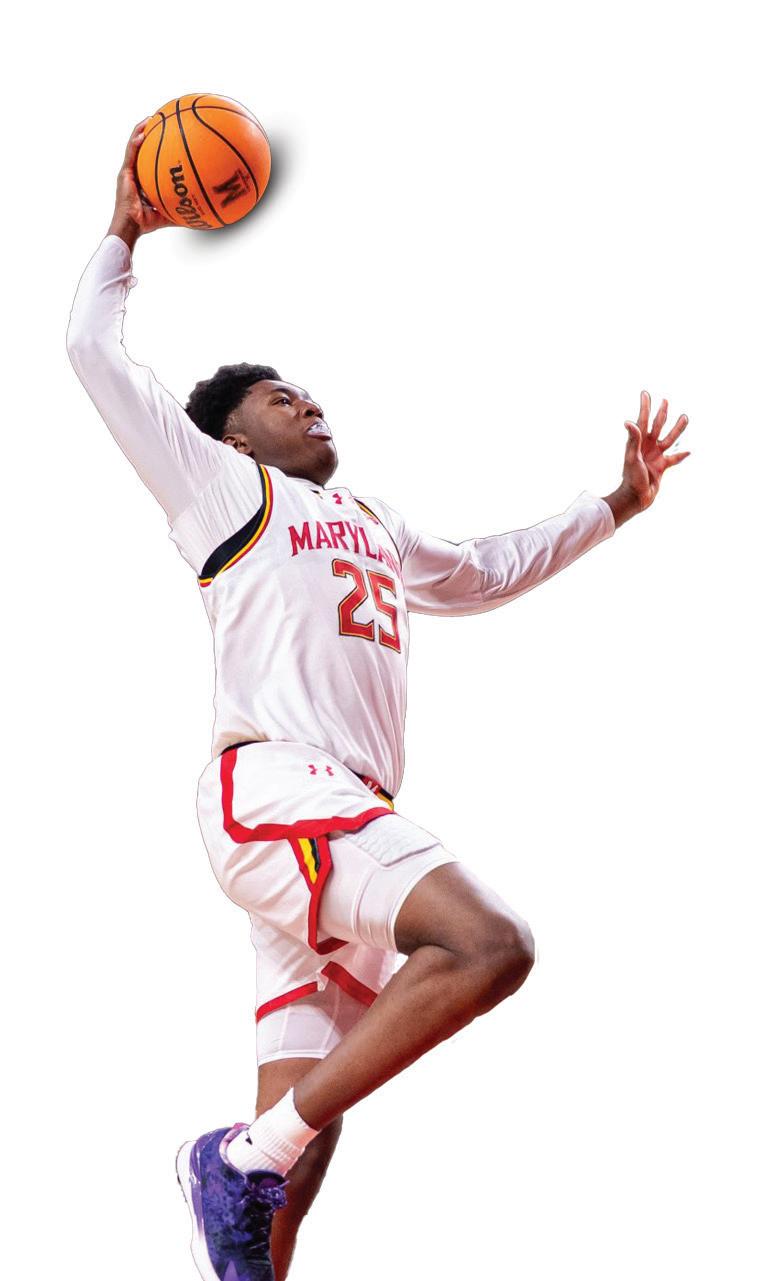
By Harrison Rich | Sportseditor,men’sbasketballreporter
In the 2024-25 academic year, the Terps lost their athletic director, endured a miserable football season and had a historic basketball season before the coach of the men’s team departed.
performance in coach Michael Locksley’s first season — and faced inconsistencies along the o ensive line and in the secondary.
But there’s renewed hope looking ahead to next season. According to 247Sports, Locksley brought in a top-25 recruiting class headlined by Maryland Gatorade Player of the Year and four-star quarterback Malik Washington. But he also lost last year’s starting quarterback, Billy Edwards Jr., to Wisconsin in the transfer portal, along with a slew of other key contributors from a season ago.
Maryland and Locksley are hoping for a much-needed bounce back season after one in which the coach said he lost the locker room for the first time in his career. Washington and UCLA transfer Justyn Martin will likely battle it out for the starting job in fall camp.
spotlight was taken when former coach Kevin Willard expressed the need for “fundamental changes” in the men’s basketball program during an NCAA tournament press conference. His comments sparked rumors throughout the postseason run, ending in him taking a head coach job at Villanova at the season’s end before Maryland hired former Texas A&M coach Buzz Williams as his replacement just days later and quickly rebuilt its roster.
Women’s basketball also turned in a successful season, winning six of its last seven regular season games and 25 overall. The Terps won a thrilling double overtime game over Alabama in the NCAA tournament second round, then lost to No. 2-seed South Carolina in the Sweet 16.
In the fall, Maryland football regressed after winning three straight bowl games for the first time in program history.
The Terps won just a single Big Ten contest — their worst conference finish since a 1-8
Like football, no other fall sports found much success. But in the winter, the men’s and women’s basketball teams both made the Sweet 16 for the first time in school history, while wrestling and gymnastics each took strides toward national relevance.
Derik Queen was the star of the men’s basketball season. The fivestar freshman from Baltimore took the fanbase by storm for his unique playstyle, baby-faced joy and witty humor.

The pinnacle of the Terps’ season — and his — came when Queen hit a buzzer-beater in the NCAA tournament second round to send Maryland to its first Sweet 16 since 2016. Queen became nationally known and declared for the NBA draft in April.
But much of his
Guard Shyanne Sellers was selected with the 17th pick in the WNBA draft — before she was later waived and signed by the Atlanta Dream — and coach Brenda Frese restocked her team with three transfers and three freshmen.
In the spring, both lacrosse teams turned in strong seasons, making the NCAA tournament as top seeds. The women’s team made the tournament for a nation-leading 35th straight time, while the men’s squad made its 22nd straight, also an NCAA best.
Baseball and softball struggled. Both teams missed the NCAA tournament for the second consecutive season in their coach’s second years at the helm.
what to know about terp game day
Sports can be one of the most exciting parts of college, and at the University of Maryland you’ll get a game day experience that’s hard to beat. Here’s how to get the most out of your trip to the stadium.
TAILGATES
For every home football game, the campus is crowded with fans of all ages. You’ll want to take part in the revelry at a tailgate, and there are plenty of options to choose from.
The IFC tailgate
The Interfraternity Council tailgate is limited to people with wristbands and held near Lot 1. If you can get access, there’s lots of food, drinks and games to enjoy before the game.
Terp Up in for Game Day
Two hours before every home game, La Plata Beach turns into a huge tailgate zone with games and giveaways.
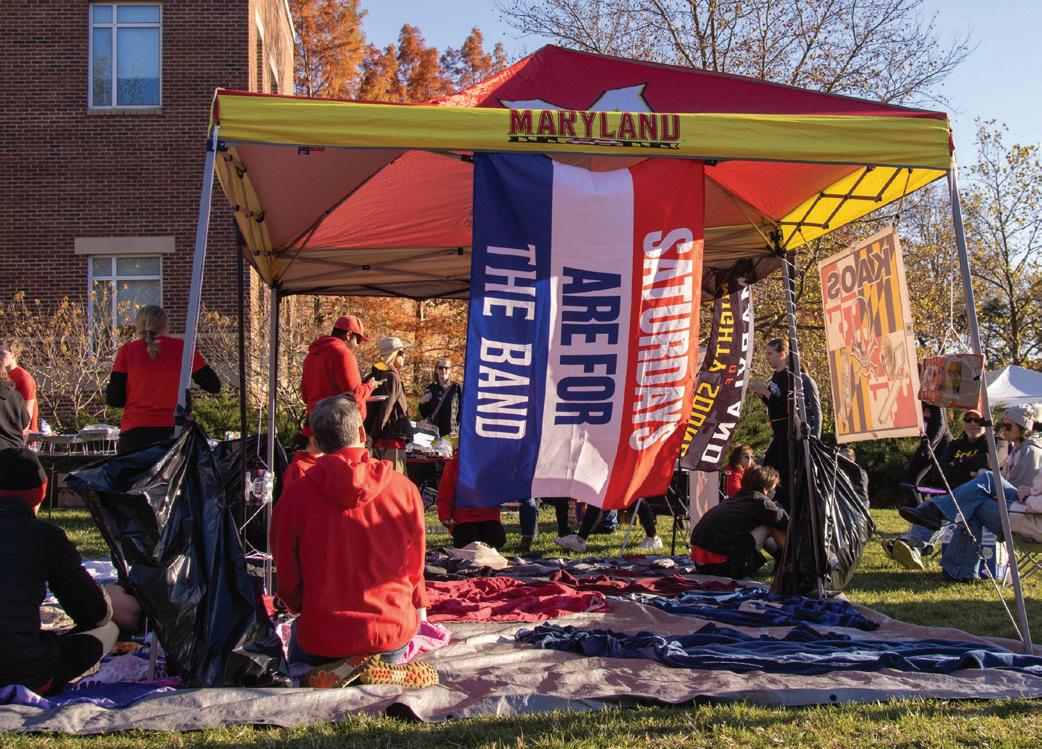
Host your own
Parking on campus isn’t cheap, but if you’re able to swing a spot on Saturday, you might as well bring a grill and some burgers. Check out the tailgate rules so you don’t get in trouble — you won’t be able to watch the game if you’re booted from campus. Also, make sure to BYOF (Bring your own food), as no tailgate is complete without a few snacks. Concessions are sold within the stadium, but when you’re preparing for a multi-hour game, it’s
always smart to have a bite to eat before you head in. It might even save you a few bucks!
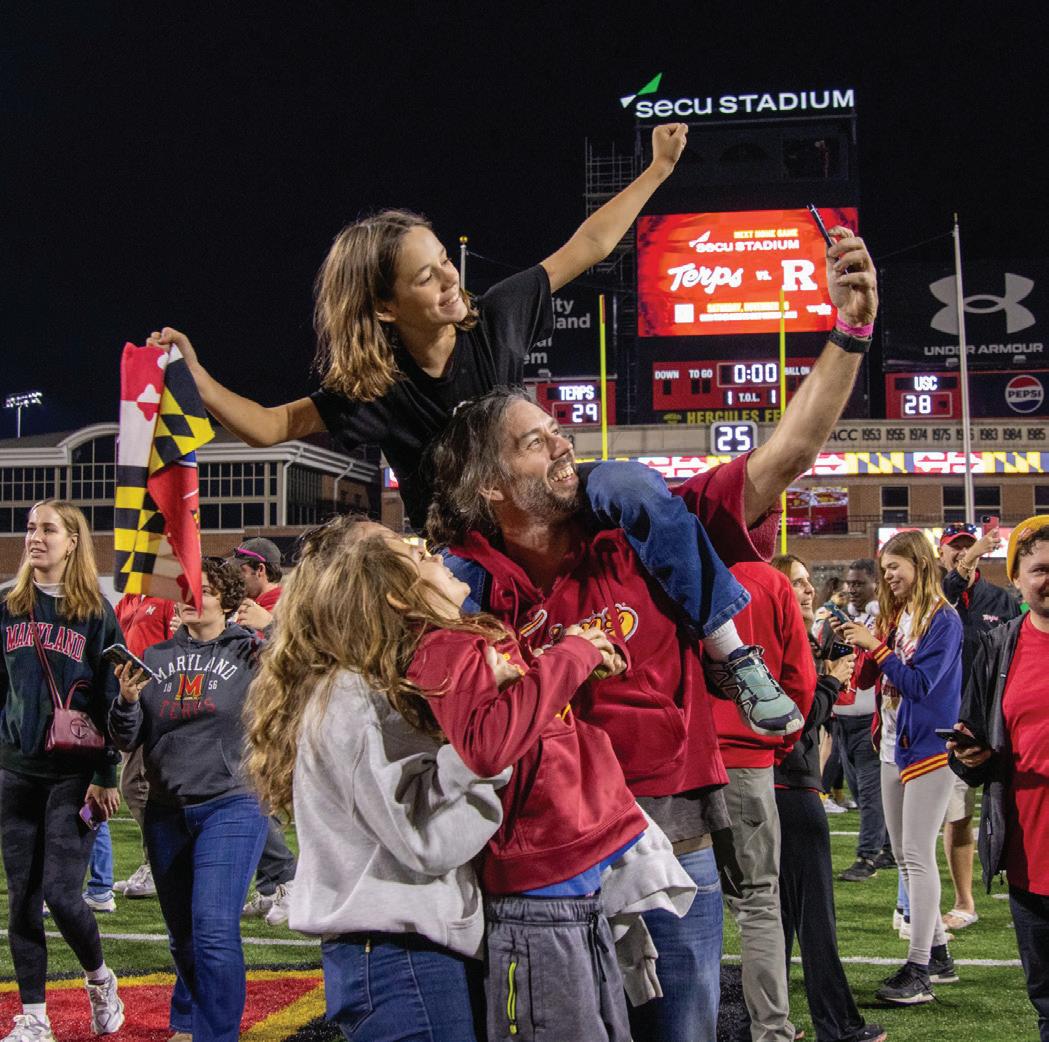
THE FAN EXPERIENCE
The crowd
At any Maryland sports game, whether it’s against a Big Ten rival or an uninspiring mid-major foe, you’ll be among a boisterous crowd that isn’t afraid to get in on the action. From chants and songs to creative signs and coordinated antics, everything goes when the Terps are playing. It’s deafening, it’s vulgar and it’s among the best things you’ll experience here.
The flash mobs
Since 2011, one Maryland’s basketball game a year has featured a flash mob. You’ve probably seen the videos — the entire arena is in sync, wearing the same thing and moving the same way as the music pounds. Get to the game a couple hours beforehand to learn the choreography and you can take part in this experience.
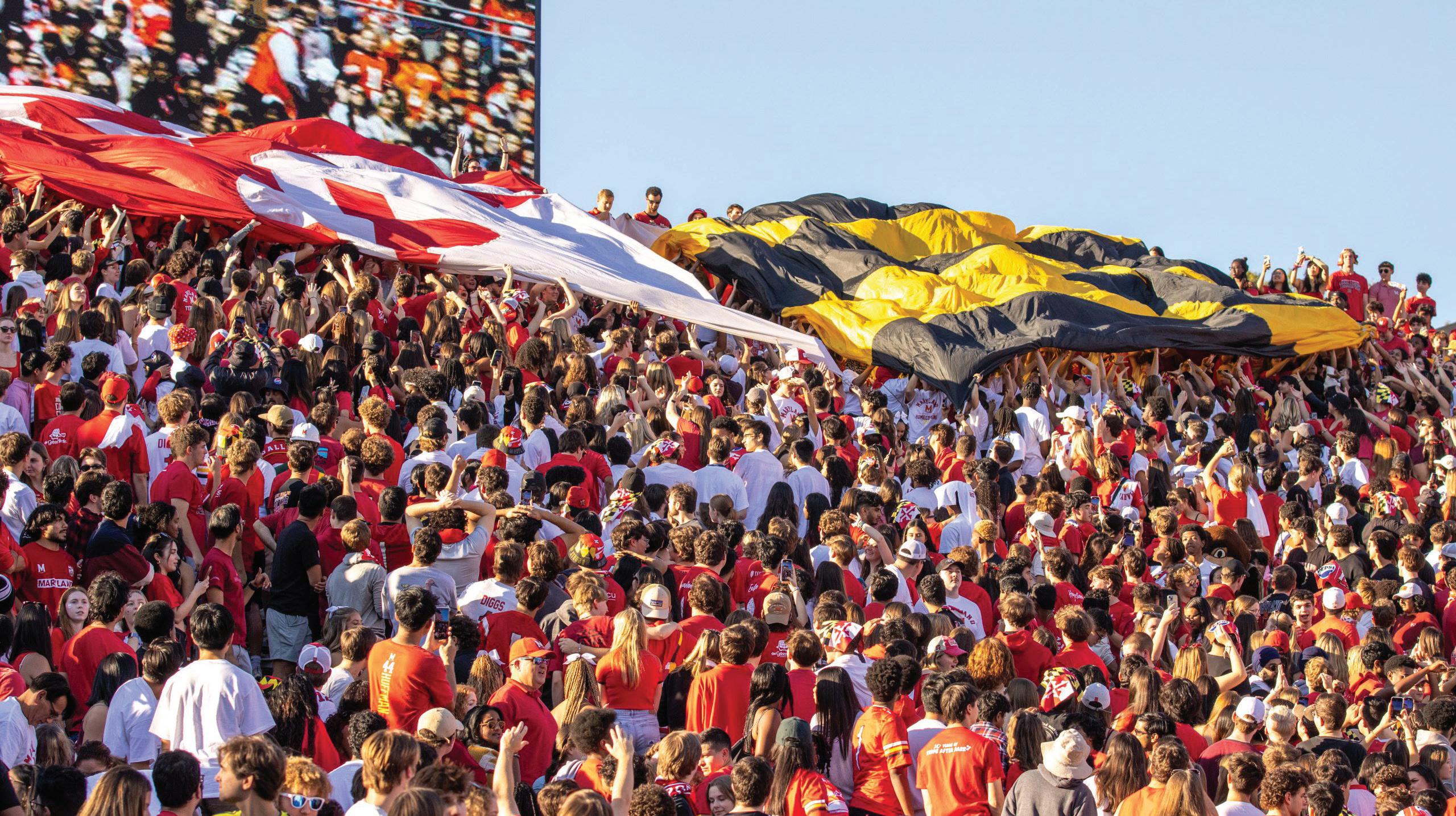
The Maryland flag
If you start to hear the theme from 2001: A Space Odyssey, you’re about to take part in maybe the best tradition Maryland has to o er. During home games for football and men’s basketball, a massive Maryland flag is unfurled across the student section. When it comes to you, do your part for Maryland pride — hold it up and pass it along. And don’t worry — it won’t be there for too long.
STUDENT TICKETS
For sports such as football and men’s basketball, student tickets can disappear quickly, so you’ll want to be ready to claim them. To set up your account for student tickets, go to umterps.com/student.
Pay attention to your email. You’ll get a message for the start of each request period, which is the time you can request a ticket for a given game. When putting in your order for a ticket, make sure to select “Mobile PDF Delivery.” That way, you can have it stored on your phone instead of printing it out. And this should go without saying, but if you get a ticket, use it! It’ll help you build up loyalty points, giving you a better shot of getting more in-demand tickets in the future.
GIVEAWAYS
If you go to enough sporting events at Maryland, you’re going to get a lot of free stu . T-shirts are the most common
giveaway, and for every straight forward design, there’s a wacky outside-the-box one, like the football T-shirts featuring Testudo memes. There’s plenty of other stu too, such as bobbleheads, beanies, scarves and even capes. Be on the lookout for emails promoting a giveaway and get to the stadium on time. The freebies won’t be around forever.
This article is part of The Diamondback’s 2020 Orientation Guide. Some information and resources have been updated to reflect current dates and events.
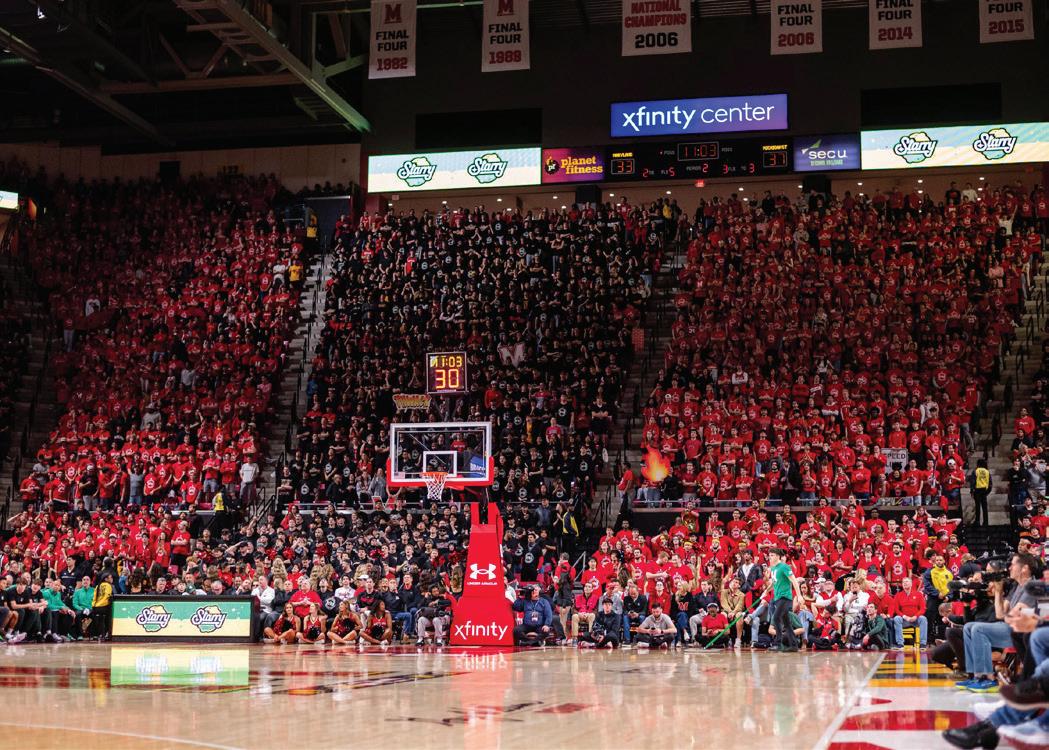

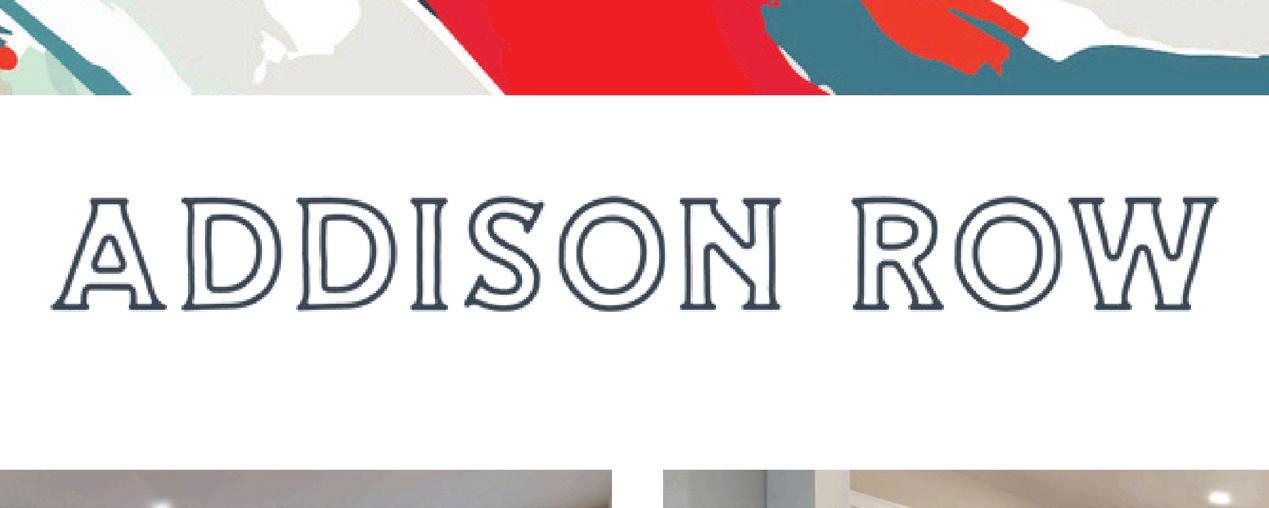
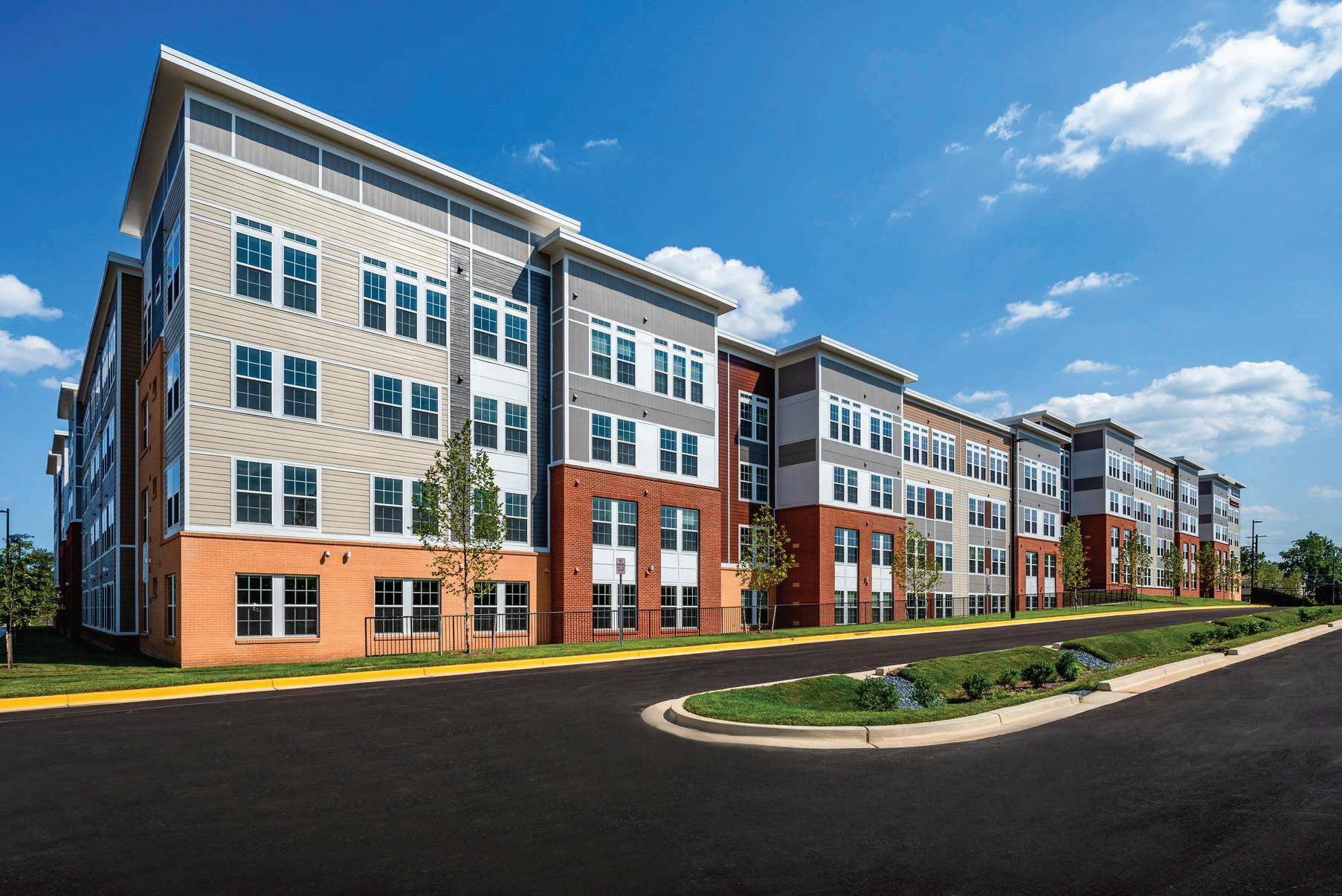

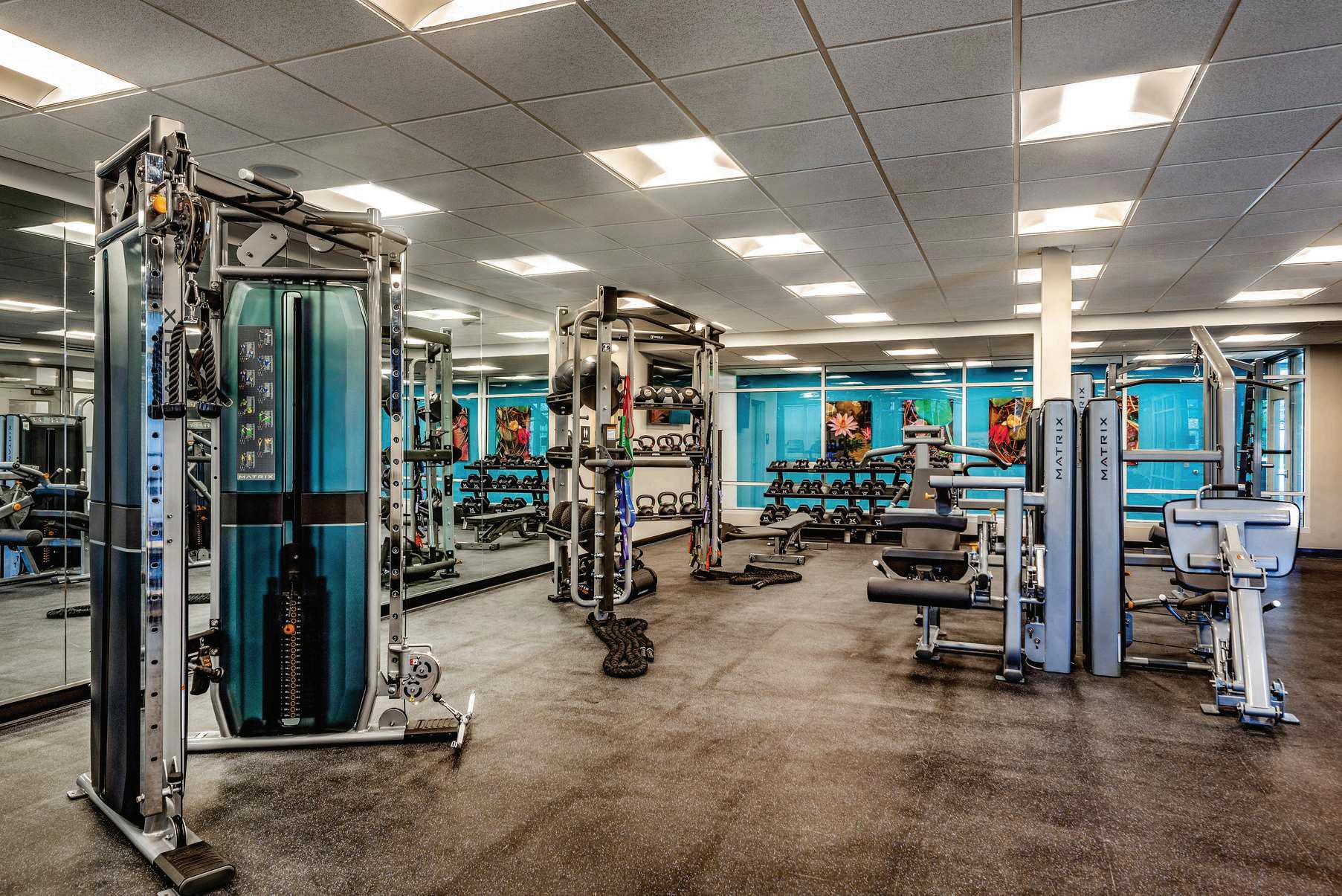


Diamondback Jobs Guide
The Diamondback has been an almost entirely online publication since March 2020. Since then, we’ve been exploring new ways to engage readers and address the information needs of the university community in the digital space.
Initially, that looked like launching a COVID-19 dashboard and publishing case counts when the university stopped publicly reporting them. From the reception we received, one thing is clear: our audience craves accountability and transparency in the community. To that end, we’re excited to introduce The Diamondback
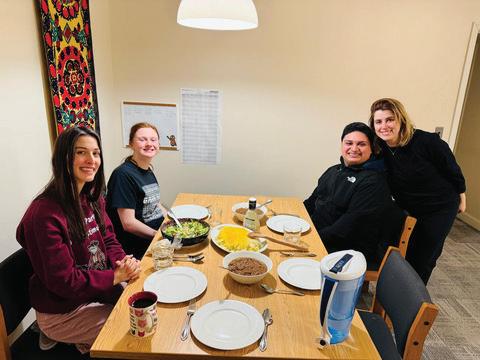
jobs guide, a site that empowers users to explore historic student wages and discover campus jobs. The jobs guide is designed to help students make informed decisions while looking for employment around the campus. Drawing inspiration from The Diamondback salary guide, the jobs guide empowers users to explore the data independently.
Sometimes, what worked in the past can be reimagined for the present. In print newspapers, including historical editions of The Diamondback, the classified section was an avenue to communicate local opportunities. We envision our jobs
guide serving a similar purpose for the University of Maryland community.
With the jobs guide and future reporting, The Diamondback seeks to be data-driven in its approach to service the broader University of Maryland community. Thank you to the readers, students, focus group members and Diamondback sta for driving this mission forward.
Explore The Diamondback jobs guide at jobs.dbknews.com . This guide was made possible by Nataraj Shivaprasad, Rina Torchinsky and Sri Kanipakala.
Persian Flagship Program
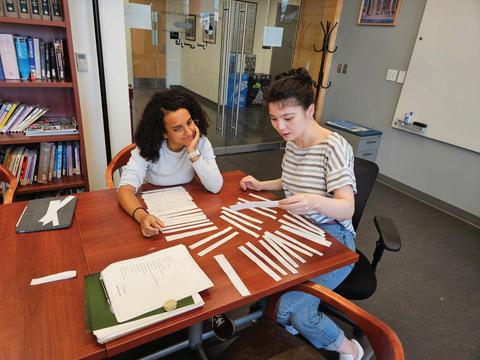
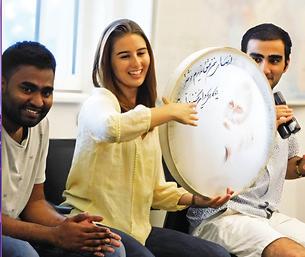


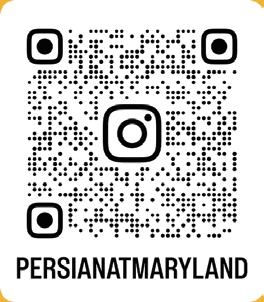


Now that you’ve been accepted into the University of Maryland, you may be navigating the financial aid process or wondering what you could have done di erently. The financial aid process can be daunting, but this explainer should help demystify the process.
College comes with a big price tag. Over the past three decades, college tuition costs have skyrocketed. At four-year public schools, in-state tuition has jumped from about $4,000 annually to almost $11,000, according to data from the College Board.
But don’t fret — here’s a breakdown of di erent types of financial aid and some tips to help you along the way from a seasoned scholarship applicant.
Federal and state-based aid
By now, you might already know what FAFSA is and why it’s important. But as a refresher, FAFSA, otherwise known as the Free Application for Federal Student Aid, allows students pursuing undergraduate or graduate degrees to apply for federal financial aid. This can be applied toward tuition, fees, room and board, textbooks and other school-related expenses.
Some states also have financial aid programs for state residents who attend college in the state and outside of it, as well as out-of-state students. In Maryland, there’s MDCAPS, which processes applications for state-sponsored scholarships. Programs like this usually use the information entered in your FAFSA application to determine what kind of state-based aid you would be eligible for.
Regardless of how you or others may perceive your financial situation, it’s still important to apply for both federal and state-based aid because you may still be o ered federal aid or your application can be used for state awards.
nancial aid
By Amanda Hernández | Updated by Monica Godnick
Now, you’re probably curious about what types of aid exist and how they work. Below, you’ll find a breakdown of each one.
Breaking down di erent types of aid
Scholarships
Scholarships come in all forms, shapes and sizes. You also don’t have to repay the amount back. Scholarships can be either merit-based or based on a student’s financial need. You can find thousands of scholarships to apply to online, but don’t forget to also apply to smaller, local ones in your area. If you already know what you’re majoring in, I highly recommend searching for professional groups related to your major that fund scholarships. If you live in Maryland, you can also apply for delegate and senatorial scholarships.
Grants
Grants are another great way to fund your education. You don’t need to worry about paying these back either. Most grants are given to students based on financial need, but that shouldn’t stop you from applying if you can. The federal government o ers several grants through FAFSA, such as the Federal Pell Grant. Universities also sometimes o er grants.
Loans
Loans are where it gets really tricky in the world of financial aid. A loan is money you borrow from the government, bank, financial institution or other organization, which you must pay back with interest. Private loans can be more di cult to navigate, but federal student loans usually have more benefits, according to the U.S. Department of Education. The two most common types of federal student loans are direct subsidized or direct unsubsidized. Direct subsidized loans are based on financial need and do not need to be paid until you graduate.
Direct unsubsidized loans, though, are not based on financial need and students are responsible for paying the interest.
Work Study
Last, but certainly not least, federal work-study provides students who show financialneed with part-time jobs. The work-study program is available to both full-time and part-time students. The money earned is meant to help students cover education-related expenses.
Resources for transfer students
If you’re a transfer student, you might be wondering what kind of aid you’re eligible for. You should still apply for FAFSA and any state-based aid you qualify for, but as a transfer student, you also have access to additional scholarships or financial aid programs specifically for transfer students. At this university, transfer students are automatically reviewed for some merit scholarships, while other scholarships require an application.
Resources for undocumented students
Navigating the financial aid process is hard enough as it is, but as an undocumented student, it can be even more daunting. While some financial aid programs require students to be U.S. citizens, you can also find scholarships or other programs that o er financial assistance to undocumented students.
The Immigrant and Undocumented Student Life Program at this university also o ers an extensive online list of scholarships and other financial resources available to undocumented students. In the case of private scholarships, nonprofits like TheDream.US or Golden Door Scholars have opportunities that are specifically meant to help undocumented students.
*This story was originally part of our orientation guide from 2022. Some information and resources have been updated to reflect current figures.
Traducción - Ayuda FinancierA
Escritora: Amanda Hernández | Actualizado por: Mónica Godnick
Ahora que usted ha sido aceptado en la Universidad de Maryland, puede ser que esté navegando por el proceso de ayuda financiera, o preguntándose qué podría haber hecho de manera diferente. Lo que sí se sabe con seguridad es: El proceso de ayuda financiera es abrumador y desalentador. La universidad trae consigo un costo muy alto.
La universidad tiene un precio muy alto.
Durante las últimas tres décadas, los costes de la matrícula universitaria se dispararon. En las escuelas públicas de cuatro años la matrícula ha aumentado de unos $4.000 anualmente a casi $11.000, según los datos del College Board. Pero no se preocupe — aquí hay un desglose de diferentes tipos de ayuda financiera y algunos consejos para ayudarle con el proceso.
Ayuda federal y estatal
Es posible que ya sepa qué es FAFSA y por qué es importante. Pero como recordatorio, FAFSA, también conocida como la Solicitud Gratuita de Ayuda Federal para Estudiantes, permite que los estudiantes que buscan títulos universitarios o de graduados soliciten ayuda financiera federal. Esto puede aplicarse a la matrícula, tarifas, pensión completa, libros de clase y otros gastos relacionados con la educación.
Algunos estados también tienen programas de ayuda financiera para residentes del estado que asisten a la universidad en su estado y fuera de él, así como para estudiantes fuera del estado. En Maryland, existe el MDCAPS, que procesa las solicitudes de becas patrocinadas por el estado. Programas como este generalmente utilizan la información ingresada en su solicitud de FAFSA para determinar para qué tipo de ayuda estatal usted sería apto.
Independientemente de cómo usted u otros perciban su situación financiera, es importante solicitar ayuda tanto federal como estatal, ya que aún le pueden ofrecer ayuda federal o su solicitud puede ser apta también para premios estatales.
Ahora bien, es probable que tenga curiosidad sobre los tipos de ayuda que existen y cómo funcionan. A continuación, encontrará un desglose de cada uno de ellos.
Desglosando los diferentes tipos de ayuda.
Becas
Las becas se presentan en todas las formas y tamaños. Además, no es necesario devolver la cantidad de dinero otorgada. Las becas pueden ser basadas en méritos o basadas en la necesidad financiera del estudiante. Puede encontrar miles de becas para solicitar en línea, pero no se olvide de postular también para las más pequeñas y locales en su área. Si usted ya sabe en la carrera que se va a especializar, le recomiendo que busque grupos profesionales relacionados con su especialización que financien becas. Si vive en Maryland, también puede postular para las becas de delegados y las senatoriales.
Subvenciones
Las subvenciones también son otra manera excelente de financiar su educación. Tampoco es necesario preocuparse por pagar estos gastos. La mayoría de las subvenciones se concede a los estudiantes en función a las necesidades financieras, pero eso no debería disuadir a uno de completar una solicitud. El gobierno federal ofrece varias subvenciones a través de FAFSA, como la Federal Pell Grant. Las universidades también ofrecen subvenciones a veces.
Préstamos
En el mundo de la ayuda financiera, el tema es más complicado cuando se trata del proceso de los préstamos. Un préstamo es dinero que usted pide prestado al gobierno, un banco, una institución financiera u otra organización, que se debe pagar después con intereses. Los préstamos privados pueden ser más difíciles para navegar, pero los préstamos federales para estudiantes suelen tener más beneficios, según el Departamento de Educación de los Estados Unidos. Los dos tipos de préstamos federales más comunes para estudiantes son préstamos subsidiados o préstamos directos no subsidiados. Los préstamos directos subsidiados se basan en la necesidad financiera y no se necesitan pagar hasta después de haberse graduado. Los préstamos directos no subvencionados, sin embargo, no se basan en la necesidad financiera y los estudiantes son responsables de pagar los intereses del préstamo.
Programas de trabajo y estudio
Por último, pero no por ello menos importante, el programa de trabajo y estudio federal proporciona empleos de tiempo parcial a los estudiantes que demuestren necesidades financieras. El programa de estudio de trabajo está disponible tanto para estudiantes de tiempo completo como de tiempo parcial. El dinero ganado está destinado a ayudar a los estudiantes para cubrir los gastos relacionados con su educación.
Recursos para estudiantes transferidos
Si es un alumno que se ha transferido de otra universidad, puede que se esté preguntando para qué tipo de ayuda es apto. Aún debería postular para la FAFSA y cualquier ayuda estatal a la que usted califique, pero como estudiante transferido, también tiene acceso a becas adicionales o programas de ayuda financiera específicamente para estudiantes que se transfieren de otras universidades. En esta universidad, los estudiantes que se transfieren son automáticamente considerados para algunas becas de mérito, mientras que otras becas requieren una postulación.
Recursos para estudiantes indocumentados
Ya es bastante difícil navegar el proceso de ayuda financiera, pero como estudiante indocumentado, puede ser aún más desalentador. Mientras que algunos programas de ayuda financiera requieren que los estudiantes sean ciudadanos estadounidenses, también puede encontrar becas u otros programas que ofrecen asistencia financiera a estudiantes indocumentados.
El Programa de Vida Estudiantil para Inmigrantes e Indocumentados en esta universidad también ofrece una lista amplia en línea de becas y otros recursos financieros disponibles para estudiantes indocumentados. En el caso de becas privadas, organizaciones sin fines de lucro como TheDream.US o Golden Door Scholars específicamente ofrecen oportunidades para ayudar a los estudiantes indocumentados.
COLLEGE PARK IN PHOTOS
By
The
Trains arrive and depart at the College Park Metro Station on Feb. 3, 2025. (Ryan Bowie/The Diamondback)
Two
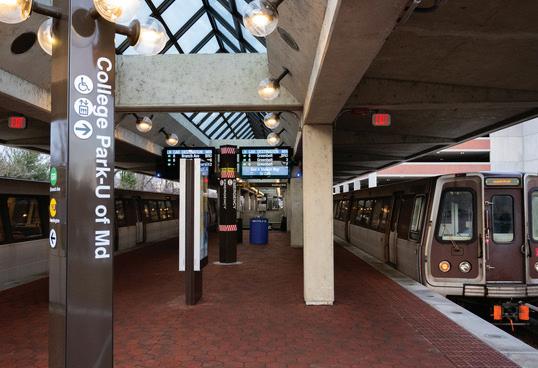
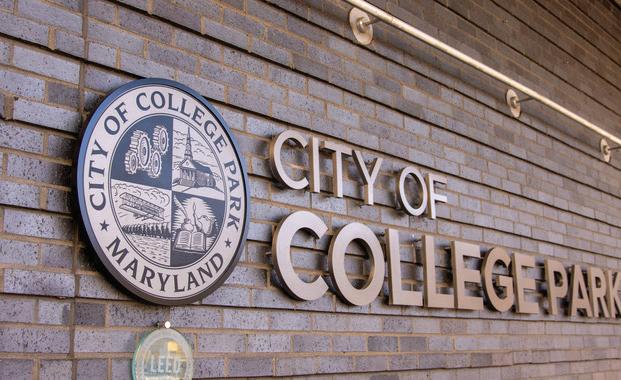
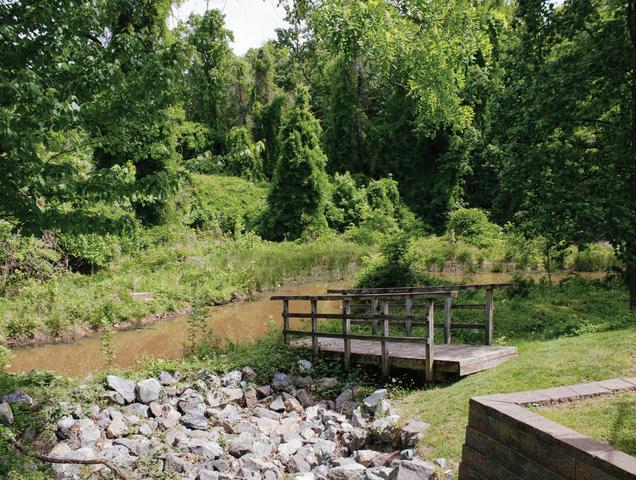

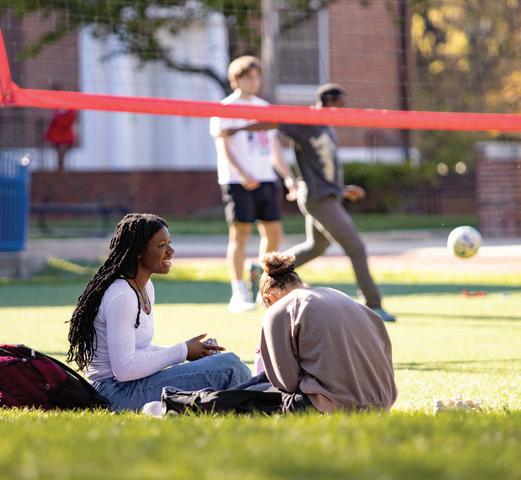
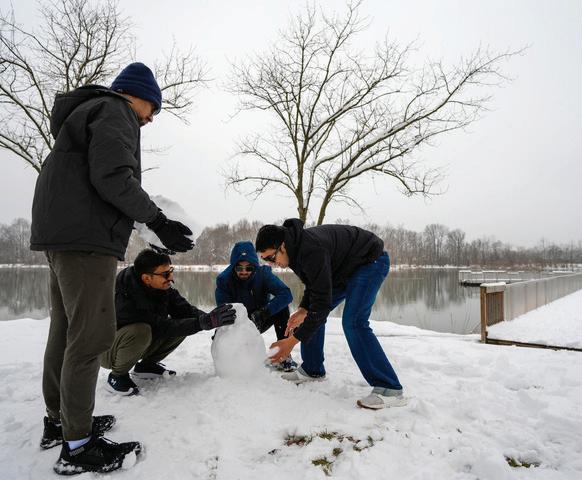
UMD students build a snowman outside of Lake Artemesia in College Park on Feb. 12, 2025. (Ryan
Flowers bloom near a Testudo statue outside the Samuel Riggs IV Alumni Center on March 31, 2025. (Gurnoor Sodhi/The Diamondback)
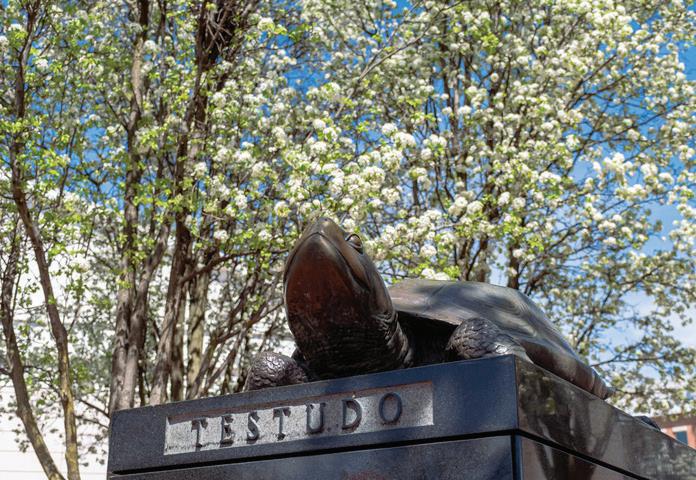
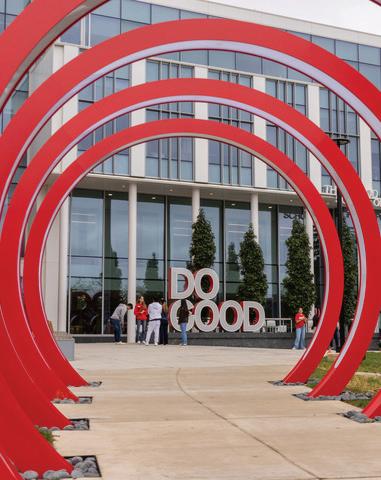
Pedestrians walk near McKeldin Mall on Feb. 5, 2025. (Sam Cohen/The Diamondback)
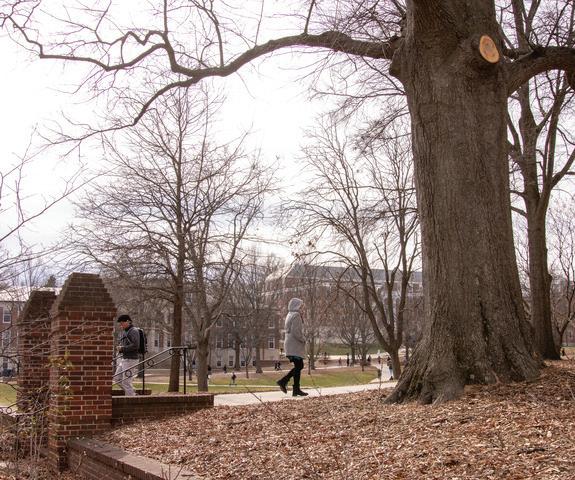
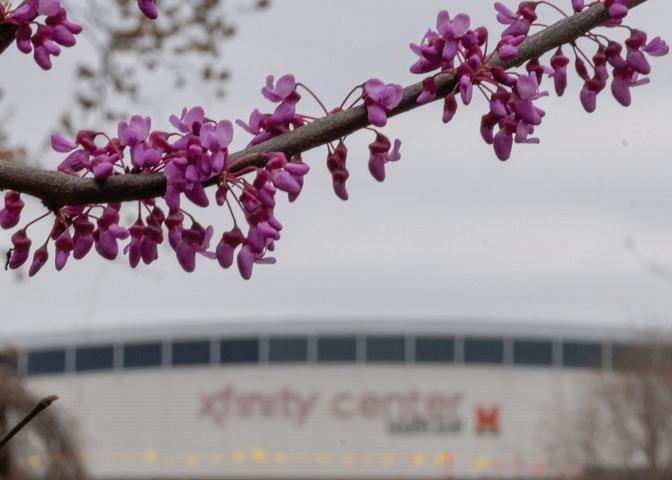
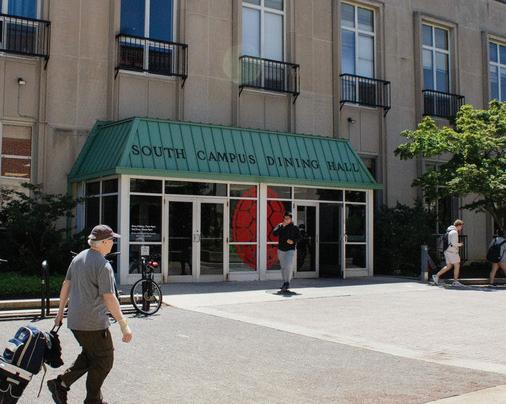
The Do Good rings outside of Thurgood Marshall Hall on Sept. 24, 2024. (Sam Cohen/The Diamondback)
Flowers bloom Outside of X nity Center on April 2, 2025. (Gurnoor Sodhi/The Diamondback)
The exterior of South Campus Dining Hall on April 27, 2025. (Christina Duncan/The Diamondback)
Here are some of bills UMD SGA passed in 2024-25
The University of Maryland SGA passed several initiatives during the 2024-25 academic year in response to student activism and federal and state legislation.
Here are some of the Student Government Association’s highlights from this year.
DIVESTMENT REFERENDUM
During the SGA election this year, students voted in support of the University System of Maryland Foundation and University of Maryland College Park Foundation divesting from certain defense, military and security companies.
Fifty-five percent of voters, or 3,260 people, voted in favor of the referendum. The question called on the SGA to start lobbying the university system foundation and UMCP foundation to divest from companies that may be “implicated” in human rights violations in places such as Palestine, Sudan and the Philippines.
This university wrote in a statement to The Diamondback on April 18 that the referendum’s results have no bearing on the policies
By Lauren Frank I Sta writer
or operations of the university or its foundations.
Similar resolutions failed to advance in the SGA in 2017, 2019 and last spring, The Diamondback previously reported.
RESPONDING TO FEDERAL ACTIONS
The SGA was faced with “a lot of challenges” at both the federal and state levels, outgoing SGA president Reese Artero told The Diamondback on May 2.
In February, the SGA approved a bill to launch a “Know Your Rights” campaign, which would require SGA members to work with campus groups and legal experts to assemble materials for immigrant, international and undocumented students, as well as Deferred Action for Childhood Arrivals recipients, The Diamondback reported in February.
The act also urges this university to expand the Student Crisis Fund — a university program that provides aid to students during unexpected emergencies — to cover legal costs as relief for students who face risks of detainment or deportation.
The bill came after U.S. President Donald Trump signed several executive orders targeting illegal immigration during his first week back in o ce.
The SGA also worked with the University Career Center to promote internship and job opportunities for students a ected by the federal hiring freeze.
“It was really crucial we got this out really fast to students so they could be able to apply before the deadlines were surpassed,” Nick DiSpirito, a sophomore public policy major and former SGA o -campus neighboring representative, said.
The SGA specifically focused on providing internship resources for students in state government and within this university, such as the Do Good Institute’s Impact Interns program and Maryland Department of Transportation Fellows Program.
The SGA has also promoted existing resources including those from the undergraduate research o ce and Pathways to Science, both of which help students find and secure research positions.
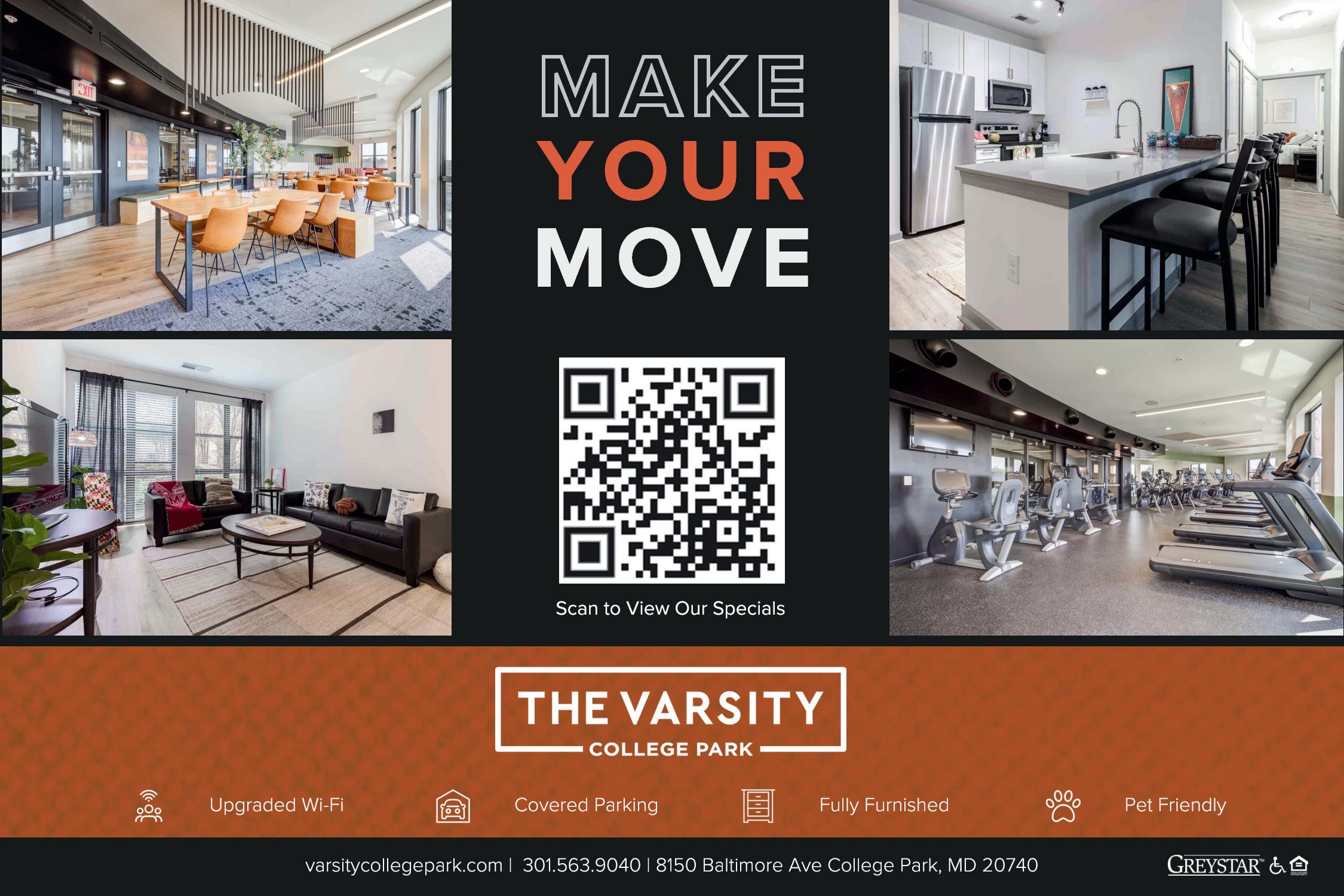
Priya Tyagi, a freshman cell biology and genetics major and former computer, mathematical and natural sciences college representative, said resources such as Pathways to Science fill in the gap that the cancellation of research programs have left by providing scholarships, fellowships and internships to underrepresented students in the science fields.
The SGA also passed a resolution this semester rea rming its commitment to diversity, equity and inclusion and sustainability in response to other executive orders passed by Trump.
GENDER-AFFIRMING CARE ITEMS
In the fall semester, the SGA passed a bill allocating funding for the LGBTQ+ Equity Center to provide gender-a rming care items, including chest binders and TransTape, this spring, The Diamondback reported in November.
The program, which aimed to support at least 100 students by the end of the academic year, has expanded since the SGA began working with the equity center about two years ago to provide gender-a rming care materials to students, Artero said.
The SGA may allocate upward of an additional $5,000 to the equity center for its operations next year depending on the remaining balance in its legislative reserves, the senior criminology and criminal justice major said.
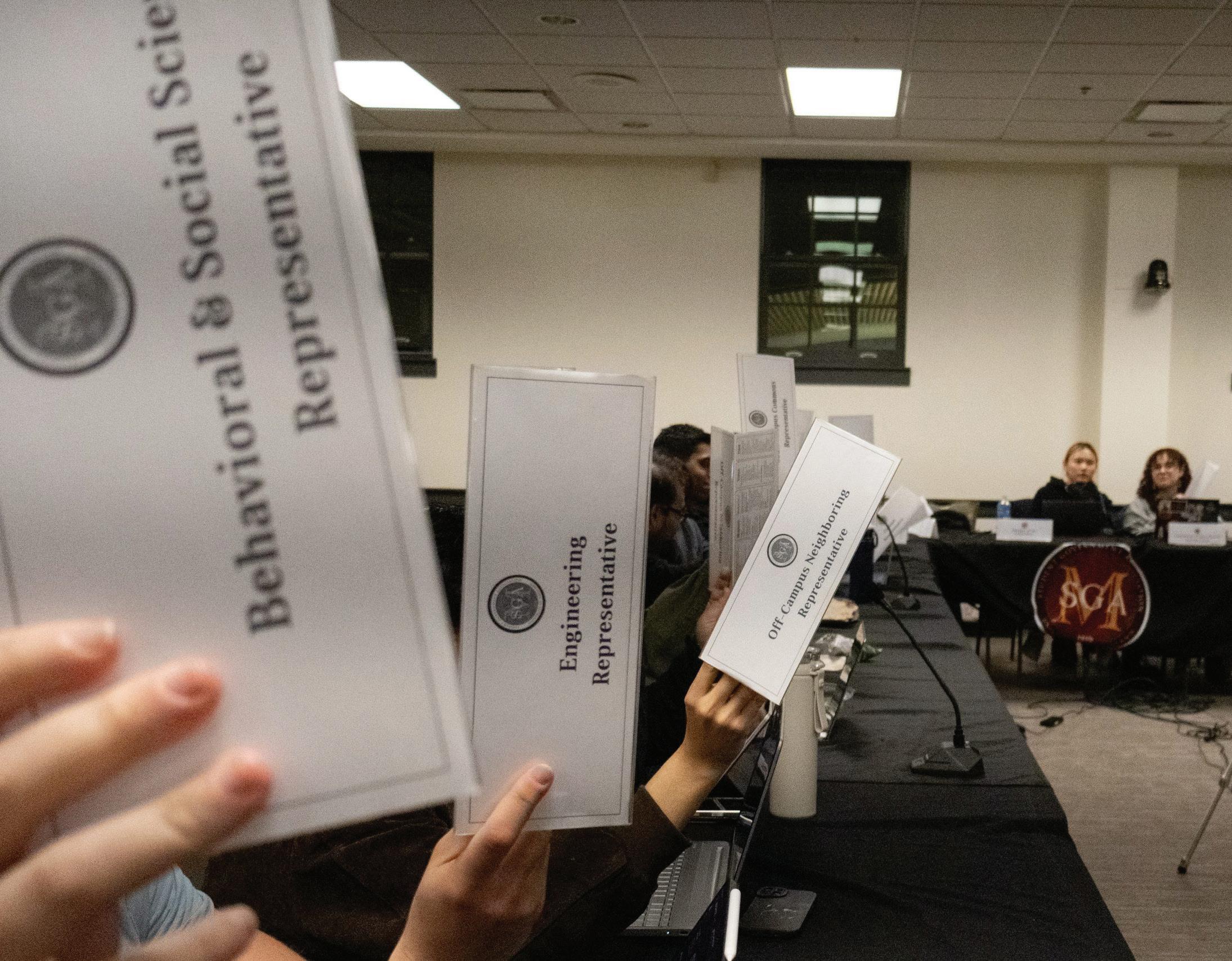
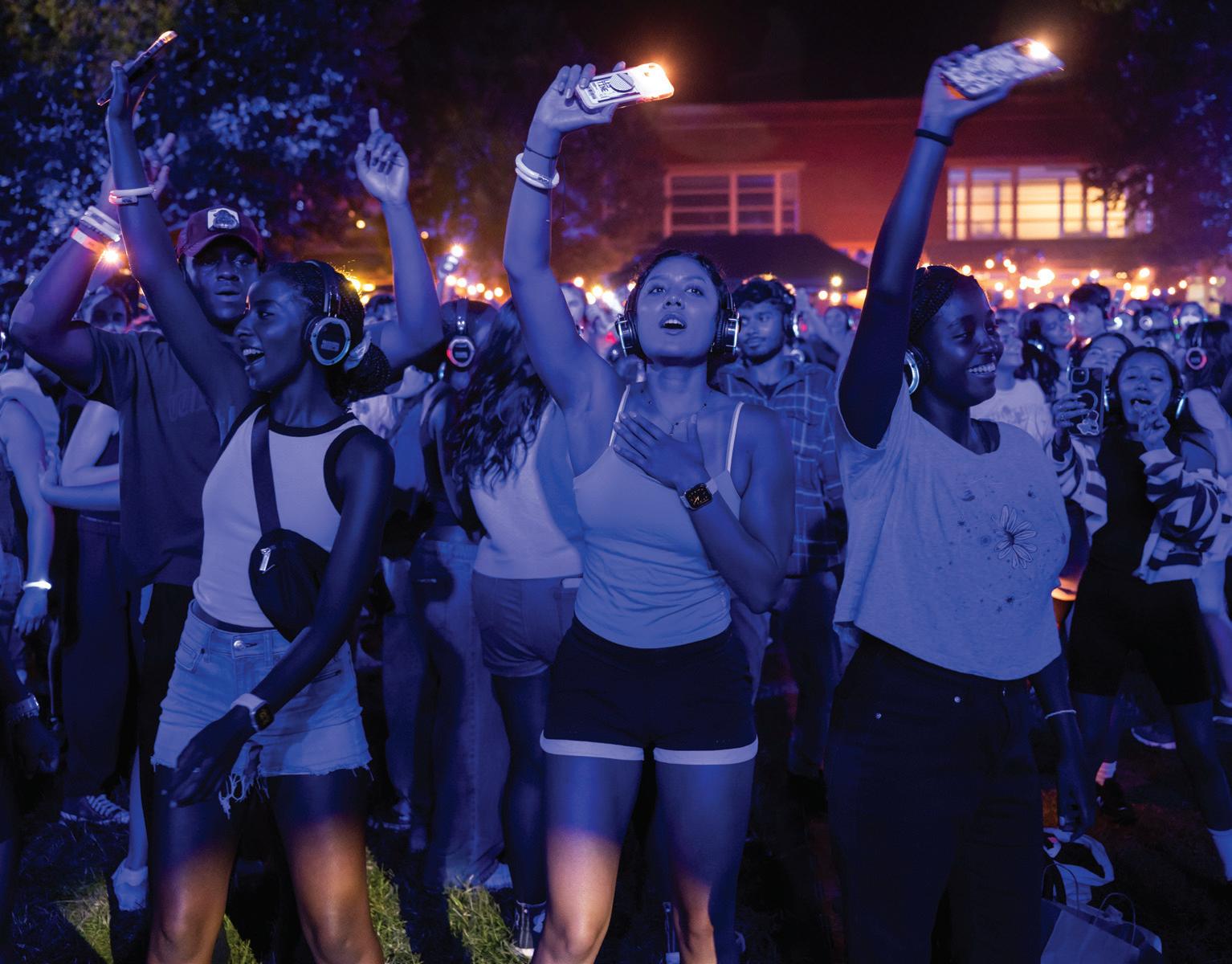
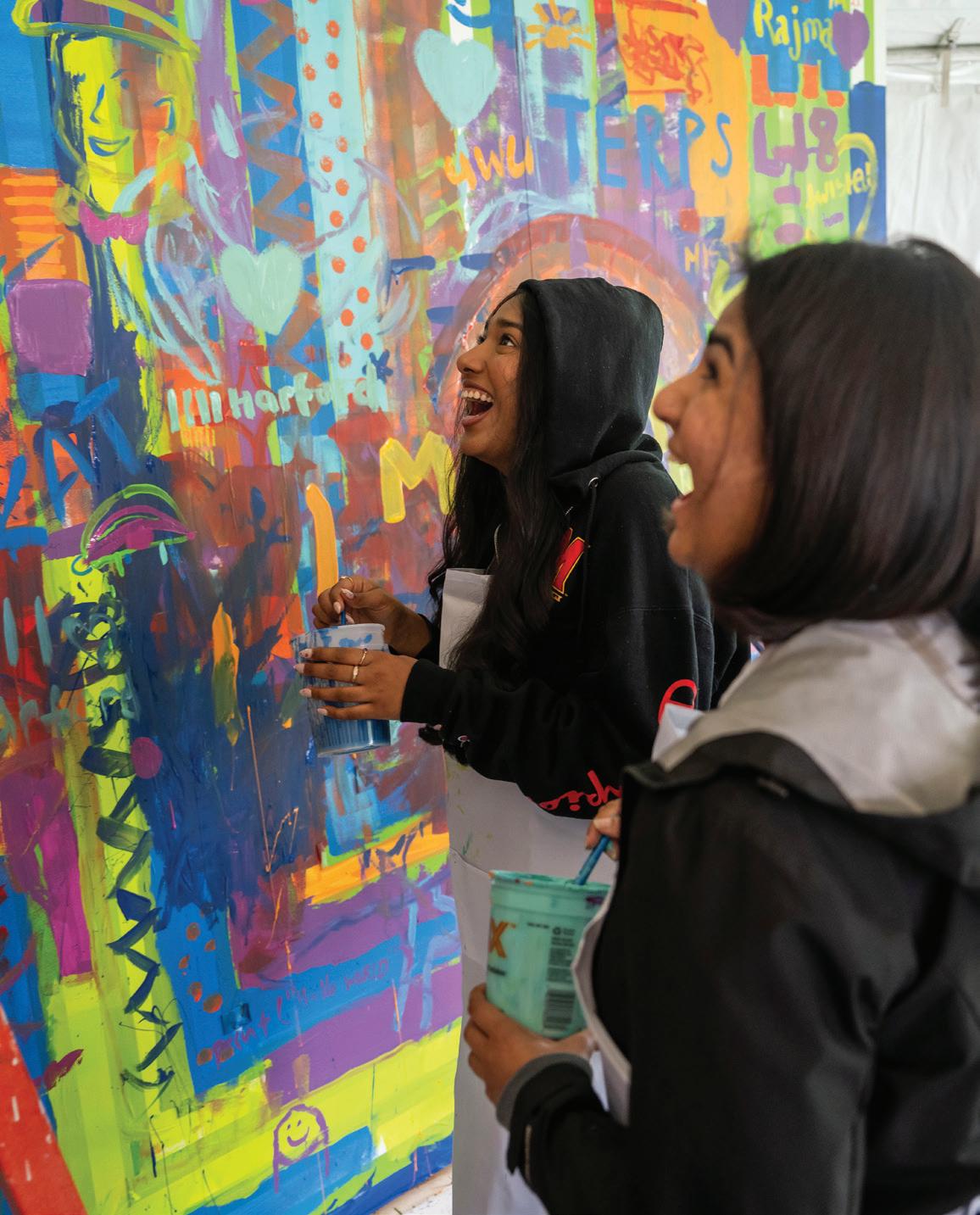
UMD RHA 2024-25 bills passed include student voter registration, accessibility resolutions
By Katherine Schutzman I Sta writer
The University of Maryland’s Residence Hall Association passed 10 bills this academic year, including resolutions to promote student voter registration and create committees dedicated to accessibility and transfer students’ needs.
Outgoing RHA vice president Michelle Ameyaw said although the number of bills passed this year is less than half of the 26 passed last academic year, the smaller number indicates the intention behind each resolution.
“The bills that were passed were very salient and were done so with intent and had lasting impact, or will have lasting impact, on our residents,” the junior biological sciences major said.
Recently-elected 2025-26 RHA president Emily Shoemaker attributed this year’s lower amount of new legislation to a focus on out-

reach programs.
The governing body’s two main focuses are legislation and programming, the sophomore information science and philosophy, politics and economics major said. But some years, there’s an increased emphasis on one over the other, she said.
Shoemaker also said RHA hopes to encourage more senators to bring forward legislative ideas in the upcoming academic year.
The formal bill proposal process can be intimidating for students, she said, but starting open conversations about potential concerns is an important step.
“If people are comfortable talking about that and pursuing those solutions, it will just better campus as a whole,” Shoemaker said.
Here’s a look at some of the bills RHA passed this academic year.
Events promoting voter registration
Ameyaw authored a resolution during election season requiring at least one “Floats 4 Votes” drive event be hosted in collaboration with Dining Services each year to promote student voter registration.
The event prompts civic engagement by o ering students free ice cream and root beer in exchange for completing a voter’s education quiz or for interacting with TerpsVote on social media, according to the resolution. The resolution also specifies the event must take place before the Maryland voter registration deadline in an election year.


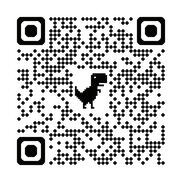



Ameyaw said she expects this resolution will have long-term benefits for students’ civic engagement.
“We wanted to make it a yearly thing so that students aren’t just thinking about registering to vote and civic duties when it’s an election year,” she said.
Mandatory sustainability fee
RHA called an emergency senate meeting over winter break to review a mandatory fee proposed by this university’s sustainability office. The resolution recognized that a portion of the fee would contribute to this university’s Campus Pantry, according to senator Claire Bushar.
The freshman bioengineering major, who presented the bill, said funding Camps Pantry operations is especially important with the reported increase in food insecurity on campus.
27 percent of respondents to this university’s spring 2023 Food Access and Student Well-Being study reported experiencing food insecurity, according to the survey.
“Supporting the campus pantry … was a valuable use of that sustainability fund to care for our student community,” Bushar said. Considering a mandatory fee, Ameyaw said,
was somewhat unprecedented, as RHA is generally only asked to consider non-mandatory fees. RHA approved two non-mandatory fees this year, proposed by this university’s Dining Services and Resident Life and Residential Facilities departments, according to the senate’s webpage.
Diversity,equityand
inclusion and Sustainability Rea rmation
RHA’s rea rmation of its commitment to diversity, equity and inclusion and sustainability was intended to reassure and remind students of the organization’s mission and stance in the face of federal uncertainty, Ameyaw said.
The resolution followed a similar bill under the same name passed by this university’s Student Government Association in February.
Advocacy surrounding DEI and sustainability are vital in supporting RHA’s goal of uniting students of di erent backgrounds, Ameyaw said.
“It rea rms that RHA is truly here to support and represent all the students living on campus, regardless of what they may be fac-
ing,” senator-at-large and freshman chemical engineering major Jacqueline Geary said
AdHoc committees
The senate passed two resolutions creating ad hoc committees dedicated to on-campus accessibility and transfer students’ concerns at the last RHA meeting of the spring semester. Both were authored and presented by senator and sophomore marketing major Angela Lin, who saw a need for more representation for and focus on these groups.
The transfer student committee will focus on the needs of students transferring to this university from community college and other four-year institutions, according to Lin. The resolution specifies the committee must host at least one event per semester specifically for transfer students.
The accessibility and disability committee hopes to collaborate with this university’s accessibility and disability service department, Lin told The Diamondback in April. Lin said she also hopes the committee will host regular events for disabled students.
“The goal is to have students know this committee and attend it and feel like it’s like a safe space for them,” Lin said.
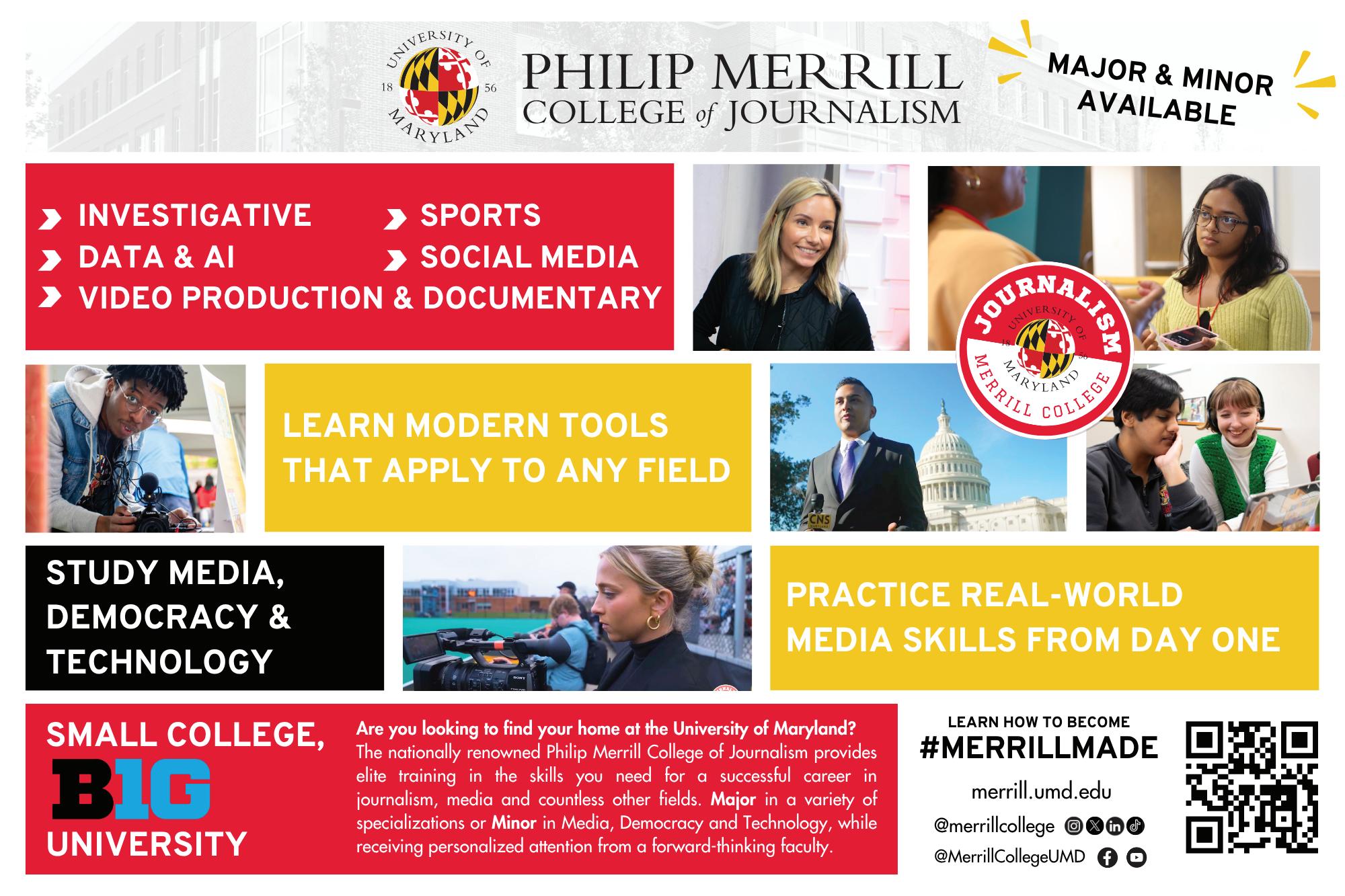
Take a look at how USM operates, in uences UMD
By Amelia Twyman I Sta writer
The University of Maryland is part of a broader system of public higher education institutions throughout the state of Maryland.
The University System of Maryland, formed in 1988, is made up of 12 public universities,three regional higher education centers and a system office.
The Diamondback spoke with university system leadership to understand how it functions.
What
The system’s 12 member institutions consist of:
- Bowie State University
- Coppin State University
- Frostburg State University
- Salisbury University
- Towson University
- University of Baltimore
- University of Maryland, Baltimore
- University of Maryland, Baltimore County
- University of Maryland, College Park
- University of Maryland Eastern Shore
- University of Maryland Global Campus
- University of Maryland Center for Environmental Science
Three regional higher education centers also comprise the system:
- Universities at Shady Grove
- University System of Maryland at Hagerstown
- University System of Maryland at Southern Maryland
The system office, the university system’s third and final unit, bridges these 15 member institutions and Maryland’s governing bodies, according to the system’s website.
The entire office is led by a chancellor and includes eight smaller offices. Current chancellor Jay Perman has held the position since 2020.
Herbst said.
What is the USM Board of Regents?
The system office also staffs the Board of Regents, the 21-member governing body overseeing the university system and its academic, financial and administrative a airs.
The board and its seven committees, which each focus on operational areas, gather periodically in public meetings and closed sessions to vote on certain university policy, according to Herbst.
The board approves certain academic projects
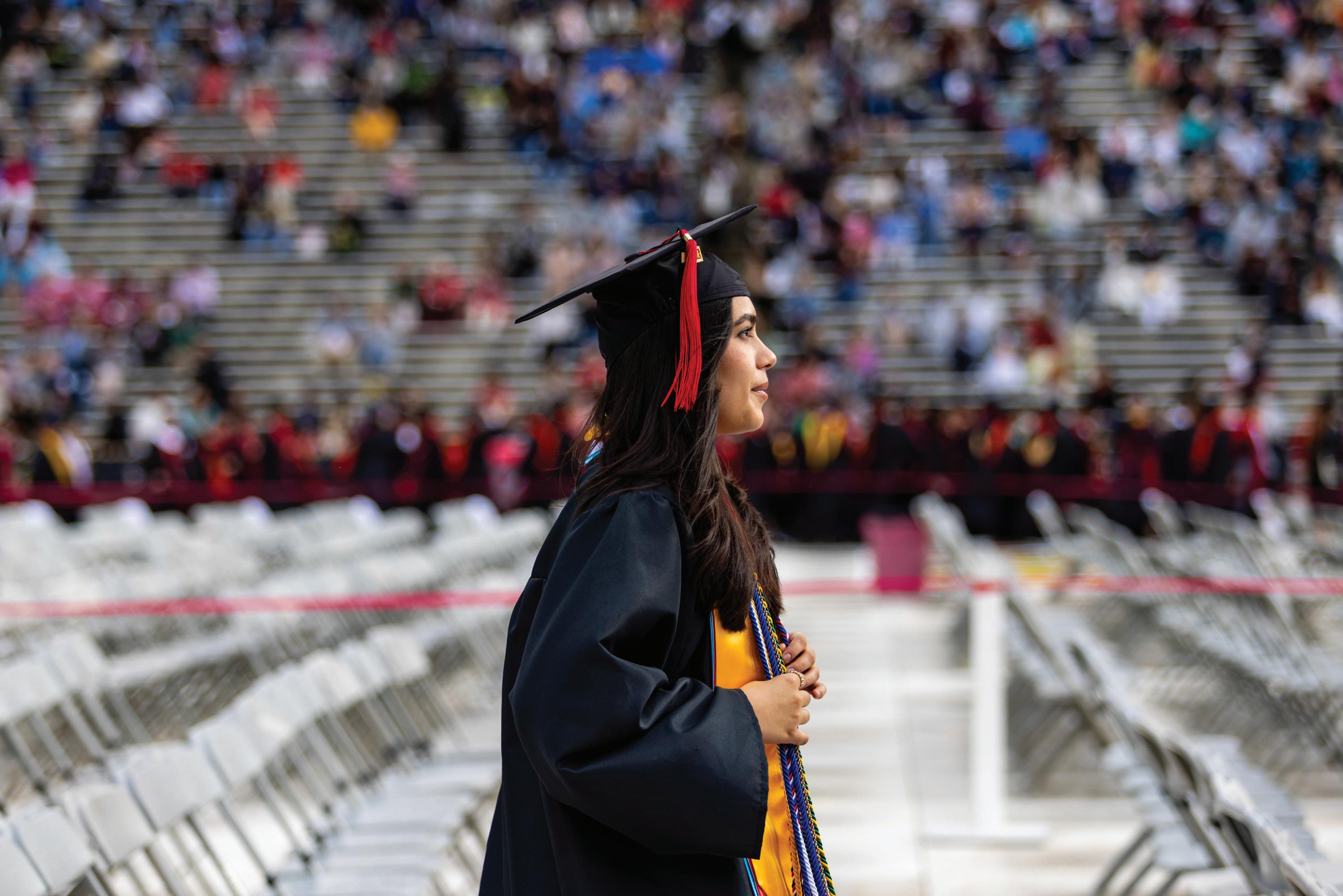
But the system’s member institutions rarely work with the Board of Regents directly, Herbst said. Instead, they go to the system o ce with questions and policy proposals, which then drafts up reports for the board to consider so they can “make informed decisions.”
Dhruvak Mirani, a junior computer science and government and politics major at this university, is one of the board’s two student regents.
Student regents serve “staggered terms,” meaning one is elected every other year, Mirani said. They act as non-voting board members their first year and become voting regents their second year.
Mirani, who was appointed in June 2024, participates in meeting discussions and frequently collaborates with board members, university administrators and stakeholders from the system’s other universities, he said.
What is the university system’s economic value?
University system institutions recorded more than $1.6 billion in “research and development expenditures” in fiscal year 2023 and granted $101 million in need-based financial aid to undergraduates in fiscal year 2024, according to data published
on its website.
The system’s data reports the annual economic impact as $10.4 billion, which funds more than 55,000 jobs within the state of Maryland.
How does USM’s budget work?
The university system receives annual funding from the state government. About 60 percent of the budget goes toward salaries according to Herbst. It also covers branding costs and allows the system to bring in outside auditors to conduct financial reports.
The institutions within the university system have allocated separate funds for costs including tuition fees, salaries and research, which they receive directly from the state or from research grants, she added. Their funds do not go through the system o ce.
university system o ce’s budget and 7 percent of each member university’s budget, according to Herbst.
The system’s individual institutions are each responsible for creating their own budget plans that take into account these cuts, although the system o ce will be available to support them throughout the process, Herbst said.
In response to a request for comment about the e ect of the cuts, Herbst directed The Diamondback to a testimony given by Perman in January regarding the then-proposed budget cuts, which amounted to about 5 percent at the time.
“The cut we’re sustaining will be di cult for our universities, for the faculty and sta they employ, and for the students they educate,” Perman said.
Perman listed workforce reductions, cuts to operational and facilities spending and tuition increases across universities as possible impacts of the system’s reduced budget. Up to 400 jobs could be a ected, he estimated in January.
The Maryland General Assembly approved a budget plan for fiscal year 2026 in April that would reduce university system funding by $155 million. These cuts amount to about 7 percent of the
“These e orts will not be easy or their impact painless,” Perman said. “We are committed to keeping Maryland public higher education exceptional and a ordable, and helping every one of our students achieve the degree, and the dream, that first brought them to the University System of Maryland.”

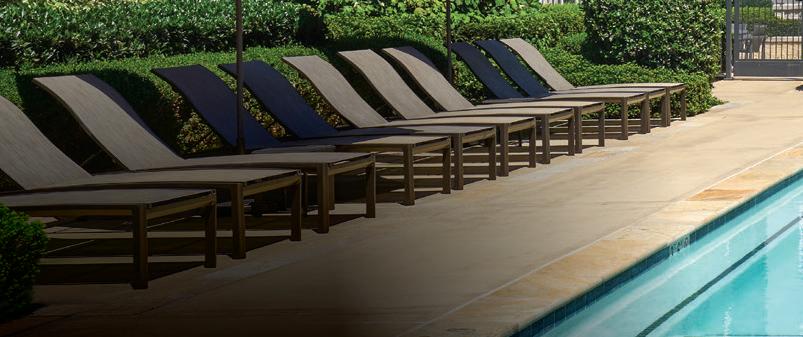
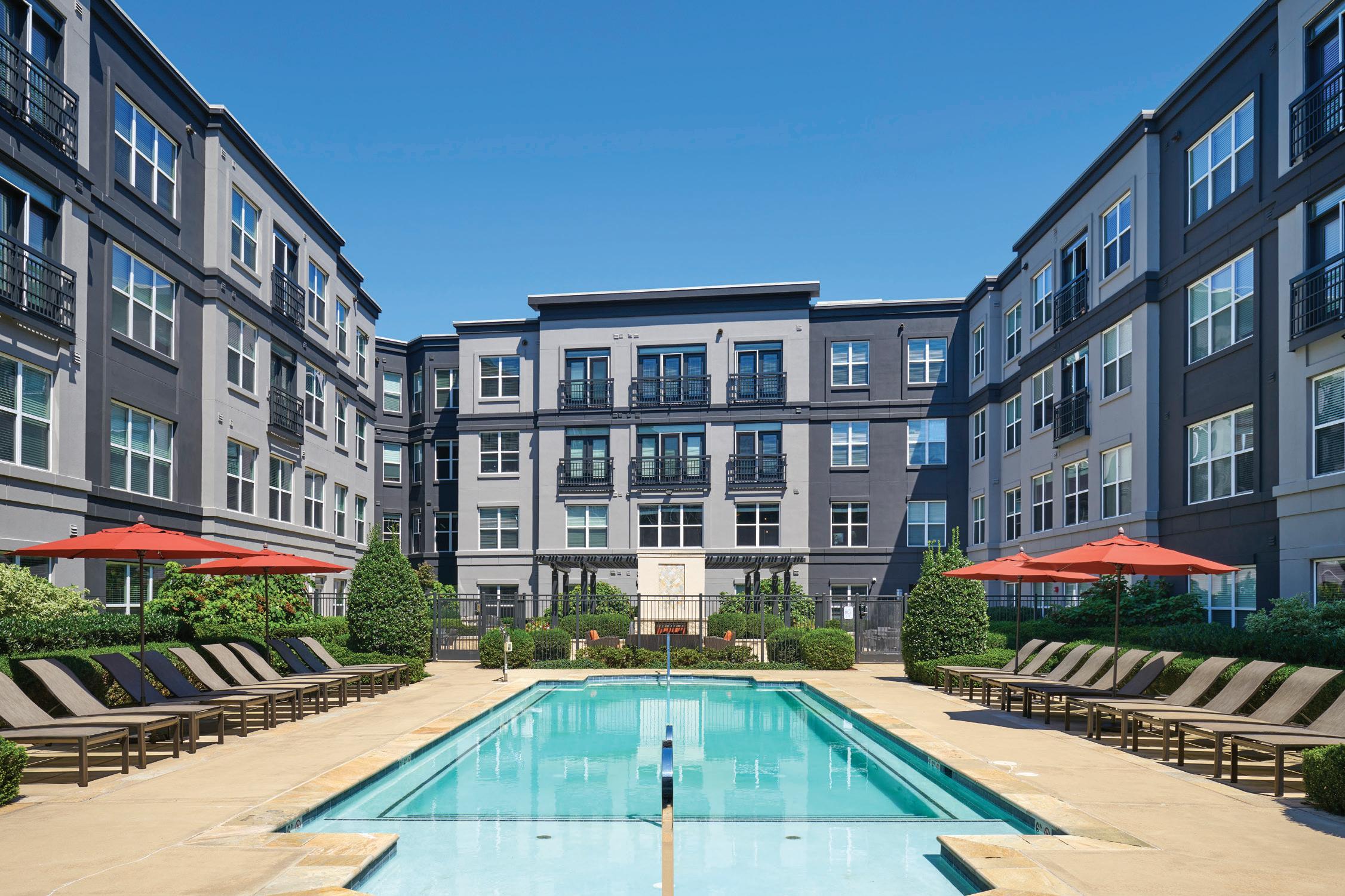
a closer look into the University senate
By Amelia Twyman I Sta writer
The University Senate is one of the largest governing bodies at the University of Maryland with nearly 240 members, including peer-elected students, faculty and sta .
The senate aims to review proposals that reflect this university’s core values and regularly review existing policies, according to the senate’s website. The policies span topics such as university finances to social climate, the website read.
“The senate allows a place for all the concerns of the university to come together,” senate chair Jordan Sly said. “Through the function of shared governance, everyone’s voices can be heard in one way or another.”
The Diamondback spoke with three senators to understand the history of the body as well as its structure and processes.
Senate structure
The senate first assembled in 1919, but was not o cially recognized until 1955, according to university archives.
In the 1970s, the senate expanded to include undergraduate students, graduate students and sta .
As of March 2025, the senate has 239 members, consisting of:
153 faculty
25 sta
10 graduate students
29 undergraduate students
15 deans
Seven single-member representatives
For most groups, senate seats are allocated based on the size of each represented body.
Graduate students are represented by 10 atlarge seats, with at most two senators from the same college, while university deans hold their seats by default.
Faculty and undergraduate student seats are further distributed between the university’s respective colleges and schools as follows:
Tenured and tenure track faculty have one seat for every 15 eligible faculty members.
Professional track faculty get one seat for every 30 eligible faculty members.
Undergraduate students have one seat for every 1,000 undergraduates.
Sta get one seat for every 200 faculty members in the exempt sta from colleges, exempt sta from divisions, non-exempt sta from colleges and non-exempt sta from divisions categories.
Election process
Senate elections take place annually, typically from January through March, according to its election page.
People interested in running for a seat can submit their name with a statement explaining why they are qualified for the position to the senate’s website for review.
If approved, the candidates’ names are added to an electronic ballot that is sent out to everyone within their respective constituency.
Faculty and sta senators can serve on the senate for three years, while student and single-member representatives serve for one year. Student and single-member representative seats can also be renewed for three consecutive years, according to the senate website.
Conell Brandner, an undergraduate student senator representing the architecture, planning and preservation school, said he ran for his school’s senate seat because he wanted to become more involved with campus activities as a commuter from Calvert County.
“I feel a lot more connected to the university [now],” the senior architecture major said. “[I feel] more than just a student and just being within the system.”
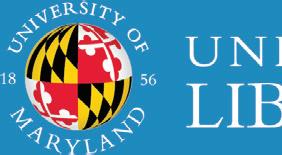
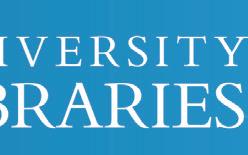

Senate committees and meetings
The entire senate meets about once a month, normally alternating between Wednesdays and Thursdays from 3:15 to 5 p.m. A majority of meetings are held on Zoom, except for when university president Darryll Pines presents deliver his State of the Campus address in Stamp Student Union’s Colony Ballroom.
Meetings are also open to the public.
There are 10 standing and three active elected committees in the senate.
Standing committees consist of senators and volunteers who serve one to two-year terms. Senate leaders assign committee members proposals to evaluate and revise based on their specialized area of focus.
This university’s standing committees include the equity, diversity and inclusion committee and the student conduct committee.
“Having these committees in an organizational process to refer di erent matters to, as with any governing body, helps to concentrate the expertise of folks,” M Pease, a counseling psychology doctoral student and at-large senator who represents graduate student constituencies, said.
Specific dates, times and locations for committee meetings can be found on the senate website’s events calendar.
The senate also has three active elected
committees — the executive committee, the committee on committees and the nominations committee. These committees, whose members are elected by other senators, primarily oversee senate operations.
The Senate Executive Committee is made up of the senate chair, chair-elect and 13 additional voting senators. This university’s president, senior vice president and provost are also non-voting members of the committee.
The executive committee sets meeting agendas, decides which committee should review a specific proposal and handles the implementation of approved policies according to the senate’s website.
Sly, the head of the executive committee, said his job is to facilitate senate meetings to ensure they are run fair and smoothly.
The legislative path
After it is submitted, the proposal goes through a thorough legislative process before it is approved and becomes o cial policy.
“Because we are careful and deliberative in our processes … it can take a long time,” Sly said. “But that doesn’t mean nothing’s happening. There’s a lot going on behind the scenes.”
First, senate leaders review the proposal to ensure it falls under the senate’s sphere of influence and contains enough detail for
discussion.
The executive committee then sends the proposal to a specific standing committee or forms a temporary special committee or task force for further review.
After discussion, the respective committee sends the revised proposal back to the executive committee, whose members decide if it is ready to appear on the senate floor for consideration.
When a proposal is sent to the senate floor, its championing committee, task force or special order gives a presentation outlining its recommendations. Then, senators vote to either reject or approve it. A majority vote is required to pass a piece of legislation.
If approved, it is sent to Pines for final assessment, since he maintains the power to modify, pass or reject any proposal, according to the senate website.
In some cases, a proposal may be sent to the university system Board of Regents for further consideration.
At any point during the senate’s legislative process, a proposal can be sent back to its reviewing committee for more work and discussion before advancing onto the next step.
“Like any sort of large institutional body … [the senate] certainly has its flaws and has its limitations,” Pease said. “At the same time, I think I’m grateful for the opportunities and connections that I was able to build through my engagement.”
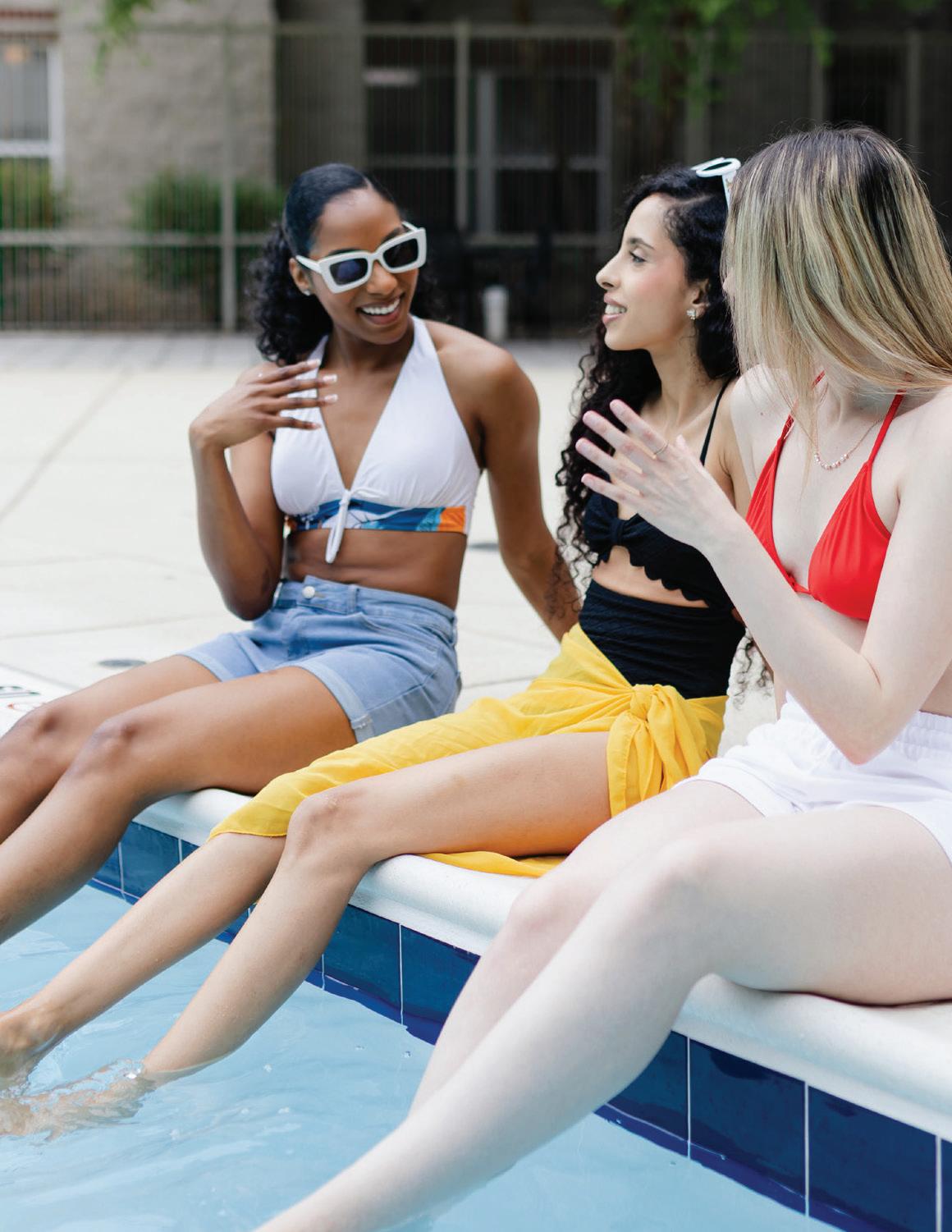
UMD freshmen re ect on their rst year in College Park
Freshman year of college is a trial run of adulthood and independence. It is often students’ first time away from family, friends and the safety net of home. But the unique opportunity to broaden your experiences and meet like-minded people is unmatched.
“The beauty of UMD is that it is absolutely huge,” said freshman finance and management major Carleigh Mahaney. “You’re gonna fi nd someone who matches your energy and who you want to spend your time with.”
For Mahaney, the opportunity to get to know someone new is always presenting itself and her interactions so far have been nothing but positive. The University of Maryland aligns perfectly with her dream to attend a school with “brick buildings and white pillars and a ton of people.”
Mahaney shared a favorite memory of her freshman year exploring Washington, D.C.’s various murals with friends in the Honors Humanities program. She said she was surprised by the amount of on and o campus opportunities apart from the “insanely good academics.”
By So a Appolonio and Joe Wicke I Diversions editors
“There’s so much to do, there’s always people to hang out with,” she said. “The best decision that I have made was deciding to come to Maryland.”
Jordan Richard, a freshman finance and theatre major, enjoys the newfound sense of freedom and the opportunities for personal growth as a university student. He also reflected on meeting new people from all walks of life.
“It was the first apartment party I went to fall semester, where I got exposed to pretty much every major, every grade, from all different backgrounds in one space where we could all hang out … and just share common experiences and joys,” Richard said.
The university’s size is exciting for some, but can be intimidating to others. Freshman public health practice major Madelyn Kinney was “terrified” coming to this university because of its size. But with any big school, there’s the possibility to “make it smaller,” she said.
“I think my favorite part about being a freshman at UMD so far has been all the opportunities it has to o er,” Kinney said. “It really just feels like this one big
playground for young adults, where you can kind of do whatever you want and explore di erent interests and talents.”
Kinney said she’s enjoyed the chance to be in clubs, such as The Petal Project and Public Health Beyond Borders, which have been a great opportunity for her to meet new people and interact with the campus community.
“You’ll be able to find your little niche within this big school,” Kinney said as advice to incoming freshmen. “Keep your options and mind open to everything.”
Richard’s advice for incoming freshmen is to say hi to everyone and remember everyone is experiencing similar feelings of nervousness. He’s looking forward to making more memories with his theatre peers and gaining more networking connections at this university.
For Mahaney, she said to enjoy all the university has to o er.
“It’s nice to know that there will always be people to meet, always be things to do in these next four years,” she said.
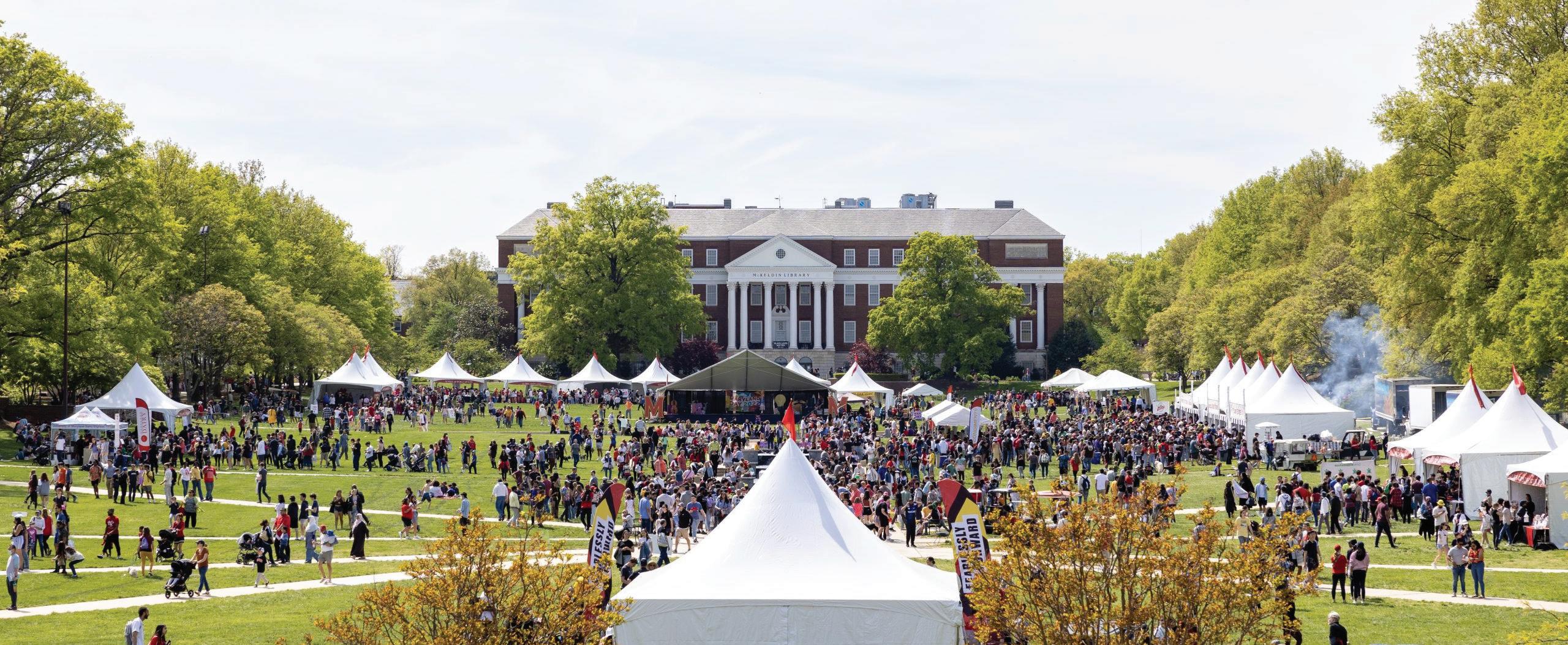
Here’s what to know about international student visas
WHAT ARE STUDENT VISAS?
Student visas are legal documentation that grant international students a temporary stay in the U.S. after they have been o ered admission to a school in the country.
F-1 visas are given to international students who are coming to the U.S. for academic purposes, according to USAGov, while J-1 visas are given to foreign nationals and exchange students who participate in a work or study exchange program.
This university has more than 4,990 international students, this university wrote in an April statement to The Diamondback. Eighty-four percent of these students have an F-1 visa, four percent have a J-1 visa and 12 percent have another non-immigrant visa.
International students who are applying for an F-1 or J-1 visa must submit documents, such as a passport and financial records, to receive a Certificate of Eligibility from an educational institution, according to this university’s International Students and Scholars o ce. They then must pay a fee and participate in an interview.
International students are well-documented to reassure the government about the progress of international student programs and to ensure all students are legitimately admitted, Madeline Hsu, a history professor and the director of the Center for Global Migration Studies, told The Diamondback.
WHY ARE STUDENT VISAS BEING REVOKED?
O cials from this university have met with federal delegations to ask why student visas are being revoked, but have not yet had their questions answered, university president Darryll Pines told The Diamondback.
Visas are commonly revoked due to a student’s appearance in criminal record checks, immigration attorney Hassan Ahmad said during the Council on American Islamic Relations’ “Know Your Rights” ICE protection webinar on April 16.
“The mere fact that you were cited or
By Nicole Pilsbury I Sta writer
arrested or at the wrong place at the wrong time, even if the charges were dismissed, even if there is absolutely no record and you did nothing — that’s enough now for the government to move to revoke a visa,” he said.
Some reasons for visa revocation are suspected immigrant intent, suspected status violation, suspected unapproved employment, lack of qualification, fraudulent use or arrest, according to this university’s International Student and Scholars Services o ce.
“It’s very, very unclear, which adds to the sort of anxiety and the uncertainty of the situation, because it really feels like anybody could … have this happen to them,” Hsu said.
More than 1,000 student visas have been revoked since U.S. President Donald Trump took o ce in January, the Associated Press reported Tuesday. Some students have had their visas revoked after participating in pro-Palestinian protests and demonstrations, the outlet reported in April.
WHAT HAPPENS IF A STUDENT VISA IS REVOKED?
The U.S. embassy or another U.S. government agency will email students if their visa is revoked, though written confirmation is not guaranteed, according to this university’s ISSS o ce website.
Students who are outside of the U.S. or leave the country after their visa is cancelled will have to reapply to return,according to the o ce’s website.
Students who have their visas revoked could risk detention by immigration authorities, according to the Associated Press.
“There is a lot of uncertainty because we are in an unprecedented situation,” Hsu said.
WHAT SHOULD STUDENTS DO IF THEIR VISAS ARE REVOKED?
Ahmad recommends that people who have had their visas revoked reapply and
file for a new visa as soon as possible because it is more di cult to obtain a new one overseas. The chance of getting a new non-immigrant visa after one is revoked is a “dim prospect,” he said.
“It’s not unheard of, but in this administration, once you’re outside of the United States trying to apply for a new visa, the chances of getting a new one once you your visa has been revoked is very slim,” Ahmad said.
People who have their visas revoked should notify this university’s ISSS o ce and provide the revocation notice, according to its website. The o ce advises people who have had their student visas revoked to speak to an immigration lawyer about their status.
Immigration attorneys can help people who have had their visas revoked develop a plan, such as drafting a writ of habeas corpus, which refutes the legality of a detention or arrest, Ahmad said. He explained that he looks at a client’s immigration and criminal history to determine if a writ of habeas corpus is needed.
Some students at this university who had their visas revoked have chosen to leave the country and attempt to re-establish their visas, Pines told The Diamondback on April 23.
The ISSS o ce is monitoring student visa databases and keeping students informed to ensure their paperwork is up to date, he added.
“Our international students and scholars are an essential part of our university community, and I obviously empathize with the uncertainties that many of them are facing,” Pines told The Diamondback.
Junior sta writer Sanya Wason and news editor Natalie Weger contributed to this report.
Stamp Student Union has several fast food restaurants. Some highlights include Moby Freestyle, Panda Express and Qdoba, which are all located in the main eatery.
The building’s popular Chick-fil-A is moving across the food court to the opposite storefront for more kitchen space, and there’s also a Subway in the food court, a co ee bar near the main entrance that serves Starbucks and a Panera Bread on Stamp’s first floor.
If you’re in a rush, you can also head to Stamp’s convenience shop to assemble your
CAMPUS CAFeS
Applause - The Clarice Smith Performing Arts Center
Breakpoint - The Iribe Center
E+M Cafe - Kirwan Food Court
Creative Commons - Tawes Hall
Food for Thought - The Edward
ON-CAMPUS DINING
own meal. You can grab a quick packaged and prepared sandwich and add on fruit, yogurt or a bag of chips.
Stamp is also home to the Dairy, an ice cream shop that serves a wide variety of university-crafted flavors, such as Fear the Turtle and others based on this university’s athletic coaches.
There’s also many choices outside Stamp. Cafes with standard convenience store fare are scattered across campus in academic buildings and usually have relevant or corny names, such as Applause
St. John Learning and Teaching Center
Footnotes - McKeldin Library
IDEA Central - IDEA Factory
Quantum - The Physical Sciences Complex
Rudy’s - Van Munching Hall
Sneaker’s - Eppley Recreation Center
at The Clarice Smith Performing Arts Center and Quantum in the Physical Sciences Complex.
Every Wednesday from April through mid-November during the spring and fall semesters, the Farmers Market sets up camp at Tawes Plaza and o ers produce, eggs and pastries, as well as some specialty products such as jewelry and beeswax products. Everything sold at the market is grown or produced by the vendor selling it.
dining options at stamp
Chick-fil-A
The Co ee Bar
The Dairy Qdoba
Hibachi San Moby Freestyle Panda Express
Subway Union Pizza Panera Bread
*This article is part of The Diamondback’s 2022 Orientation Guide. Some information and resources have been updated to reflect current dates and events.



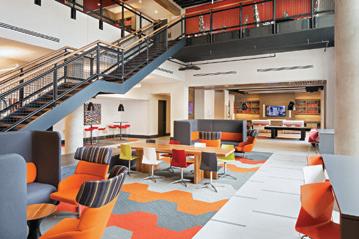



















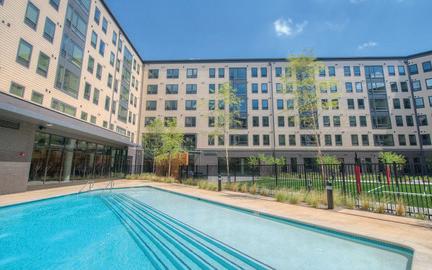




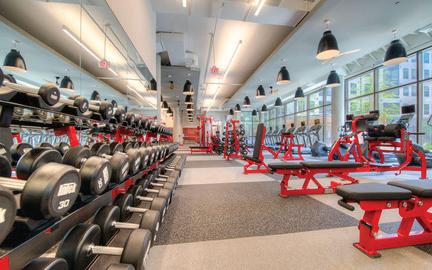




Taqueria Habanero, Arepa Zone among restaurants opening in College Park soon
By Keira Hardesty I Sta writer
Several new retailers and restaurants entered the College Park business scene this spring, with others expected to open later this year. Here’s a look by location at what’s recently opened and what’s coming to the city soon.
Union on knox
The Union on Knox apartment complex, which houses Shake Shack, Insomnia Cookies and Chopt Creative Salad Company, will add Duck Donuts, Pho Thom, BOHO Nails and Berries & Bowls in the coming months.
Chopt Creative Salad Company, a salad chain with more than 90 locations across 10 states and Washington, D.C., opened in the complex on March 26 Duck Donuts and Pho Thom will open this summer, Terrapin Development Company vice president Tom Parker said. Pho Thom is relocating to the complex from its previous location on Route 1.
Berries & Bowls, a smoothie restaurant based in Montgomery County, and BOHO Nails will open later this year, Parker said.
Route 1
PrimeTime, a sports-themed bar and restaurant opened in the Cambria Hotel on March 27. The restaurant o ers steaks, burgers, salads and more, according to a news release from the restaurant.
The retail space under The Varsity apartment complex will house Maryland Tandoor, an Indian bistro. The restaurant will open sometime between the end of May and mid-June, chef and owner Neel Kamal told The Diamondback.
The restaurant will be tailored to college students, with a ordable meals such as kebabs and curry, and job opportunities for University of Maryland students, Kamal said.
Taqueria Habanero, a restaurant that specializes in Mexican cuisine, opened on May 9 next to Marathon Deli. The eatery
was previously located in Campus Village Shoppes before the shopping center was shut down in 2023.
Raising Canes is still in the process of construction and obtaining permits, but the company’s goal is to open in late August, according to Michael Williams, the city’s economic development director.
City hall plaza
Li Chun Cafe, which offers Chinese cuisine such as cucumber salad and fried rice, opened in City Hall Plaza in March. It is run by the same owners as Northwest Chinese, another restaurant on Route 1.
college avenue
Vegan, plant–based cookie shop MidnighTreats opened in the building that used to house Insomnia Cookies in February, according to Jordan Rutland, the store’s owner.
Arepa Zone, a Venezuelan restaurant, will open in the Aster apartment complex this summer, according to Parker. Construction is in its final stages, Parker added, and Arepa Zone is likely to be open by the fall.
aster apartment complex closures
Little Blue Menu closed on May 1, which led to the mass layo of 91 employees, The Diamondback reported in April. The restaurant plans to renovate and add a dining room for customers before reopening later this year, according to Williams.
Roots Natural Kitchen, located on Calvert Road, closed on April 30, according to general manager Richard Cunningham. The chain, which o ers salads and grain bowls, chose to shut down the College Park location because it was too far from the University of Maryland campus, and failed to negotiate a reduced lease price, Cunningham said.
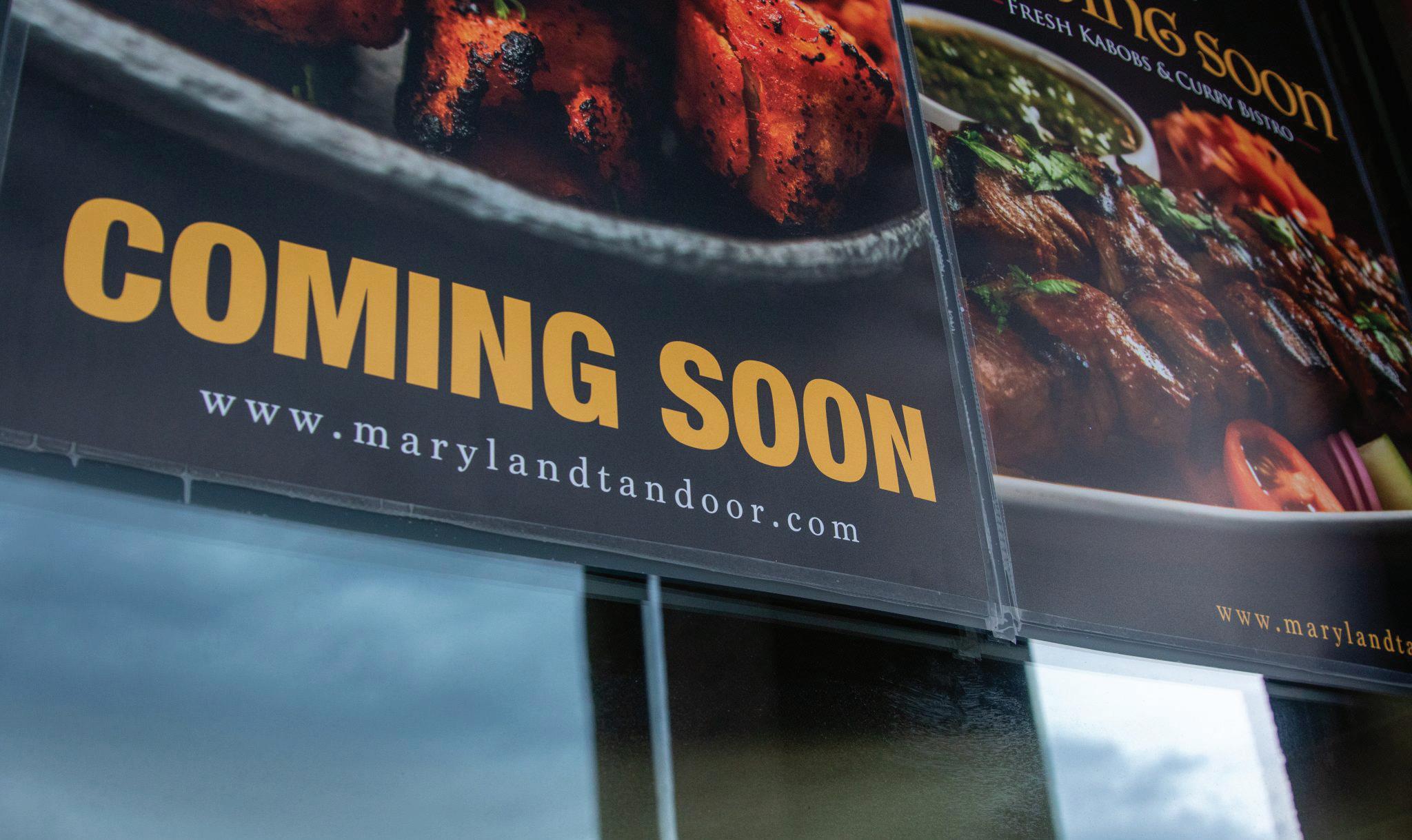
UMD releases report with recommendations for fraternities, sororities on campus
By Pera Onal I Assistant news editor
The University of Maryland released a report on May 7 with recommendations to improve fraternity and sorority life on campus.
The report was part of the Fraternity and Sorority Transformation Initiative, which was launched after this university temporarily paused some Interfraternity Council and Panhellenic Association activities last spring after allegations of hazing.
The report contained a list of recommendations created by three working groups: one for this university’s National Pan-Hellenic Council, one for both this university’s IFC and PHA and one for this university’s Multicultural Greek Council.
“Their integrated report o ers a roadmap for a stronger, more unified future across all four councils and 58 chapters,” this university wrote in a statement to The Diamondback on May 7.
Each of the working groups, which are com-
posed of students, alumni and sta , were tasked with assessing the state of its organization and chapters and offering recommendations to strengthen sta , educational programs and policies.
The working groups o ered nine calls to action to all four organizations in the report, including:
1. Requesting clear communication and transparency regarding staffing, role descriptions, policy procedures and support.
2. Hiring professionals to this university’s Department of Fraternity and Sorority Life who are dedicated to the success of their respective organizations.
3. Strengthening strategic partnerships with this university’s o ces and stakeholders, such as volunteers, graduate students and alumni.
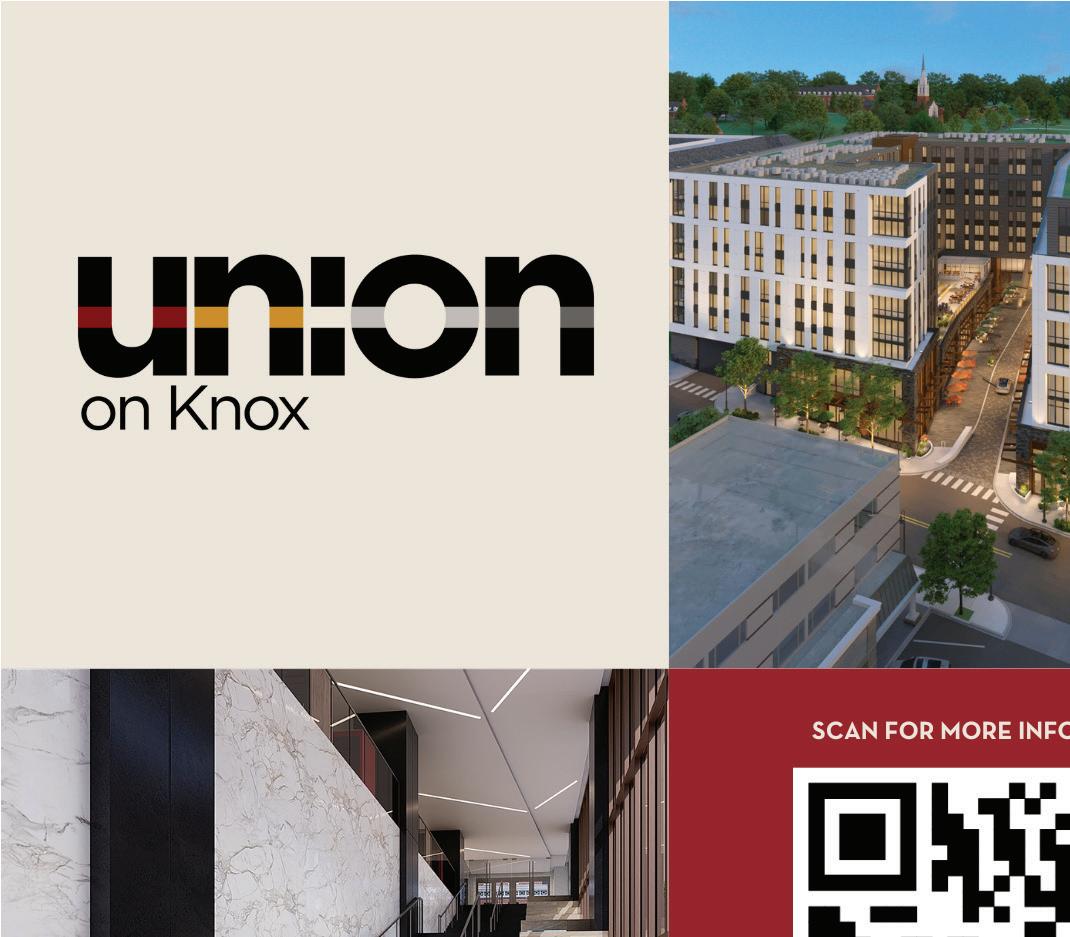
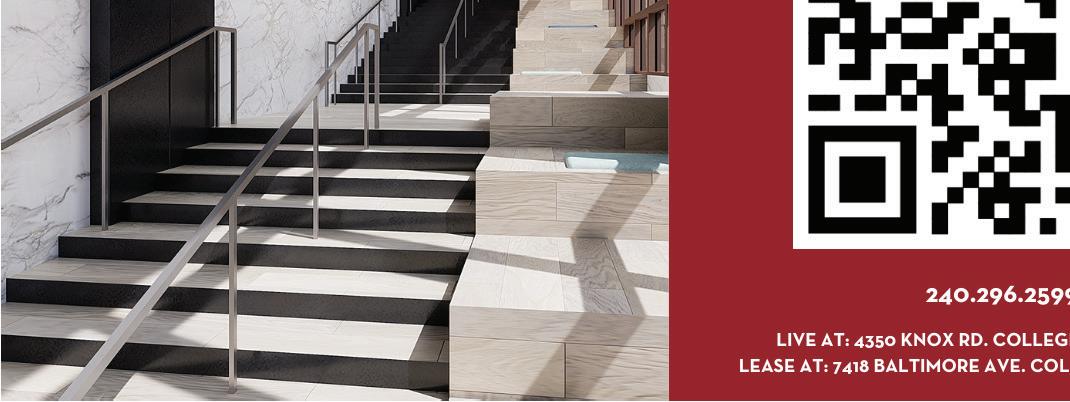
4. Establishing consistent internal communication through newsletters, websites and regularly scheduled meetings.
5. Enhancing data collections and analyses about student success, service hours and recruitment and retention metrics.
6. Collaborating with stakeholders to educate members and develop accountability methods.
7. Evaluating the functionality and sustainability of university-owned housing.
8. Promoting engagement with increased leadership training and incentive-based funding.
9. Creating extensive marketing and outreach strategies to improve accessibility and highlight experiences of students involved in Greek life.
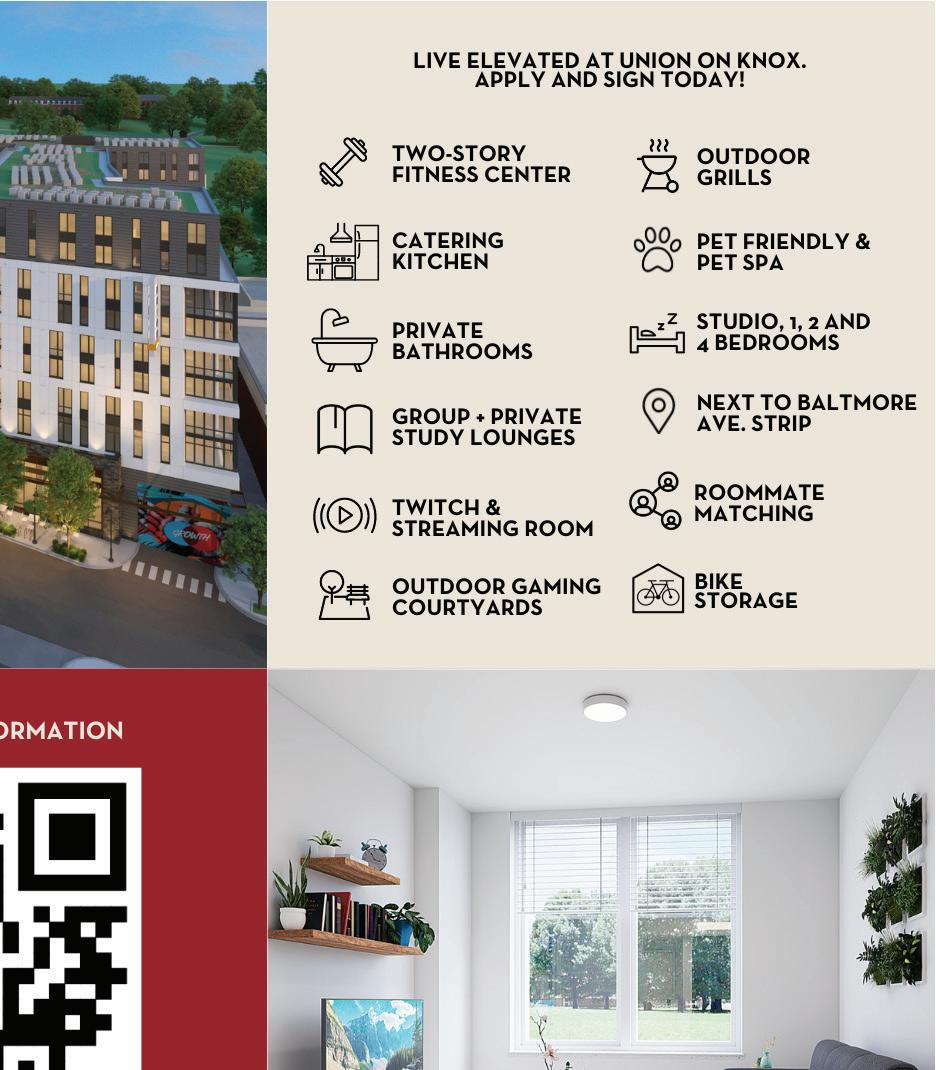

Specific recommendations for NPHC include inclusive training and collaboration in the form of “cultural competency training” for this university’s Department of Fraternity and Sorority Life sta , fostering international partnerships and reimagining diversity training requirements.
The report suggested that updating this university’s hazing-related policies and procedures, requiring hazing prevention education plans with “consequences for noncompliance” and improving transparency in violation reporting could help prevent hazing in IFC and PHA chapters.
These recommendations come more than a year after this university placed a cease and desist order on all IFC and PHA chapters last March after a notice of several chapters conducting activities that posed threats to community members’ safety, The Diamondback reported last March.
This university placed a two-week suspension on all new member activities for the organizations, along with a pause on alcohol use at social events.
During the two-week pause on activities, this university investigated student safety in IFC and PHA organizations, according to Wednesday’s report. The investigation resulted in five IFC fraternities facing student conduct charges based on “credible evidence of hazing,” the report read.
Four IFC fraternities filed a lawsuit against this university on March 13, 2024, alleging that the university violated free speech rights, The Diamondback reported last April. A federal judge dismissed the case in April.
According to the report, this university’s Department of Fraternity and Sorority Life will execute the report’s recommendations by conducting meetings solely focusing on implementation.
An implementation advisory team will also be created with members of different campus
o ces including the Stamp Student Organization Resource Center, the Department of Resident Life and the student conduct o ce.
This university looks forward to exploring the working groups’ recommendations, according to the statement.
“Through shared responsibility, collective e ort, and sustained support, we remain committed to fostering a strong and sustainable future where all chapters and councils can thrive individually and collectively,” the statement read.
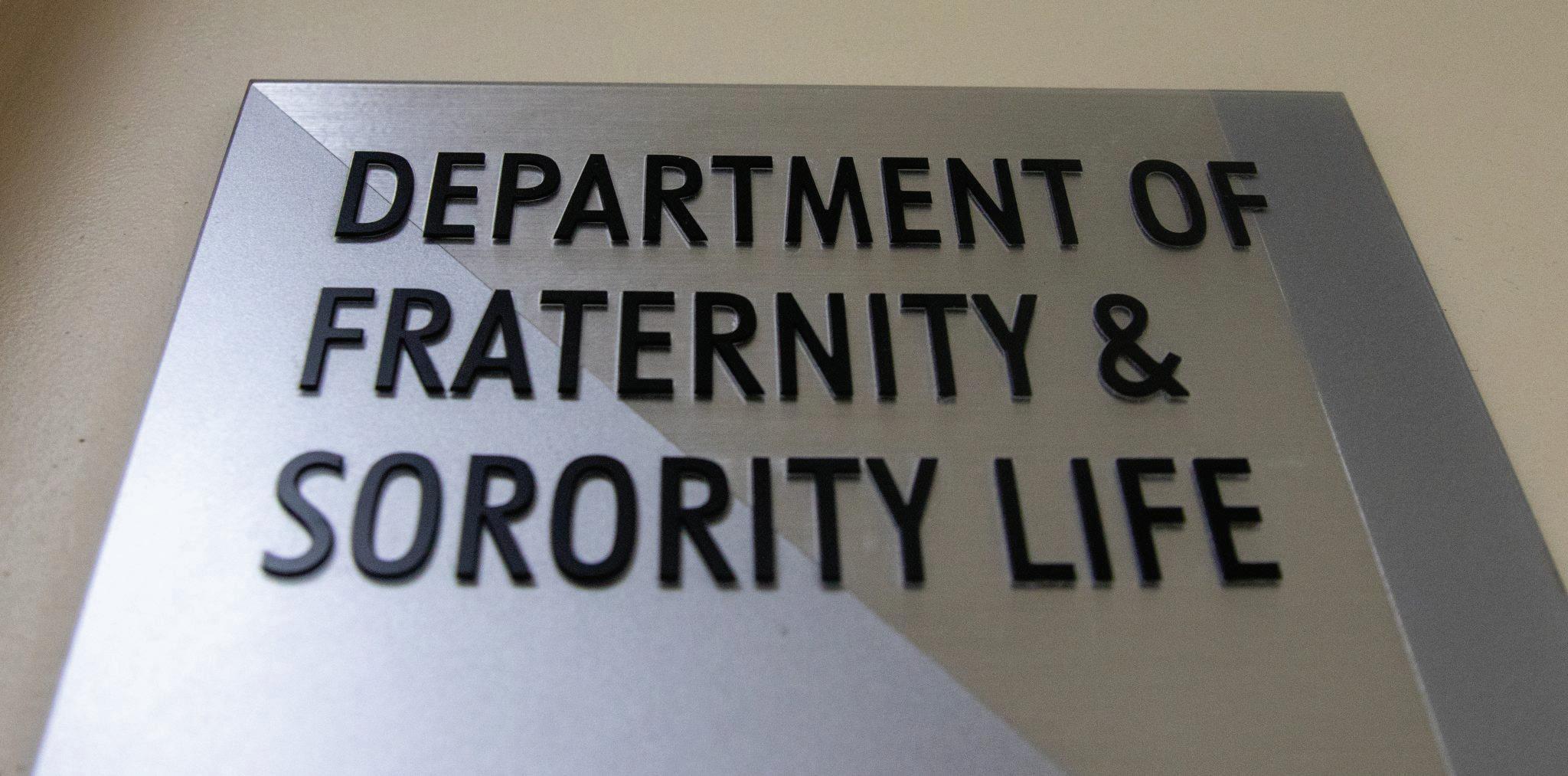

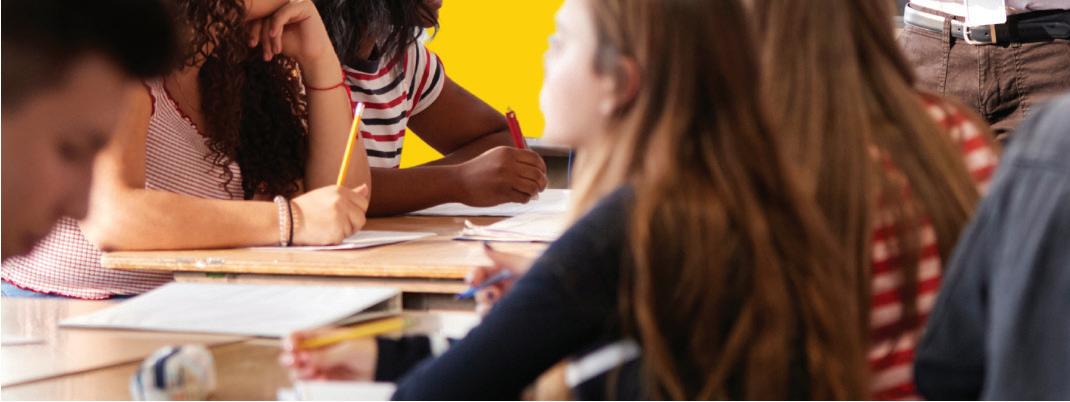
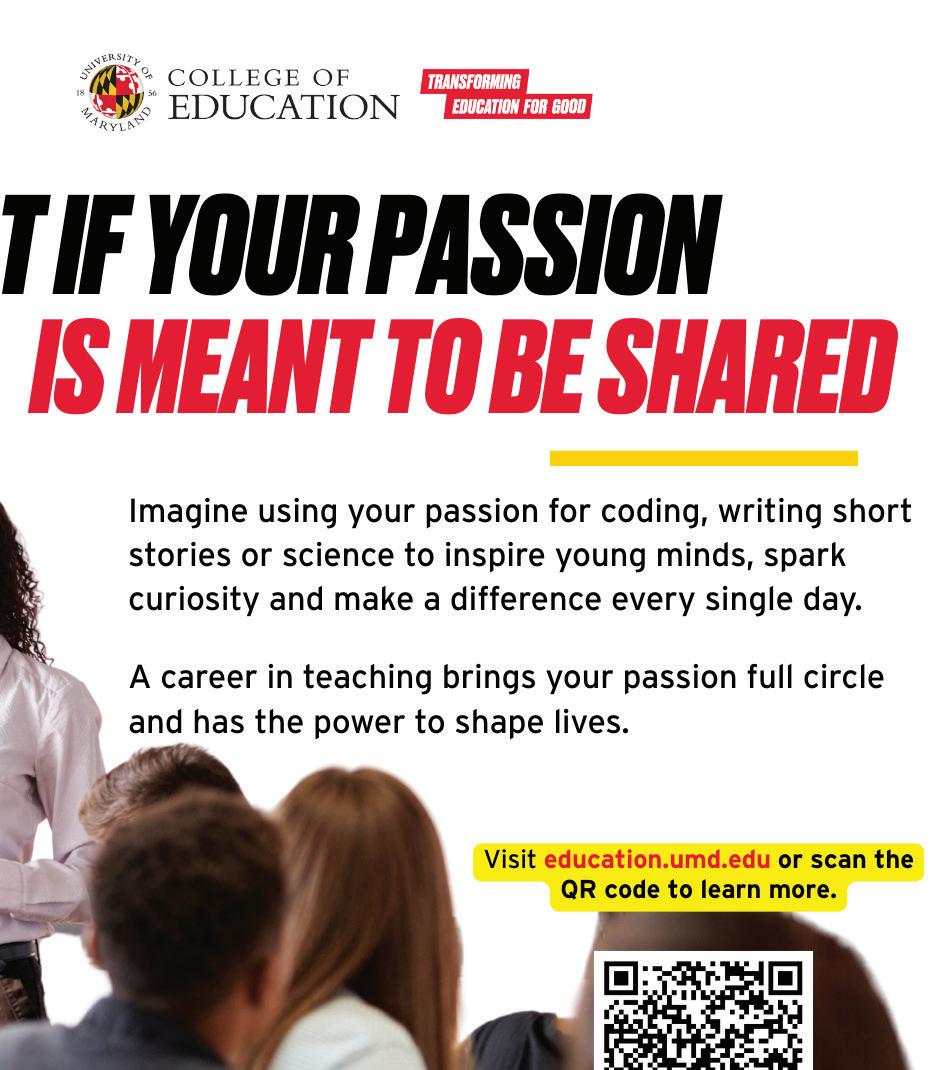

UMD achieves accelerated carbon neutrality goal by Earth Day
By Katherine Schutzman I Sta writer
The University of Maryland achieved its accelerated goal of carbon neutrality by Earth Day 2025, according to an announcement from this university’s sustainability department.
Carbon neutrality describes the balance when the amount of greenhouse gas emissions are canceled out by the amount reduced in the atmosphere, which results in zero net carbon emissions, according to this university’s 2009 Climate Action Plan.
The plan listed an initial goal of reaching carbon neutrality by 2050. But in his 2021 inaugural address, university president Darryll Pines announced an expedited goal of April 22, 2025.
“It clearly benefits the environment, number one, by reducing our carbon footprint of the 53,000 people that support this institution,” Pines told The Diamondback in February. “We serve as a leader to the rest of
higher education.”
The university aimed to reduce vehicle reliance on gasoline and diesel and took measures to conserve energy in campus operations were methods used to achieve this goal, according to the announcement.
This university’s carbon offset program website said the university helped neutralize carbon emissions through renewable energy projects and methane capture — a process where landfill gas is extracted before escaping into the atmosphere and converted into renewable energy.
This university’s Climate Action Plan 3.0 was published in 2024 and describes this university’s reduction of greenhouse gas emissions and energy consumption, and this university’s sustainability education program for first-semester students. More than $3.27 million in sustainability fund grants have also been awarded to students and faculty for sus-
tainability research and programs, according to the action plan.
The action plan also detailed future sustainability goals and plans, including transitioning to an all-electric vehicle fleet by 2035.
But transportation services director David Allen said at a March Residence Hall Association meeting that recent federal policy hindered the construction of new electric buses for this university, The Diamondback reported.
This university is still on track to achieve its electric bus goal by early 2035, Pines told The Diamondback in February. Pines also said this university hopes to have a fully fossil-fuel free energy system through its NextGen Energy Program, a public-private partnership aiming to sustainably adapt this university’s energy system, by 2035.
News editor Natalie Weger contributed to this report.






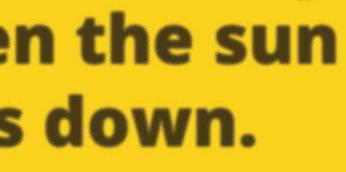
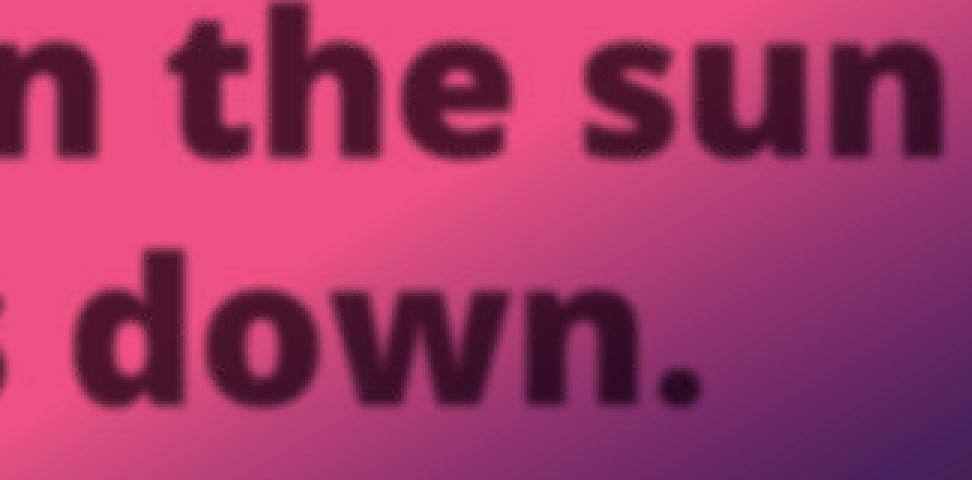
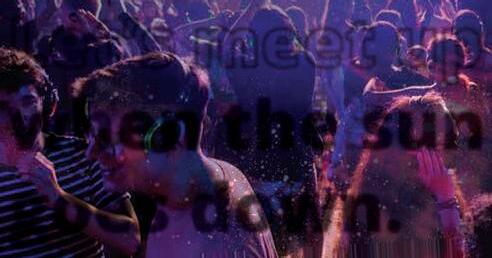
HAVE NEW EXPERIENCES AND MAKE SOME NEW FRIENDS DURING THE FALL SEMESTER! JOIN THE DIVISION OF STUDENT AFFAIRS AND CAMPUS PARTNERS FOR UNIQUE AND FREE LATE-NIGHT EVENTS, INCLUDING: MOVIES MUSIC TRIVIA FOOD BOWLING BINGO SELF-CARE GAME NIGHTS ...AND SO MUCH MORE!
Maryland Gov. Wes Moore announces launch of Capital Quantum Benchmarking Hub at UMD
By Oliver Mack I Sta writer
Maryland Gov. Wes Moore announced the launch of the Capital Quantum Benchmarking Hub at the University of Maryland, in partnership with the Defense Advanced Research Projects Agency on April 28.
The new hub will be based at this university’s Applied Research Laboratory for Intelligence and Security and will work with DARPA, a research and development agency of the U.S. Department of Defense, to analyze the success of quantum computing approaches over the next eight years.
The partnership will leverage $100 million in matched federal investments into Maryland’s quantum sector over the next four years and allow DARPA scientists to work with researchers from this university, Moore said.
“Quantum is going to have a remarkable impact on the human condition and its home is going to be right here in Maryland,” Moore said during the announcement.
The announcement, made in this university’s Discovery District, comes after Moore launched the $1 billion “Capital of Quantum” initiative in January. The initiative, launched in partnership with this university, is part of Moore’s plan to position the state and this university as a leader in the quantum industry.
The new partnership with DARPA will strengthen quantum e orts at this university, university president Darryll Pines, who previously worked at the agency, said during the announcement.
The Capital of Quantum initiative, a partnership between public and private sectors, plans to drive progress in quantum research, workforce development and industry collaboration by partnering with companies such as IonQ, a College-Park-based quantum research firm.
The initiative aims to generate $1 billion in investments over the next five years, which
the federal government will help contribute to through the DARPA partnership.
DARPA will work with this university to evaluate quantum’s national security uses and its commercial impact, Pines said.
“We are continuing to show the rest of the world that the place to be for innovation is right here in College Park,” Pines said.
The Capital of Quantum initiative also aims to further develop this university’s Discovery District and IonQ’s headquarters, hire at least 250 employees and support quantum startups, a January news release read.
“We are sending a very clear message to leaders in the public and leaders in the private sector,” Moore said. “Maryland is the epicenter for quantum computing research, full stop.”
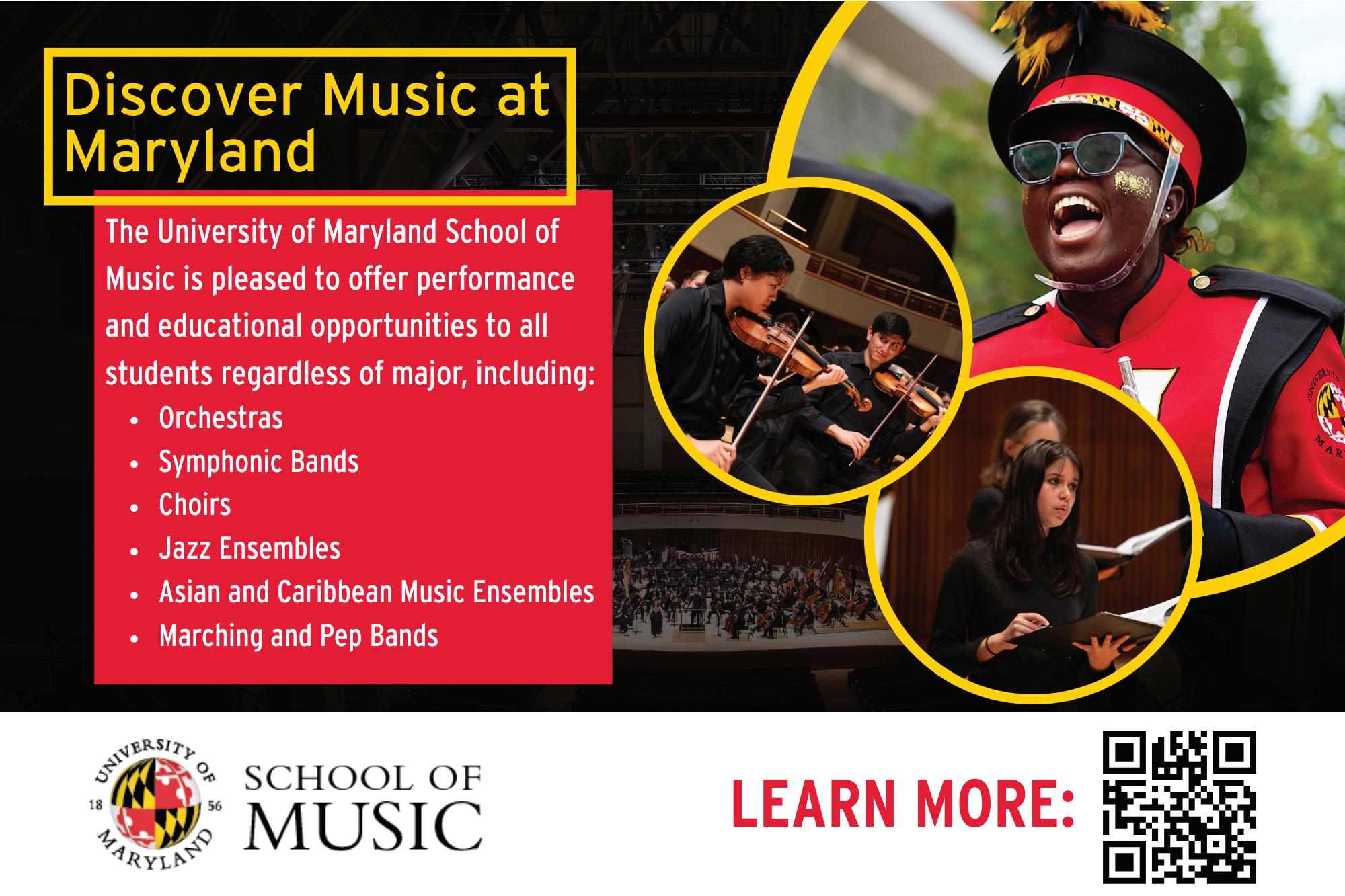
6 UMD students use $50,000 Do Good grant to combat food insecurity
By Katherine Schutzman I Sta writer
Six University of Maryland student interns have spent the past academic year combating food insecurity on campus using funds from a nearly $50,000 Do Good Institute grant.
The grant, which was awarded to the agriculture and natural resources college in spring 2024 to pursue a “hunger-free campus,” funded student internship positions at this university’s Community Learning Garden, Terp Farm, Campus Pantry and Counseling Center. The grant also funded conducting another campus food access survey, according to Meredith Epstein, a principal advisor and lecturer in the applied agriculture institute.
Students have worked at these locations during past summers, but the grant financially supported student internship positions during the academic year, according to Epstein. Working year-round gives
students a more comprehensive understanding of the work that goes into food production, she said.
“Gardening and farming and food security work are non-stop all year,” Epstein said. “The summer is just a snapshot.”
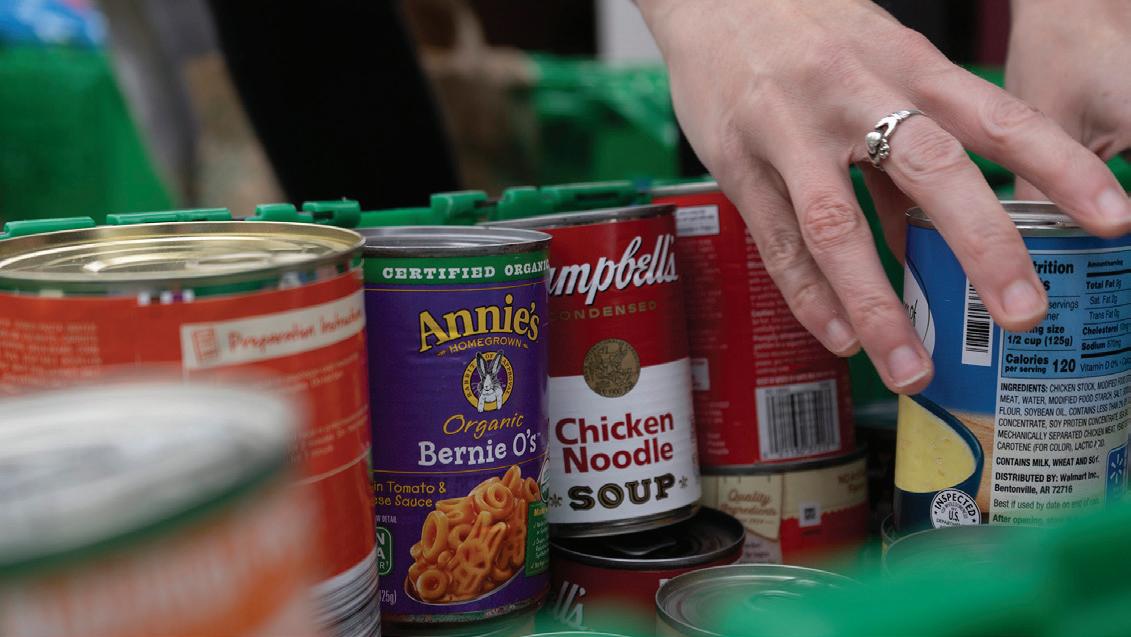
In spring 2023, about 27 percent of respondents to this university’s Food Access and Student Well-being Survey said they were food insecure, according to the report.
Intern Ellie Dugan began working at the Community Learning Garden over the summer and was able to continue her work at the garden during the school year because of the newly-funded internships, Epstein said.




















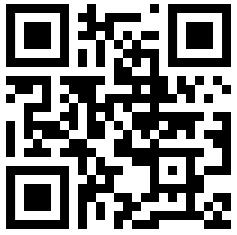




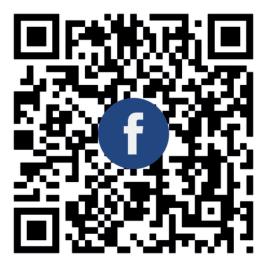






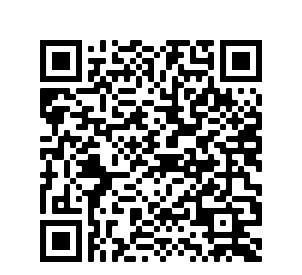
Dugan, a junior landscape architecture major, has given several presentations about her work in the garden and campus e orts to address food insecurity, Epstein added.
“She was able to foster a stronger connection between the garden and the Campus Pantry,” Epstein said. “It’s helping us really elevate awareness of what we do on campus and o campus.”
Dugan works in the garden at least once a week, where she maintains crops, leads volunteer groups and occasionally makes deliveries to the Campus Pantry, she said.
Seeing the demand and excitement for the food she helps grow is gratifying, she added.
“It feels nice knowing that we’re part of the overarching e ort to alleviate food insecurity,” Dugan said. “People are benefiting from the work that I do in a tangible way.”
University community members carry out similar food production e orts about 15 miles from campus in Upper Marlboro, where Terp Farm manager Guy Kilpatric supervises interns Ahmad Toure and Douglas Mejia-Guevara.
Toure and Mejia-Guevara work at the
farm two days a week, helping plant and harvest vegetables for this university’s three dining halls and the Campus Pantry, according to Kilpatric.
The farm grows certain in-demand crops, like garlic, for the Campus Pantry, Kilpatric said. The farm is able to address food insecurity by connecting a wide demographic of students through food, he added.
“We want to try to highlight not just the quality of the food that we’re producing, but to try to relay stories about how it was produced and why it’s important,” Kilpatric said.
Epstein also taught the intern cohort how to write grant proposals and walked them through the process, she said.
Toure and Mejia-Guevara recently applied for and received a sustainability mini-grant to fund a new compost spreader for the farm, according to Kilpatric.
This past year, Campus Pantry interns Kerra Dukes and Zakiya Suleman helped organize and maintain the pantry, according to Lindsay Barranco, the applied agriculture institute’s experiential learning coordinator.
The Campus Pantry saw more than a



60 percent user increase between 2022 and 2023, The Diamondback reported in April 2024.
During the academic year, Barranco organized regular meetings for the interns to share updates and experiences from their respective positions. It is meaningful for students to see how their roles fit into the process of feeding community members in need, Barranco said.
Barranco said ideally, similar paid internship opportunities will continue in the future, but funding is necessary.
While the program’s long-term goal is to eliminate food insecurity on campus, managing an entirely volunteer-based workforce is di cult to maintain, she said. Barranco added that she hopes the work done through the Do Good grant this year will set the standard for future projects.
“We want people to have enough food and to be able to afford enough food, but that’s not the reality,” Barranco said. “Continuing the research and having sort of precise knowledge as to what the need is here, in terms of the research surveys, that’s a really important component.”
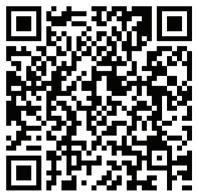

Hundreds of UMD community members gather for second annual Big Queer Photo
More than 400 University of Maryland community members gathered on McKeldin Mall on May 8 to pose for the LGBTQ+ Equity Center’s second annual Big Queer Photo event.
The event aimed to create a welcoming community by celebrating LGBTQ+ community members and allies across campus, according to the equity center’s director, Kristopher Oliveira.
“Despite all the things that are going on in the world, [this university] is a really inclusive place, and it has absolutely filled my cup to see this many people turn out today,” Oliveira said. “It’s been a really special day, and I’m really grateful.”
Oliveira said the event saw a larger turnout than the previous year’s photo, which had about 330 people. More people joined the event after walking by and seeing the crowd’s size, he added.
This university was ranked as the nation’s top LGBTQ+ university in 2023 and
By Sanya Wason I Sta writer
has remained in the top 25 since 2020, according to BestColleges’ annual rankings.
In addition to the annual Big Queer Photo, the LGBTQ+ Equity Center hosts events such as daily Queer Recess, film screenings and book talks. The center also provides gender-a rming care, health and wellness resources and counseling services.
Rachel Gaziano, who works for the marketing and communications o ce, said she attended the photo for the first time to show support for LGBTQ+ community members at this university.
Gaziano told The Diamondback that she hopes events like these help foster a wider, and more secure, sense of LGBTQ+ pride and community.
“[I have a] huge amount of pride that [this university] does this, and that the LGBTQ+ Equity Center is so visible and prominent, especially this year,” she said.
Many students who attended last year’s
photo returned for the event on May 8, including senior history major Holland Schmitz.
Schmitz, who has a LGBTQ+ minor focusing on queer scholarship, detailed a sense of pride for the inclusivity this university has for the queer community.
“This [photo event] is definitely an act of existence is resistance,” Schmitz said. “It’s important to show campus that we’re here, we’re queer, and we’re here to support.”
Junior studio art major Atlas Martinez also returned to be in the picture this year and was pleased in the growth and organization of the photo’s process. Martinez enjoyed celebrating his identity freely, he explained.
“This is gonna be in the school record,” he said. “Someday, some other queer kid is gonna be looking through them and then they’re gonna see us.”
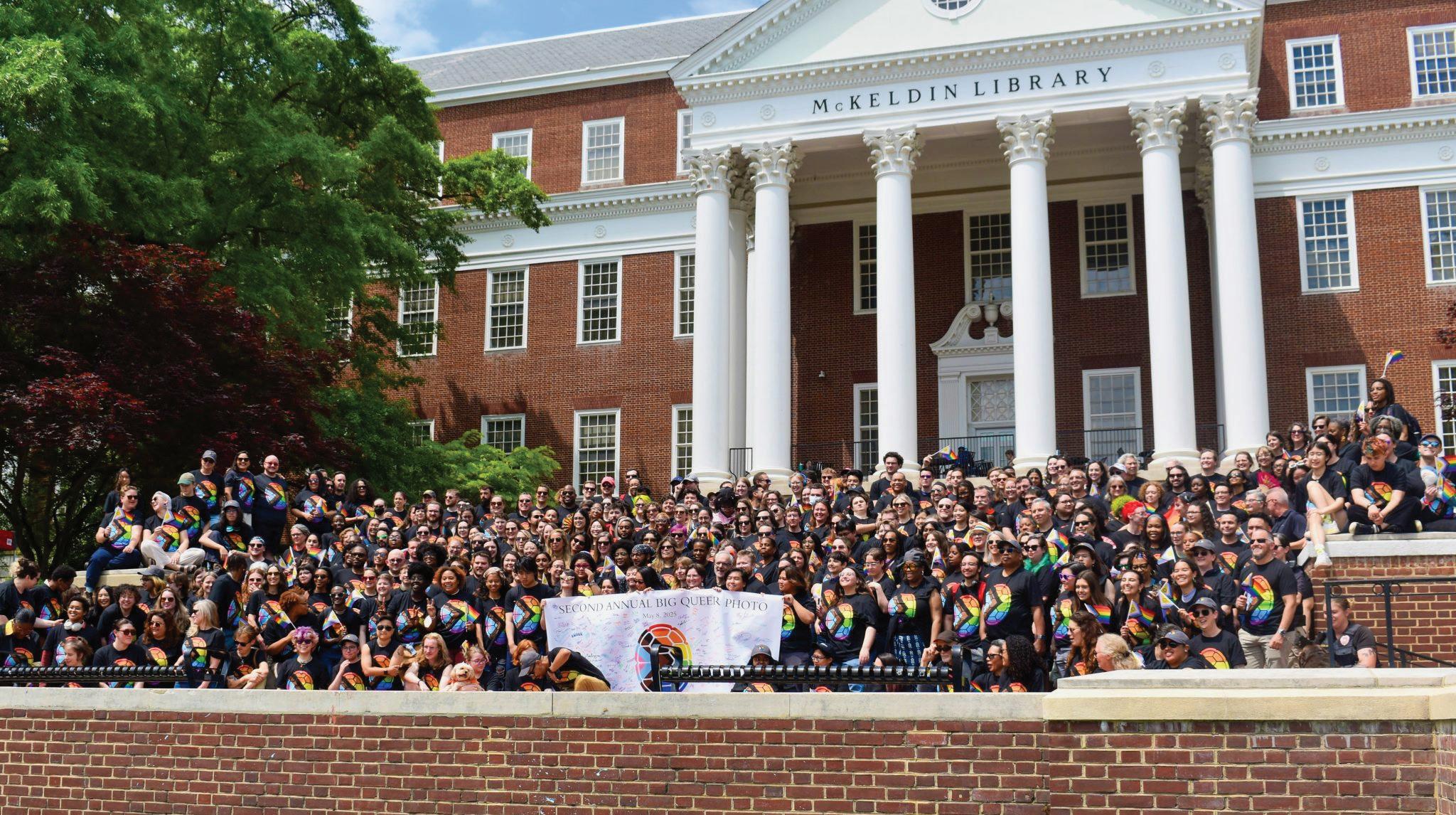
UMD students display projects at Hack4Impact spring showcase
University of Maryland computer science teams showcased projects they built for various nonprofit organizations at Hack4Impact-UMD’s spring project showcase at the Iribe Center on May 1.
Hack4Impact is a national organization with more than a dozen chapters at college campuses across the country that focuses on community philanthropy through software development. This university’s chapter, which has about 130 members, has worked with organizations including the Children’s Cancer Foundation, Camp Starfish and the Breastfeeding Center for Greater Washington.
One team at the showcase remade a management database for Food for All DC, a nonprofit organization that works to provide food to people in Washington, D.C. who are unable to easily leave their homes.
Graeme King, a volunteer coordinator with Food for All DC, ran into issues with the organization’s system. The old system — which was run through a series of spreadsheets that had to be manually entered — made it hard to organize deliveries and manage clients, King said.
The Hack4Impact team then revamped the organization’s old system, creating a much more intuitive and e cient system that volunteers can easily use, King added.
Junior computer science major Steven Ha, a tech lead for the project, said his favorite part of the project was routing. The new system his team designed created a visual map of each client, which allowed drivers to coordinate the food they were to deliver.
Another team at the event
By Miguel Zarate I For The Diamondback
worked with Camp Starfish, a summer camp focused on children with social and emotional development challenges.
The team is developing a system that can organize the camp’s photos in a Google Drive so only certain people have access to photos for privacy reasons, according to sophomore information science major Harshitha Jeyakumar.
Jeyakumar said her favorite part of the project was working with people.
“It’s been a very rewarding of an experience,” Jeyakumar said. “I’m able to learn more about their roles and see how as a project manager I can support them.”
Nishtha Das, a human-computer interaction graduate student, said her team has spoken with parents of children within the camp. Das added that it was nice to hear about
the importance of the camp from the parents.
“It’s been life changing for a lot of these kids, so it’s really nice to be able to contribute to that,” Das said.
For Ha, finally making it to the showcase felt like finishing a “marathon.”
Along with the main showcase, Hack4Impact also recognized its graduating seniors. Those graduates included one of the student organization’s two executive directors, Sheldon Padgett.
Padgett, a senior computer science major, said he’s sad to be leaving the organization.
“I am so, so incredibly grateful for all the opportunities that it has given me,” Padgett said. “It’s really, really had a profound impact on the way that I’m gonna move forward in life.”
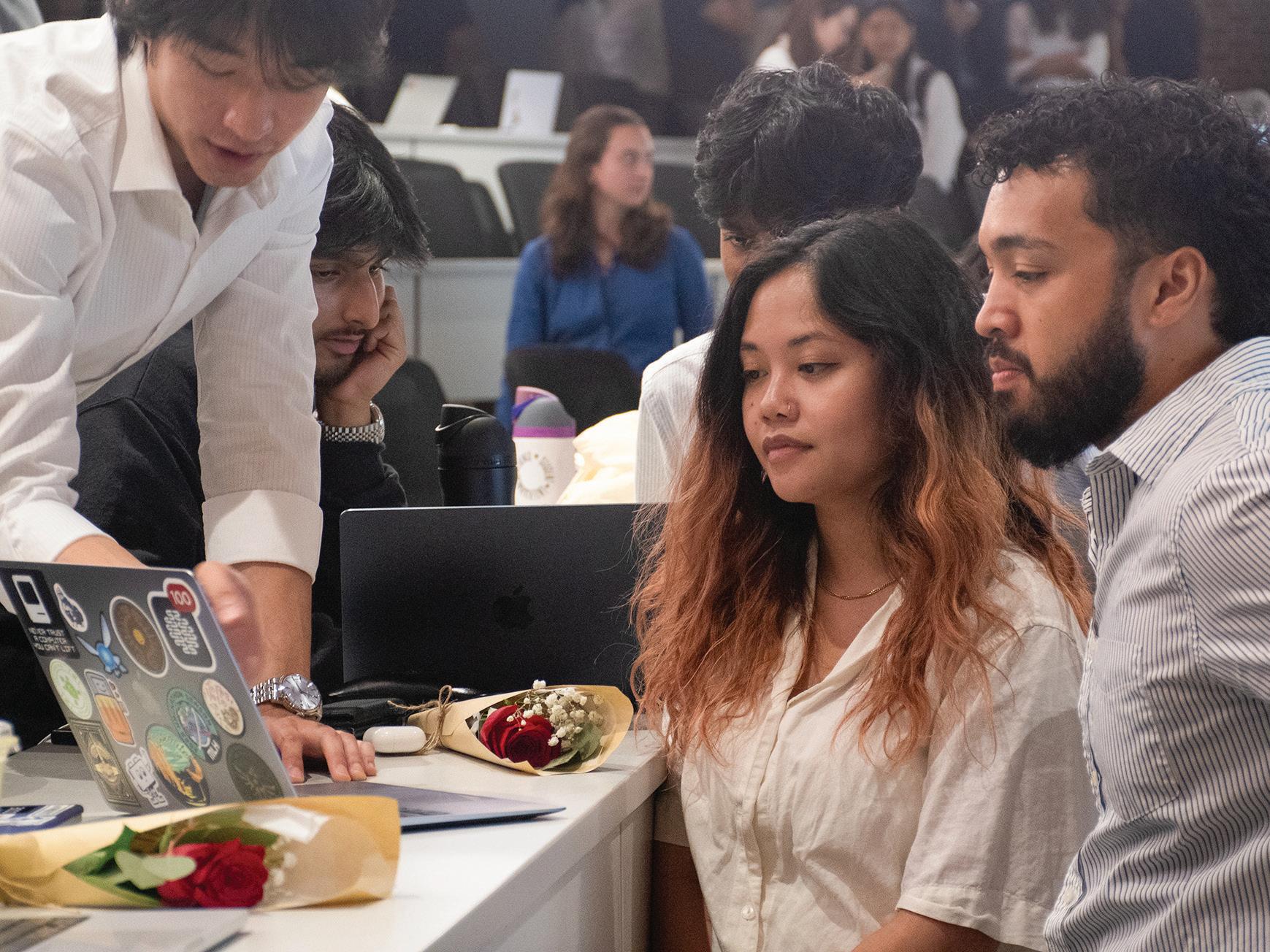
Juggling enthusiasts nd community, performance opportunities in UMD club
Jacob Skidmore wants to learn how to juggle flower sticks, long rods with tassels at each end that are controlled by two smaller sticks.
Holding one in each hand, he spins the uniquely shaped juggling prop, catching and throwing them into the air in a swift motion.
It’s one of many objects the sophomore education and English major is working to master as part of the University of Maryland’s juggling club.
Since 2003, the club has been home to jugglers of all skill levels and aims to maintain a relaxed atmosphere for all skill sets, according to club co-president and junior electrical engineering major Caroline Colangelo. While the group is open to anyone, skilled jugglers from around the area occasionally join in on meetings on campus.
While Skidmore joined his freshman year with no prior experience, he learned the basics of juggling in just two to three weeks.
“There are some people who stop by for one day and learn it in probably 15 minutes,” he said. “That’s always really, really impressive to see.”
Along with flower sticks, the club practices with unique objects like poi sticks, devil sticks, fake swords and diablos along with the classics like juggling balls, clubs and rings. Some members, including Skidmore, are learning how to juggle while riding a unicycle.
Colangelo said the club used to perform
By Talia Macchi I Diversionsreporter
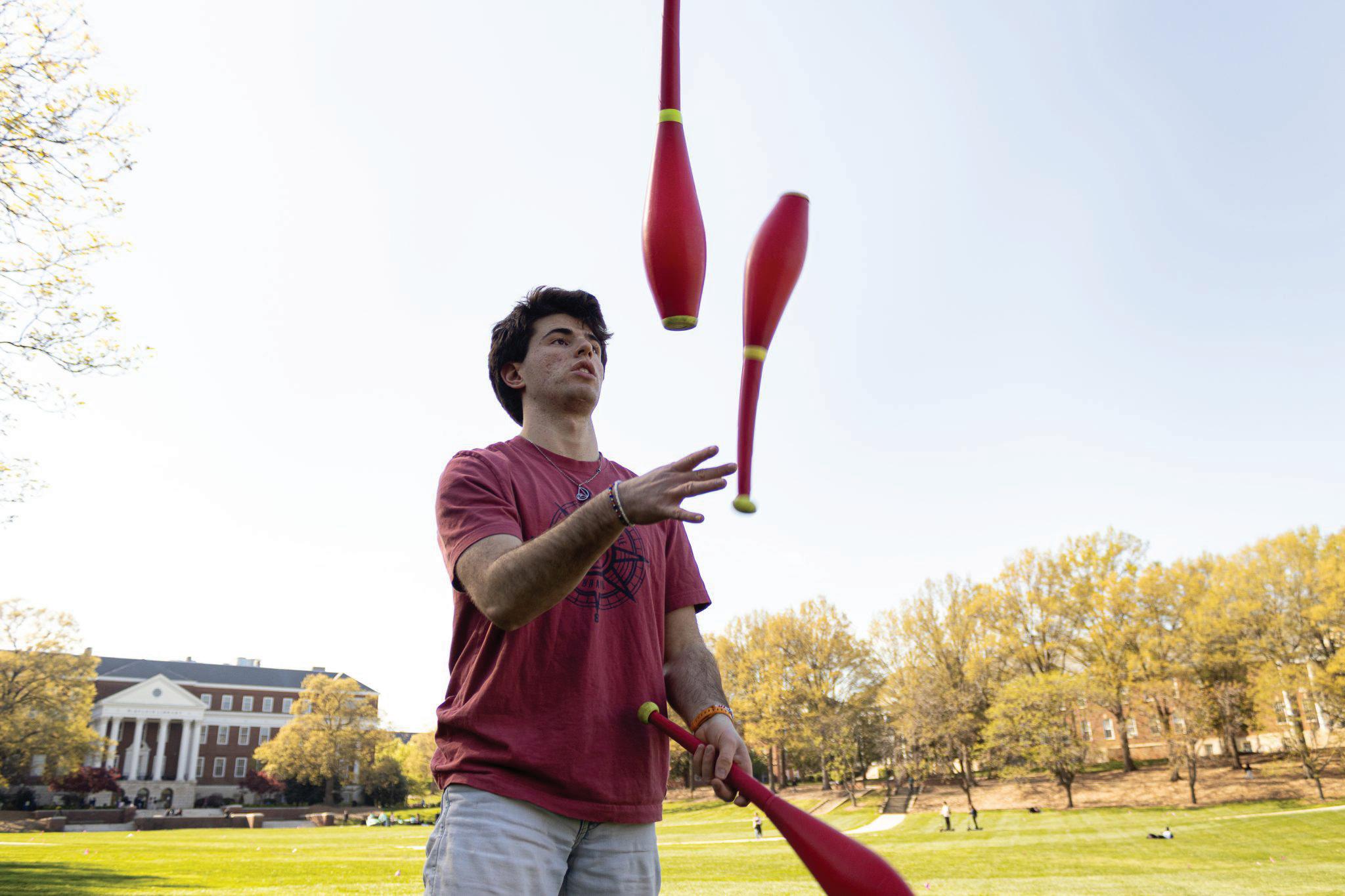
around campus and that it would be “really cool” to revive that tradition. Currently, opportunities for visibility and showcasing their skills are during practice and at the annual Congress of Jugglers — a convention that’s been running for more than 20 years.
Jugglers from across the East Coast gather at the event to attend workshops, perform, hone their skills and participate in ra es to support the club, according to club treasurer Roame Hildebrand.
“The aspect of teaching and trying new tricks is a good way of building trust between the members of the team and building that community sense that we’re working together to get better at what we do,” said Hildebrand, a senior mathematics and physics major.
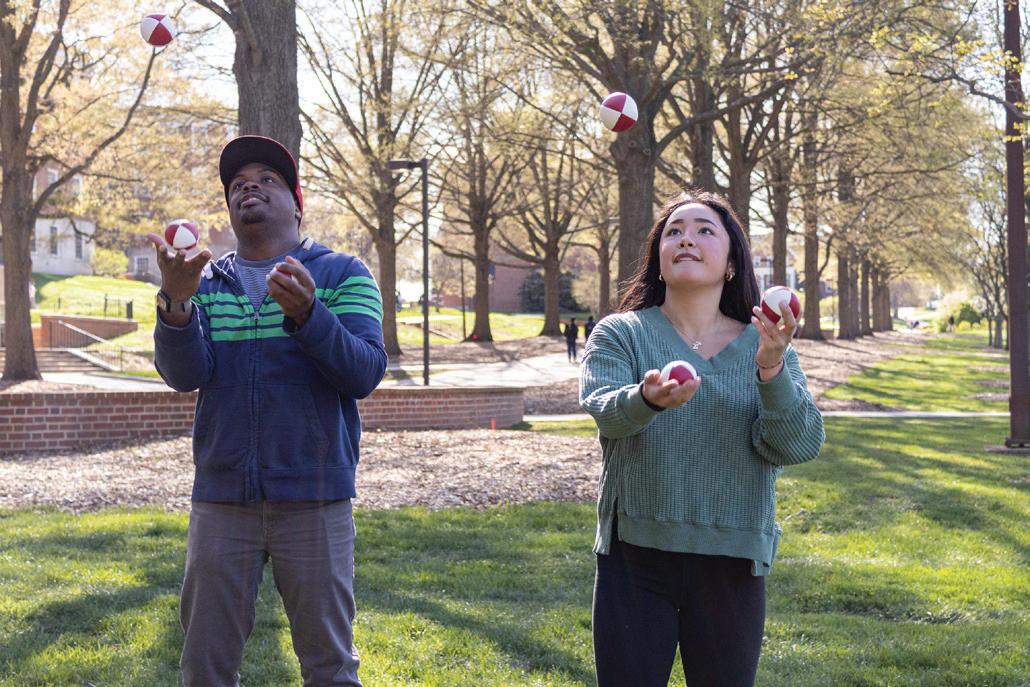
For Skidmore, juggling club is a space that he can go to take his mind o what is going on that week and “just juggle.” After attending the convention for the first time last year, he said it was one of the coolest
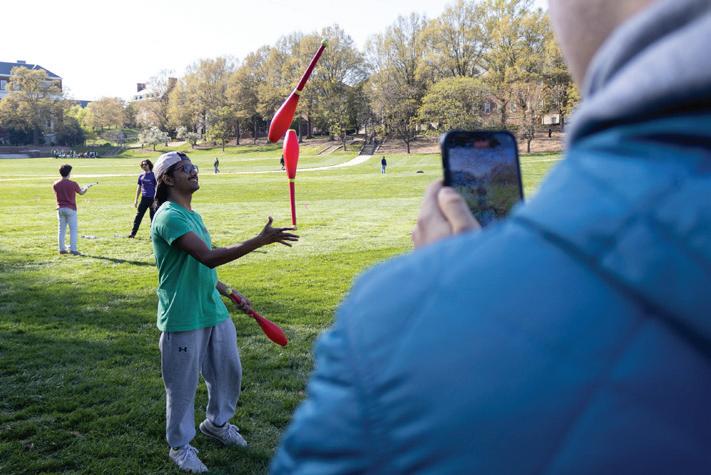
The club hopes to perform in shows and host workshops in the future. Colangelo aims to put together a ball making workshop next year and showcase the members’ skills at local senior centers and elementary schools.
While the club aims to expand its outreach, it also wants to preserve its relaxed, “just for fun” atmosphere, they said. “Everyone has to start from somewhere,” Colangelo said. “Anyone you ask in the club would gladly help teach you how to juggle … if you already know how to juggle and you want to learn a new trick or something, everyone’s very welcoming and kind.”

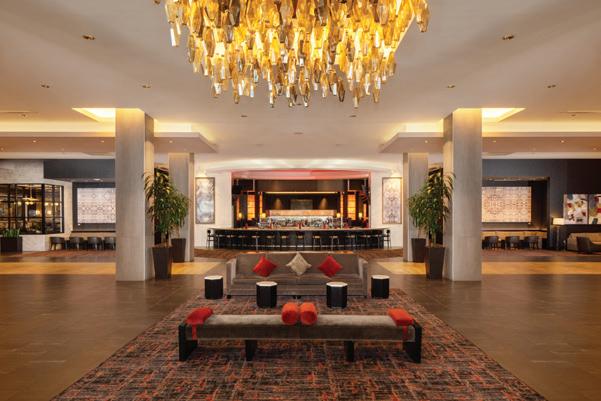
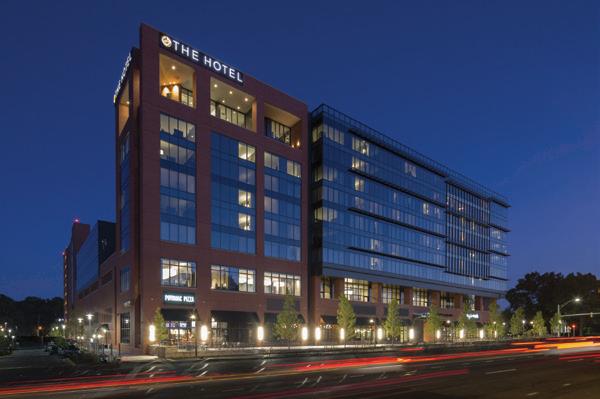

THE UNIVERSITY OF MARYLAND’S PREMIER HOTEL
The Hotel at the University of Maryland is a AAA Four-Diamond hotel that combines beautiful accommodations with exceptional amenities. Located across the street from the university’s main campus entrance, The Hotel is the perfect location for Terrapins — from families sending their students off to school or celebrating their graduation to fans heading to the big game.
▪ 297 guest rooms with one king or two queen beds
▪ Mini coolers, illy coffee machines, complimentary Wi-Fi and personal safes in every room
▪ Indoor swimming pool and wellness area
▪ Fully equipped fitness center
GrillMarX offers you a casual, upscale dining experience, serving hickory-grilled, hand-cut steaks, a variety of fresh seafood and uniquely crafted cocktails.
▪ The Spa, College Park's only boutique spa, offering massages, facials, nails and waxing
▪ Hair + Space, a premier blowdry and beauty bar, offering a wide range of salon services
Bagels ’n Grinds, home to the area’s best New York bagels made on site every morning, offers quick, made-to-order breakfast and lunch.
▪ The Lobby Bar and four unique restaurants
▪ Overnight parking available in our gated garage
▪ Complimentary shuttle service to Metro, campus and local destinations within a three-mile radius
Potomac Pizza offers fresh, delicious traditional and specialty pizzas, sandwiches, classic Italian dishes, salads and more.
At Iron Rooster, where the chicken is fried and the biscuits come with gravy, you can enjoy all-day breakfast, lunch or supper.
The Hotel at the University of Maryland | 7777 Baltimore Avenue, College Park, MD 20740 301.277.7777 | TheHotelUMD.com
Terrapin Trail Club upholds nearly 90-year history with close-knit outdoor community
By Cameron Lee I For The Diamondback
There are more than 800 student organizations at the University of Maryland, but few can say they started more than eight decades ago.
Terrapin Trail Club is a group devoted to all things outdoors and one of the oldest student-led groups on campus. What began as a small cohort of students planning impromptu hiking and camping trips has steadily evolved into a massive outdoor community. Hikers, bikers, campers, cavers, kayakers and more join with a main goal in mind — getting people outside.
“If you like to do a thing that isn’t in a building, we can probably hook you up,” said senior mechanical engineering major and president of Terrapin Trail Club Ben Talley.
Terrapin Trail Club t-shirts and stickers worn by members are inscribed with “Est. 1937,” a reminder of the club’s age and the legacy it upholds. Joseph Lavallee, the club’s historian, continues the tradition of keeping trip reports — detailed records that list the locations, activities and participants of each adventure while connecting the club to its past.
Every week, members look over flashback reports from the past, each cataloguing the week to week outdoor activities of the club throughout the years.
Club Vice President Kyle Bacon said there is humor and handy advice found in decades-old trip reports. He said “there’s survival hints, and
one of them is ‘do not pull down enormous branches without first checking that there’s not rotten logs on top.’”
At a time when many students spend most of their days inside, Kurt Kovacs, secretary of Terrapin Trail Club, says the club provides an outlet for students to take a break from their studies and devices and go outside and explore.
“The engineers need this,” the junior electrical engineering major joked.
Getting outside doesn’t just mean light hikes. Expeditions range near and far for all levels of ability, including casual walks around College Park’s Lake Artemesia to multi-day interstate treks encompassing dozens of miles. Bacon said most of the older traditions and expeditions continue today.w
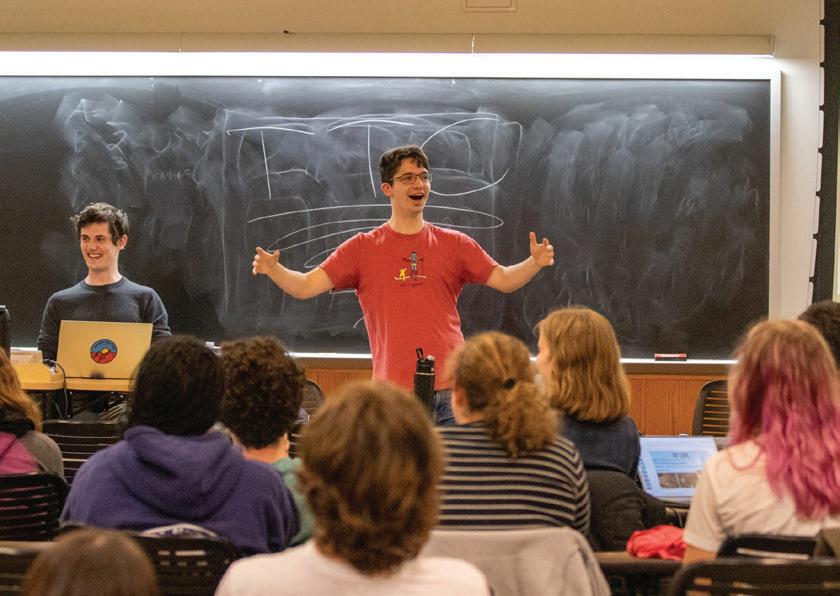
es will be a part of the four-state journey, such as “Music State,” where hikers play instruments on the trail.
One major tradition includes the Four State Challenge, one of the club’s most popular outdoor events. The 24 hour and nearly 50 mile hike begins at the Virginia border, continuing through West Virginia and Maryland before ending at the Pennsylvania border. For Talley, it was the “coolest thing [he] did in college.”
“Some of our trip leaders are crazy and will do a ton of miles of hiking,” Kovacs said. “The people that sign up for it, they know what they’re signing up for and it’s really fun.”
Members can decide what upcoming challeng-
Where other clubs have modernized, Terrapin Trail Club remains astonishingly similar to the past, said Lavallee.
“College is kind of rough sometimes,” Bacon said. “When you come here, you build this connection [with] friends and have people to not only just lean on in hard times but also do really cool stu with.”
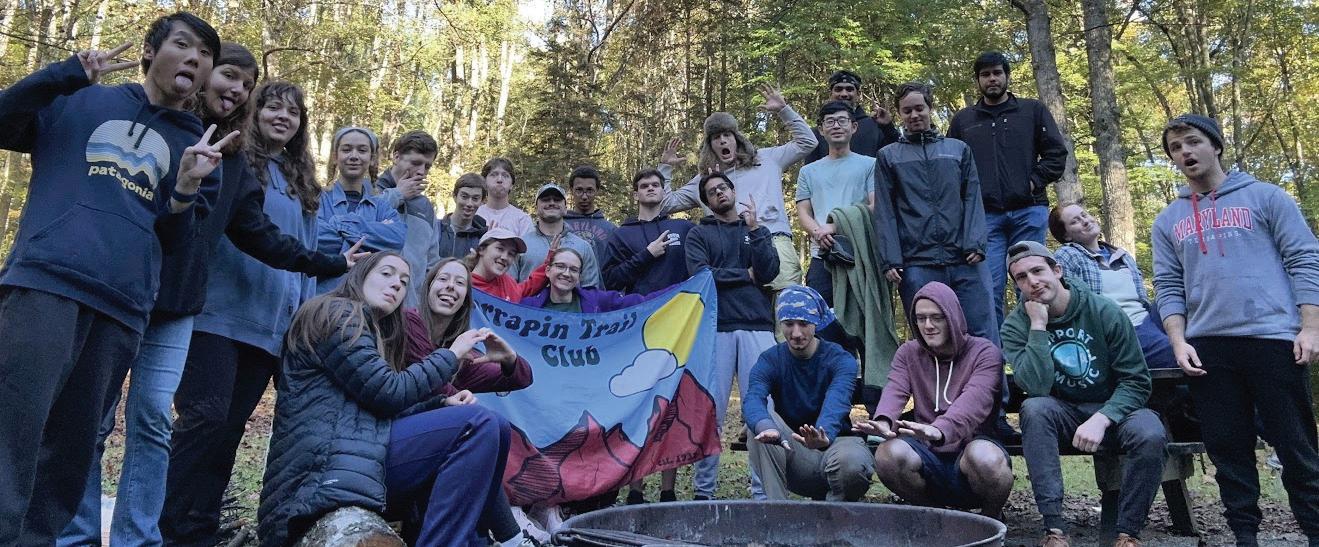
A childhood dream to reality: UMD alum re ects on experience as ‘Survivor’ contestant
By Amelia Twyman I Sta writer
CLARIFICATION: This story has been updated to better reflect that Rose encourages students to sendinanapplicationforCBS’sSurvivorshow.
Bianca Roses was 8 years old when the first season of CBS’s Survivor aired on national television. But from the moment she witnessed the show’s contestants drop down on an island in pursuit of a million dollar prize, she knew she wanted to play the game.
“‘I want to do this. I can do this kind of a thing,’” she remembers thinking as she watched cast members compete in elaborate challenges, build and betray alliances and sleep under the stars.
Twenty-five years and 48 seasons of Survivor later, Roses, now 33, has made her childhood dream a reality.
The University of Maryland alum appeared on the first five episodes of Survivor’s 48th season, where she competed against 17 other players in the Mamanuca Islands of Fiji. The season was filmed last summer and premiered on CBS on Feb. 26, according to Forbes.
Roses, who graduated from this university in 2013, is one of several alumni who have appeared on the show. Alumni Chelsea Walker, who also graduated in 2013, and Noura Salman, who graduated in 2004, both competed in the show’s 39th season, according to Maryland Today.
Roses said she grew especially close to fellow contestant Thomas Krottinger while on the island. The two were placed on the same original tribe, Lagi, and bonded over their puzzle-solving skills.
When other players voted Krottinger o — one episode before Roses’ own elimination from the show on March 26 — the former Terp said she was “devastated.”
Roses, usually an expressive person, said downplaying her emotions and reactions when Krottinger was cut was one of the most challenging parts of the competition.
Before entering the strategic world of Survivor, Roses studied at this university for four years,
As a student, Roses was a member of this university’s Alpha Phi sorority chapter and served on the executive board of TerpThon, an annual dance marathon event to raise money for children and families impacted by pediatric illness.
“Working with Children’s Miracle Network and the children and helping raise hundreds of thousands of dollars was extremely powerful,” she said.
Victoria Walker, a sophomore public health sciences major and TerpThon’s incoming internal director, said that, just like Roses, she began watching Survivor with her parents as a kid .
Walker added that she was excited to see the alum appear on this season of the show.
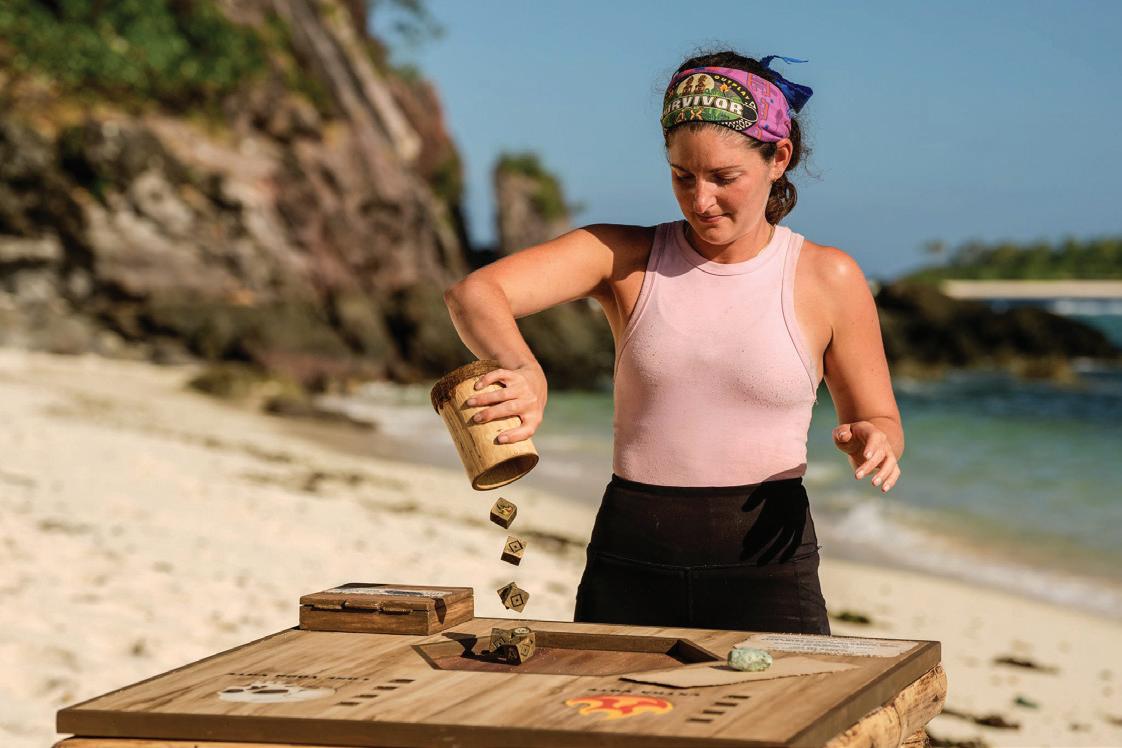
Roses told The Diamondback she decided to apply as a contestant for Survivor two years ago after leaving her public relations job, starting her own business and moving from Manhattan, New York to Arlington, Virginia with her now-fiance.
“There was just a lot of risks that I was taking,” she said. “And I was like, ‘Why have I never applied for Survivor?’ Quitting my job is way more risky than sending in an application for Survivor.”
Roses said the competition, which lasted her 11 days out of the possible 26, tested both her physical and emotional limits.
But she also made countless memories with her competitors, an element of the experience that surprised her, she added.
“I made lifelong friends, and I did not go on this show to make friends,” she said. “I’m so grateful.”
earning a bachelor’s degree in communication with a Spanish minor.
Members of this university’s Survivor Maryland club, which runs semester-long competitions modeled after the CBS series where students can participate in challenges to win the title of “Sole Survivor,” said they were excited to find out about Roses’ connection to this university.
“We were all rooting for her from the beginning,” said Julia Ciurleo, a sophomore real estate and the built environment major who served on the club’s executive board this fall.
Senior criminology and criminal justice major Marissa Jarrett, Survivor Maryland’s community and recruitment chair, said she drafted Roses as a pick in her family’s seasonal Survivor bracket.
She loved watching Roses and Krottinger strategize together, she added.
“It’s really cool just seeing all the opportunities that people from [this university] get to do later on in life,” she said.
Roses said she attributes her “love for communication and relationship building,” skills she used while playing the social game of Survivor, to her time at this university and the activities she was involved with.
She also expressed enthusiasm for the concept of the Survivor Maryland club.
Founded in 2012, Survivor Maryland was the first o cial collegiate branch of the show and is recognized by CBS, according to the club’s description on TerpLink.
Both Jarrett and Ciurleo said they have made some of their best friends through the club — even though everyone is competing against each other.
“It’s such a niche interest, but it’s such a big community, and I think that’s why we love it so much,” Jarrett said.
Students can now apply to play in next semester’s Survivor Maryland game by filling out a form linked on the organization’s Instagram page. Roses encouraged them to take a risk and send in an application for the CBS show.
“Don’t let fear hold you back,” Roses said. “Don’t overthink it, and just show who you are authentically.”

